What DALL-E 2 can and cannot do
I got access to DALL-E 2 earlier this week, and have spent the last few days (probably adding up to dozens of hours) playing with it, with the goal of mapping out its performance in various areas – and, of course, ending up with some epic art.
Below, I’ve compiled a list of observations made about DALL-E, along with examples. If you want to request art of a particular scene, or to test see what a particular prompt does, feel free to comment with your requests.
DALL-E’s strengths
Stock photography content
It’s stunning at creating photorealistic content for anything that (this is my guess, at least) has a broad repertoire of online stock images – which is perhaps less interesting because if I wanted a stock photo of (rolls dice) a polar bear, Google Images already has me covered. DALL-E performs somewhat better at discrete objects and close-up photographs than at larger scenes, but it can do photographs of city skylines, or National Geographic-style nature scenes, tolerably well (just don’t look too closely at the textures or detailing.) Some highlights:
Clothing design: DALL-E has a reasonable if not perfect understanding of clothing styles, and especially for women’s clothes and with the stylistic guidance of “displayed on a store mannequin” or “modeling photoshoot” etc, it can produce some gorgeous and creative outfits. It does especially plausible-looking wedding dresses – maybe because wedding dresses are especially consistent in aesthetic, and online photos of them are likely to be high quality?
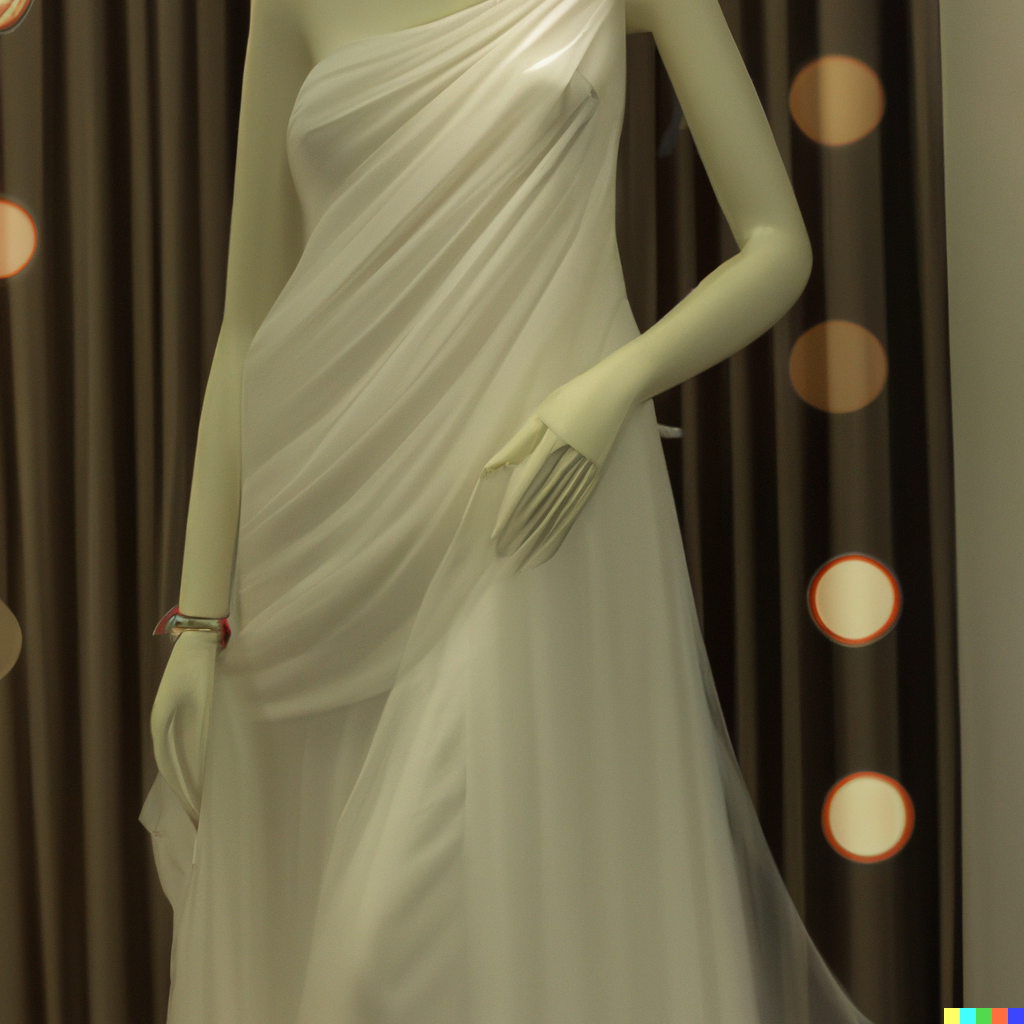
Close-ups of cute animals. DALL-E can pull off scenes with several elements, and often produce something that I would buy was a real photo if I scrolled past it on Tumblr.
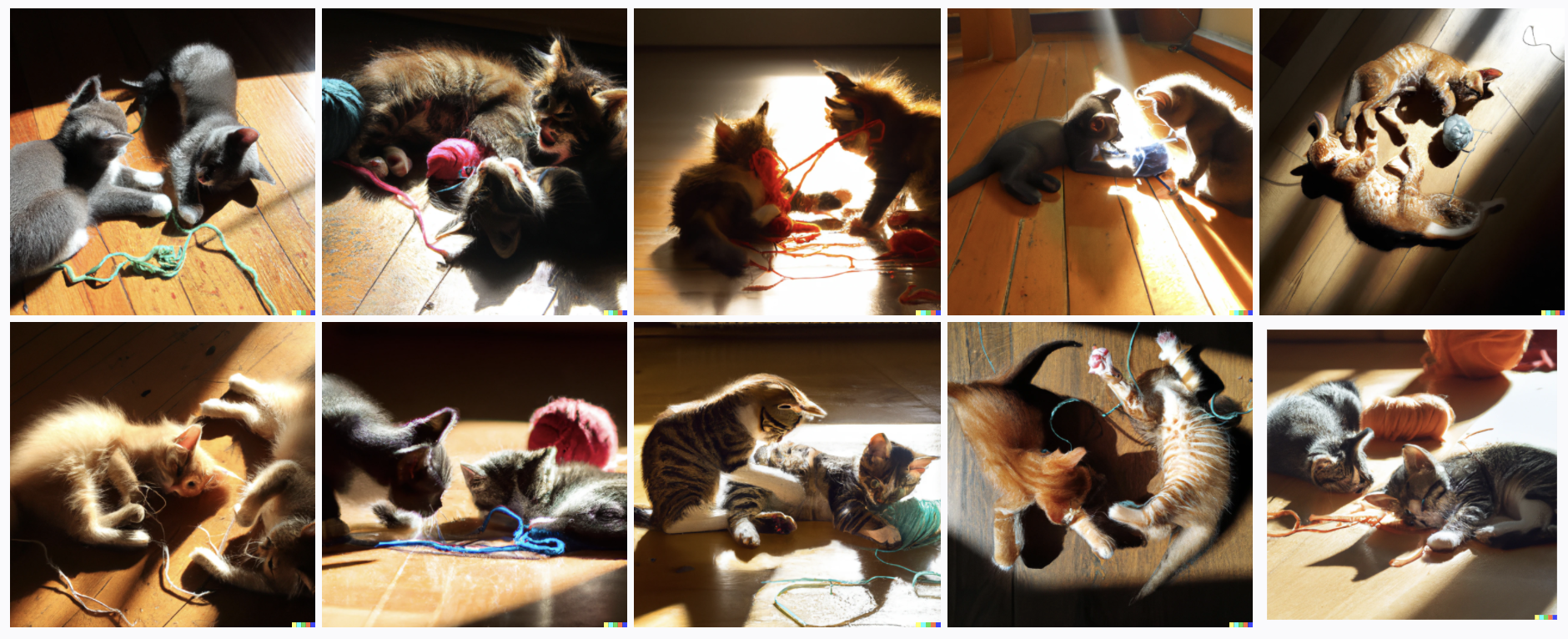
Close-ups of food. These can be a little more uncanny valley – and I don’t know what’s up with the apparent boiled eggs in there – but DALL-E absolutely has the plating style for high-end restaurants down.
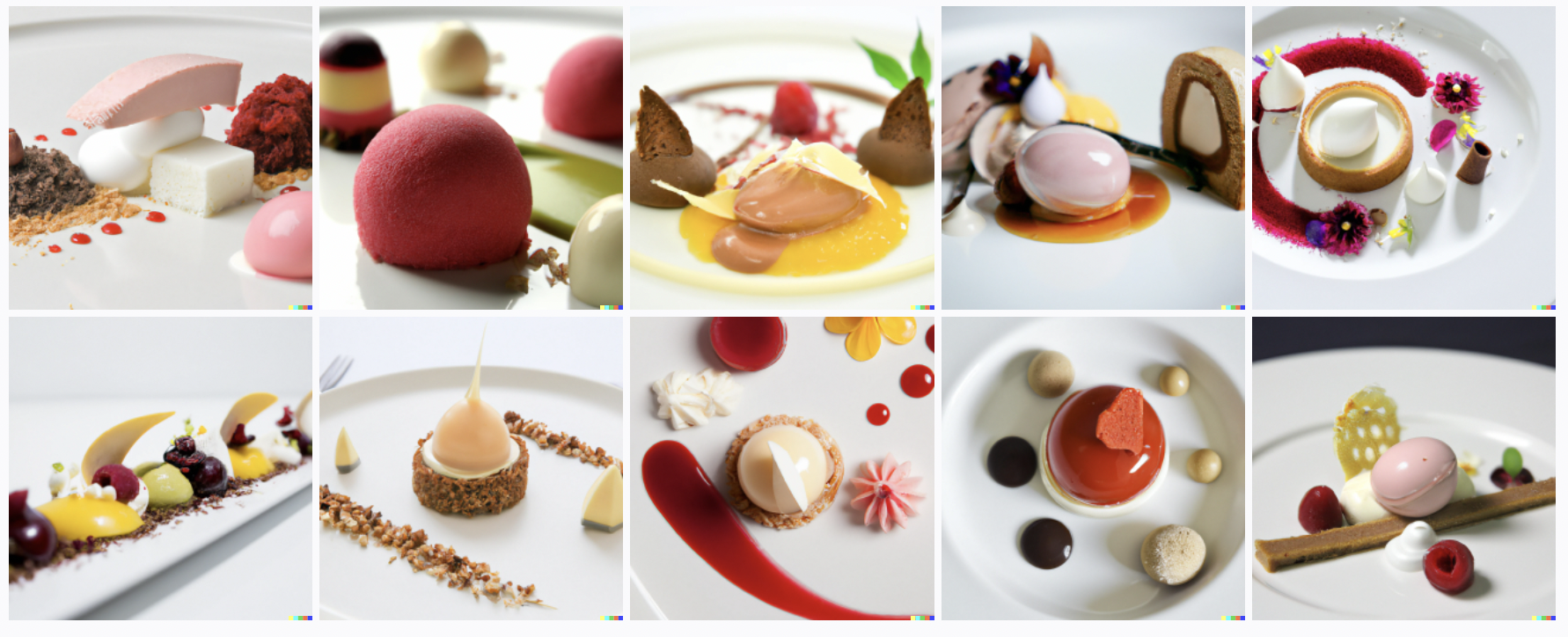
Jewelry. DALL-E doesn’t always follow the instructions of the prompt exactly (it seems to be randomizing whether the big pendant is amber or amethyst) but the details are generally convincing and the results are almost always really pretty.
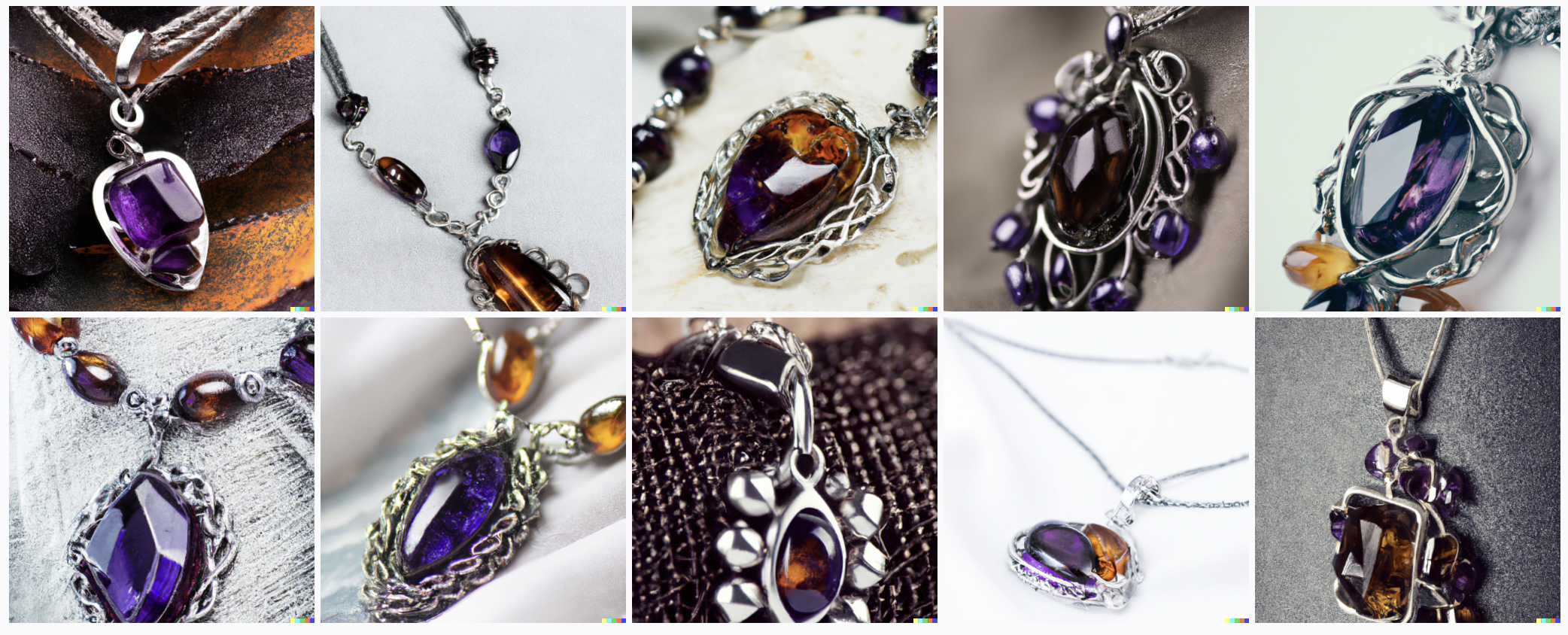
Pop culture and media
DALL-E “recognizes” a wide range of pop culture references, particularly for visual media (it’s very solid on Disney princesses) or for literary works with film adaptations like Tolkien’s LOTR. For almost all media that it recognizes at all, it can convert it in almost-arbitrary art styles.
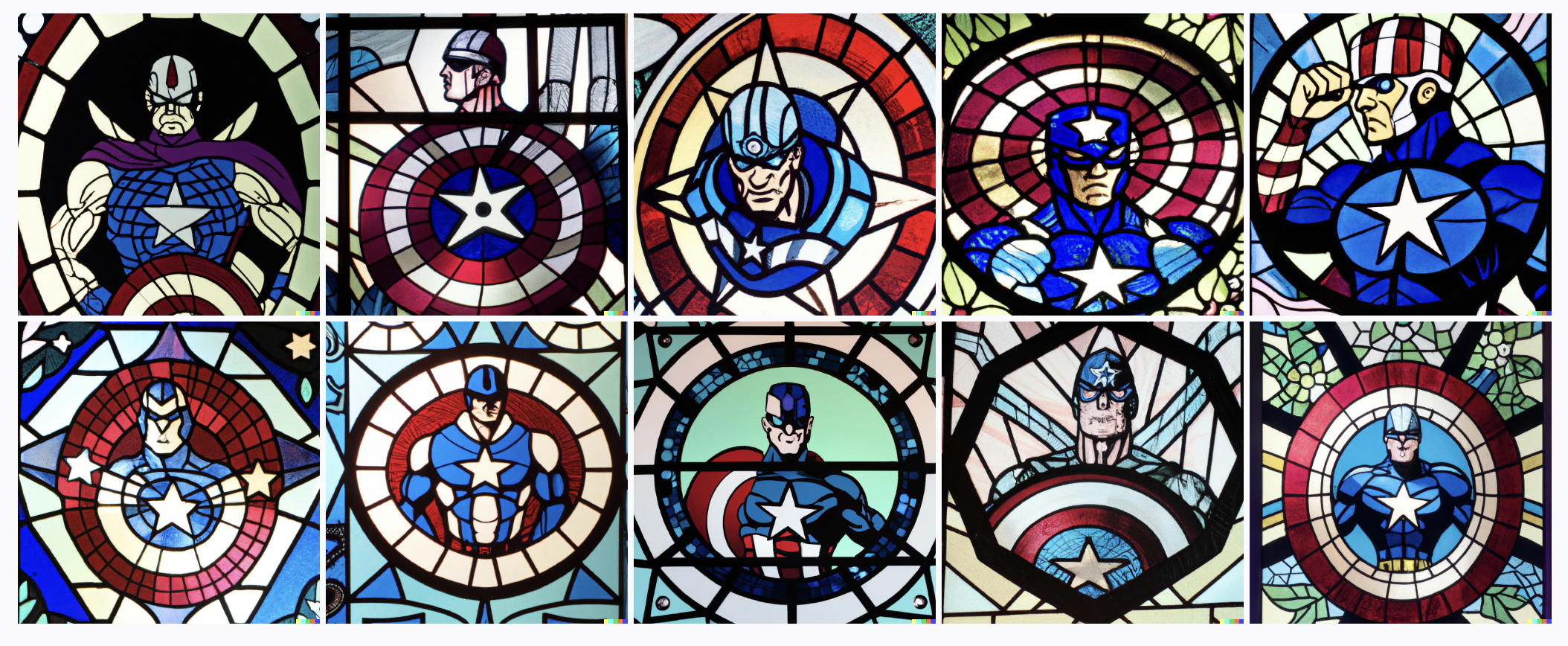
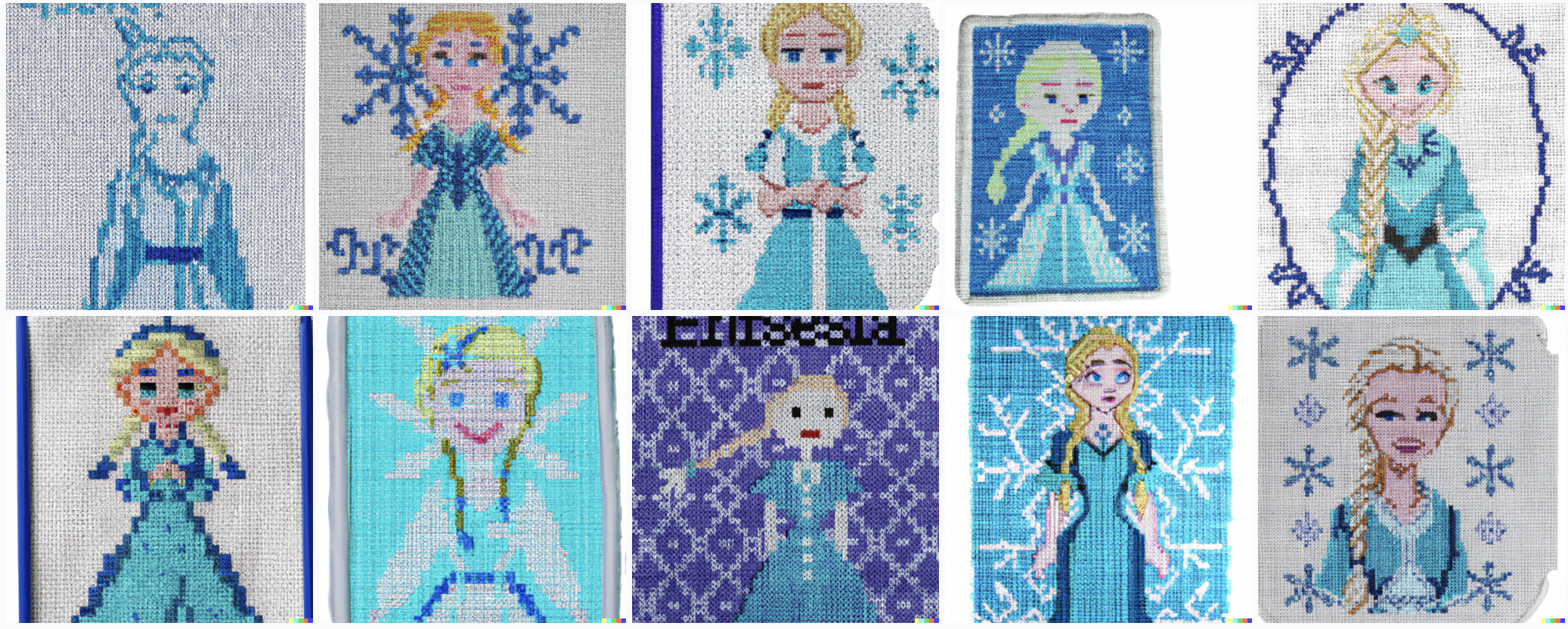
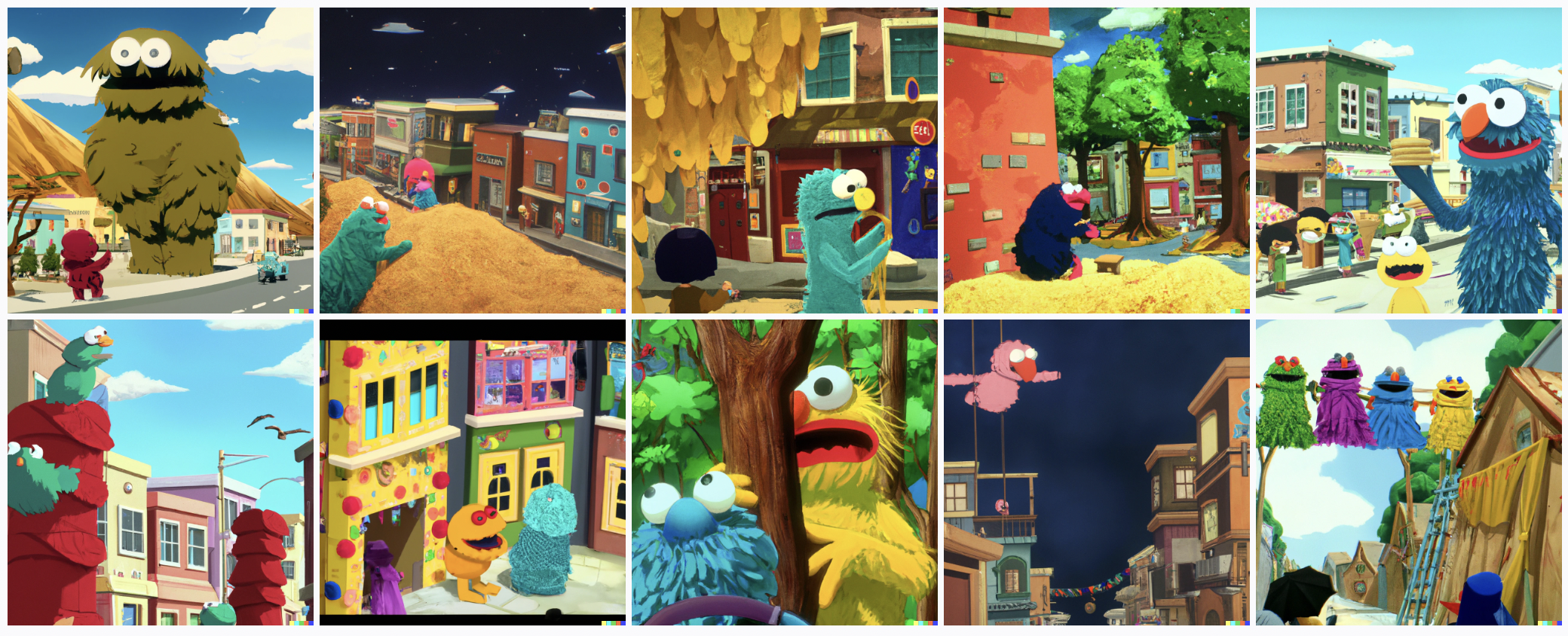
[Tip: I find I get more reliably high-quality images from the prompt “X, screenshots from the Miyazaki anime movie” than just “in the style of anime”, I suspect because Miyazaki has a consistent style, whereas anime more broadly is probably pulling in a lot of poorer-quality anime art.]
Art style transfer
Some of most impressively high-quality output involves specific artistic styles. DALL-E can do charcoal or pencil sketches, paintings in the style of various famous artists, and some weirder stuff like “medieval illuminated manuscripts”.
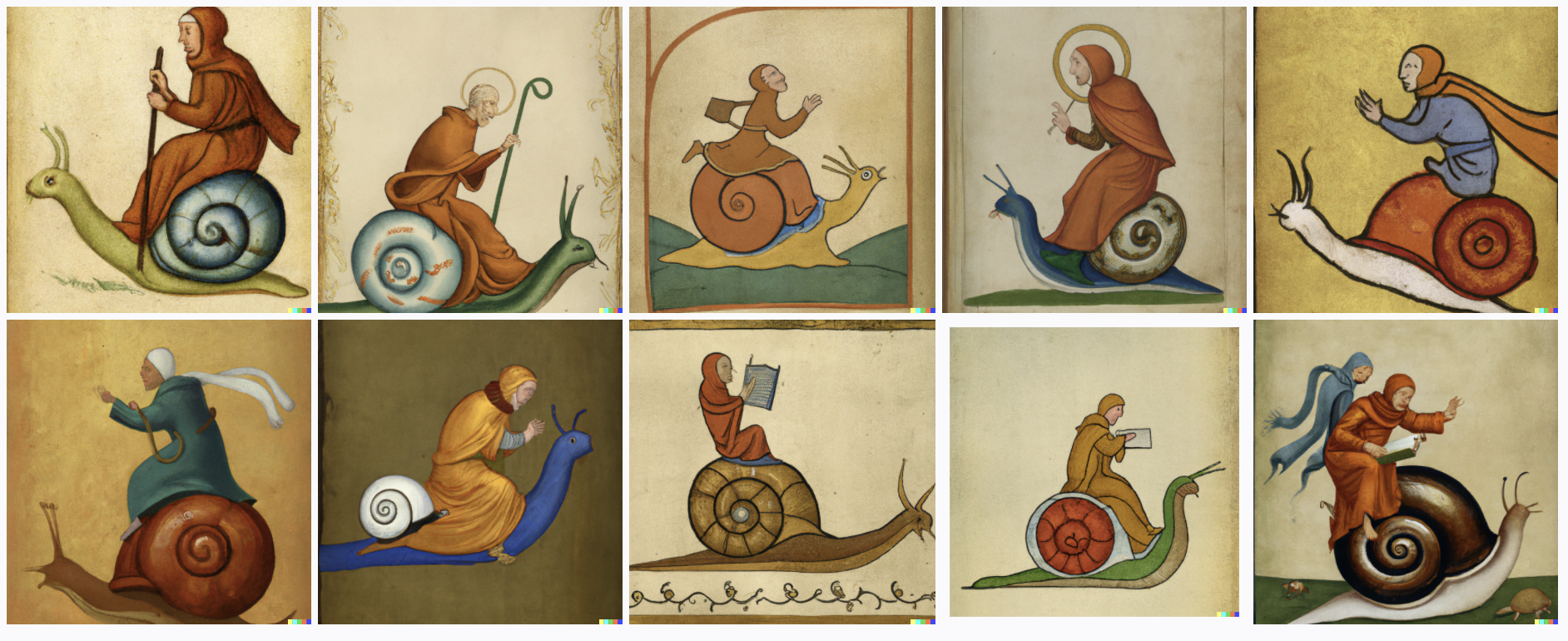
IMO it performs especially well with art styles like “impressionist watercolor painting” or “pencil sketch”, that are a little more forgiving around imperfections in the details.
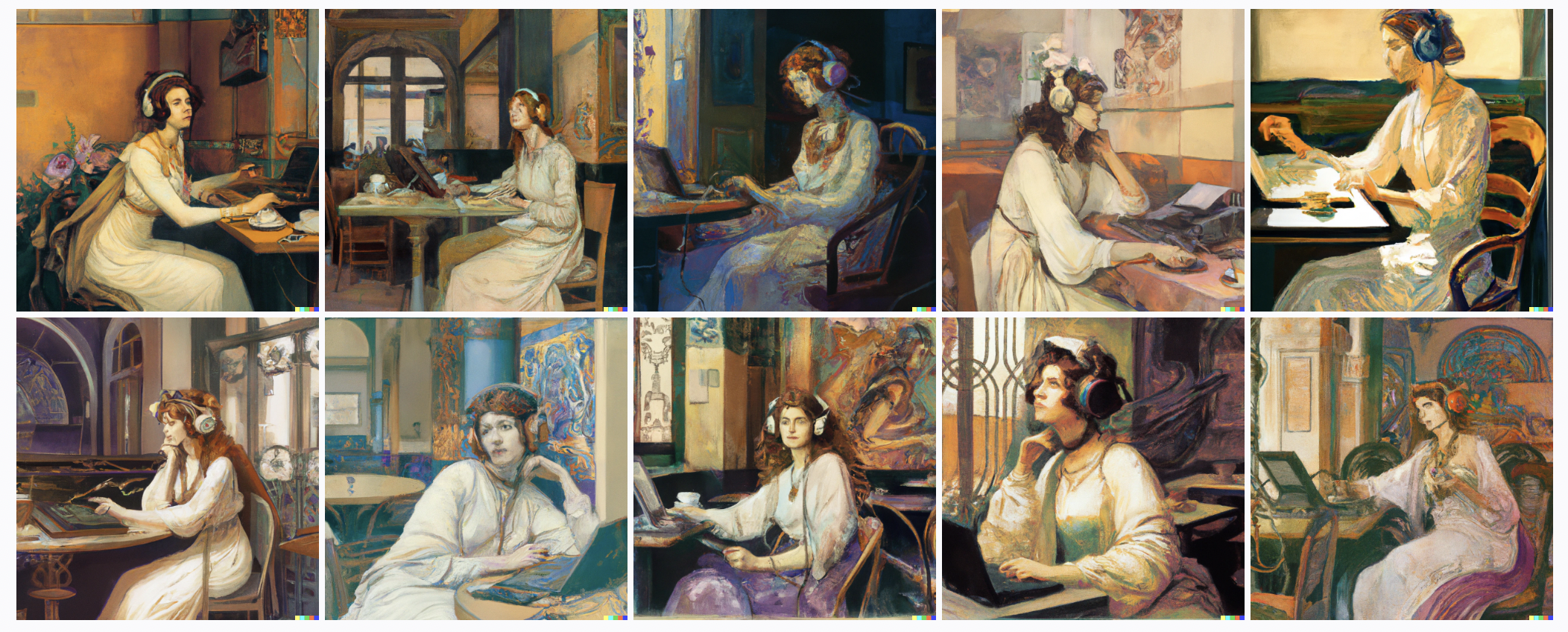
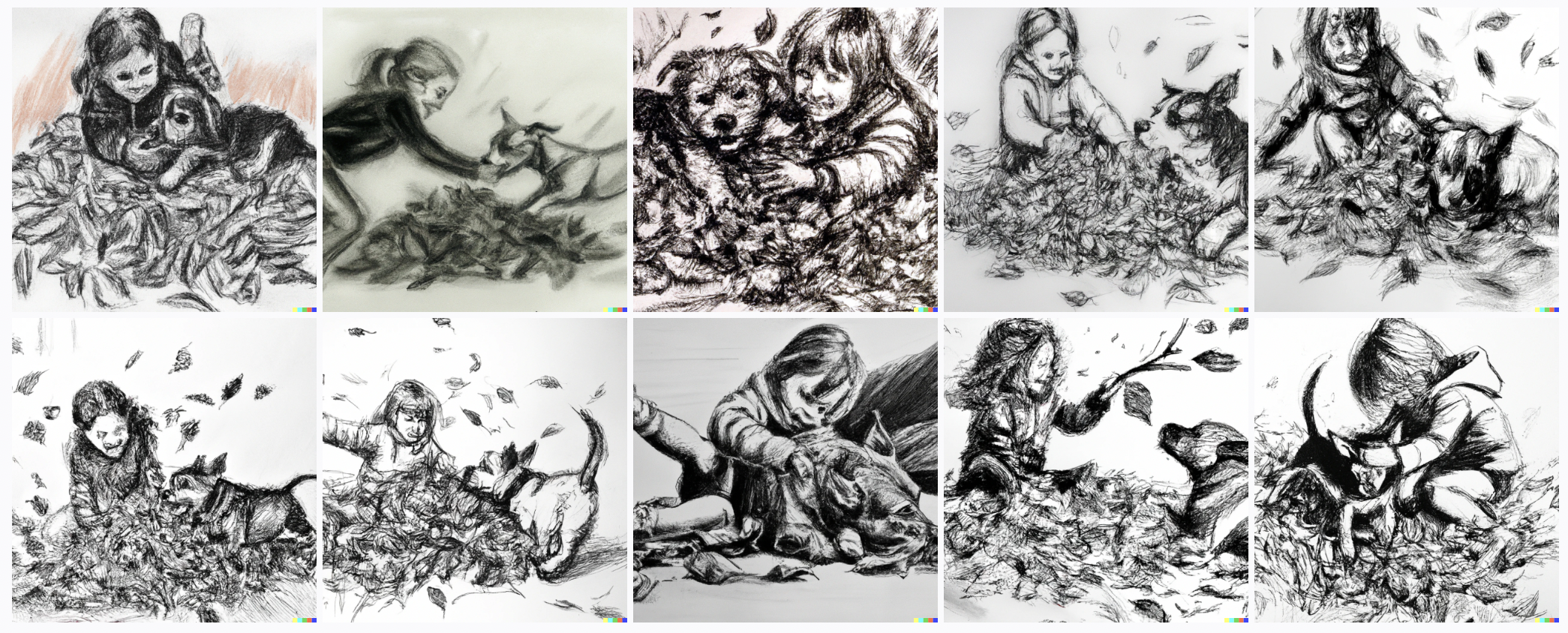
Creative digital art
DALL-E can (with the right prompts and some cherrypicking) pull off some absolutely gorgeous fantasy-esque art pieces. Some examples:
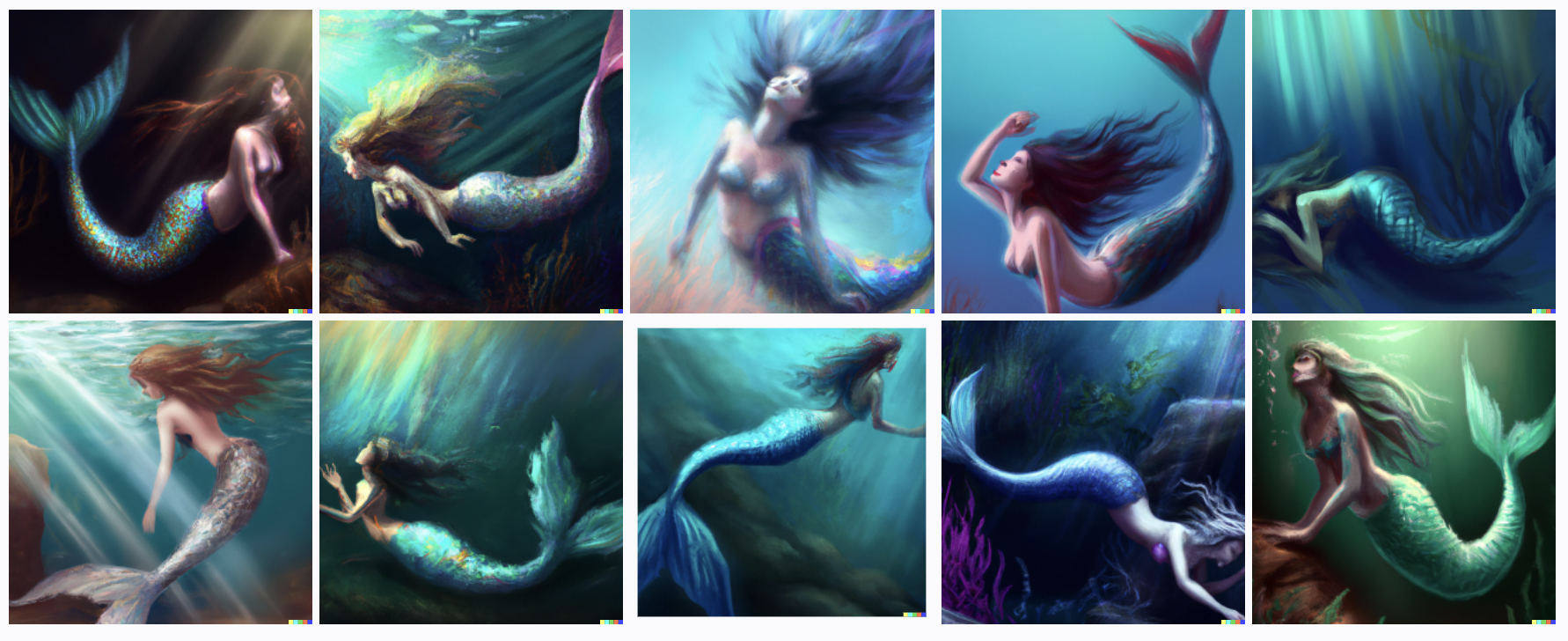
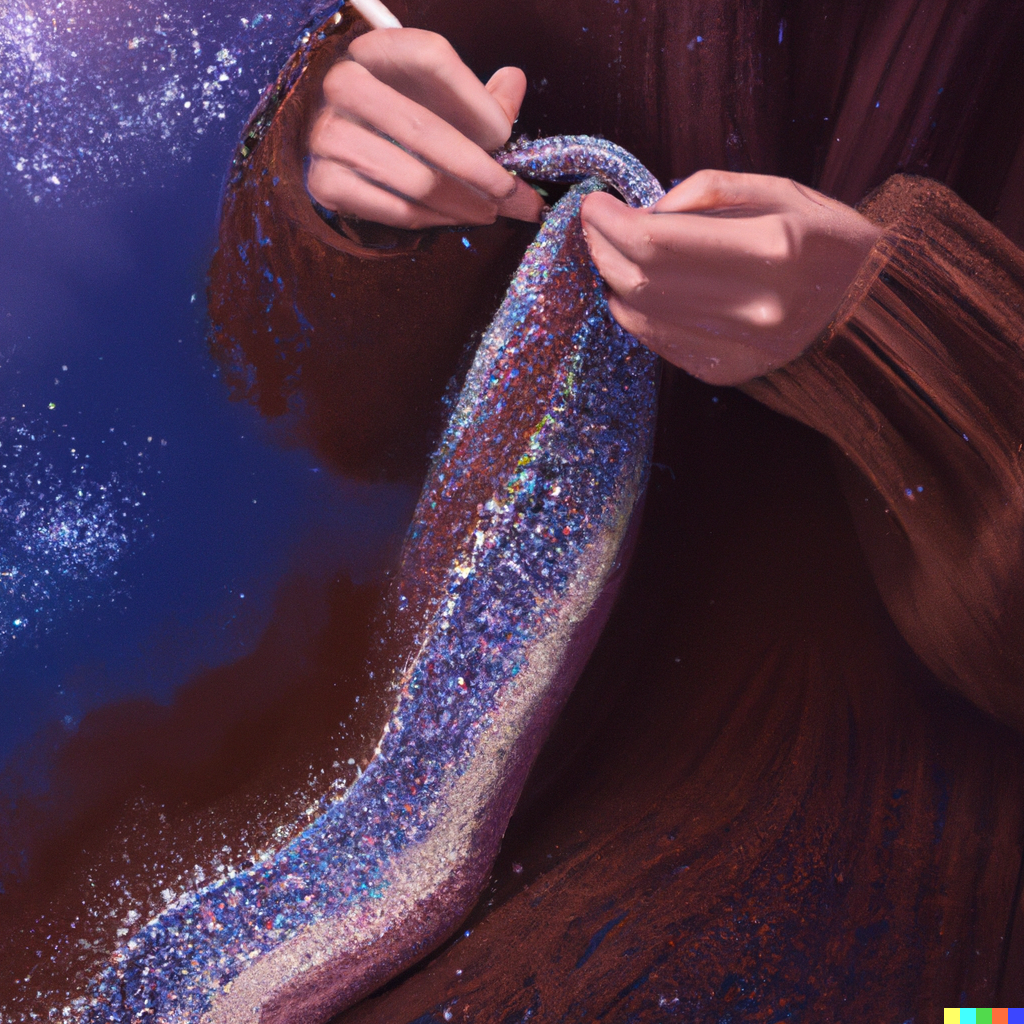
The output when putting in more abstract prompts (I’ve run a lot of “[song lyric or poetry line], digital art” requests) is hit-or-miss, but with patience and some trial and error, it can pull out some absolutely stunning – or deeply hilarious – artistic depictions of poetry or abstract concepts. I kind of like using it in this way because of the sheer variety; I never know where it’s going to go with a prompt.
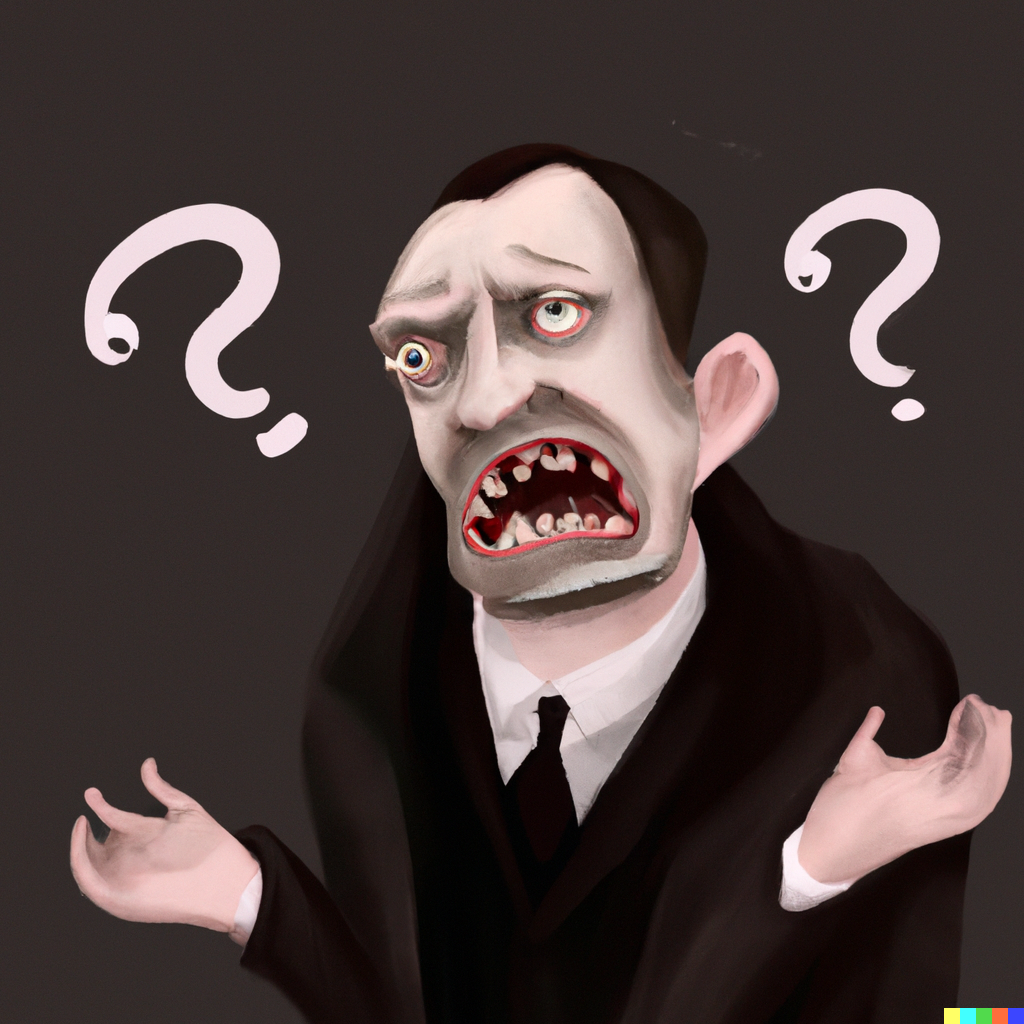
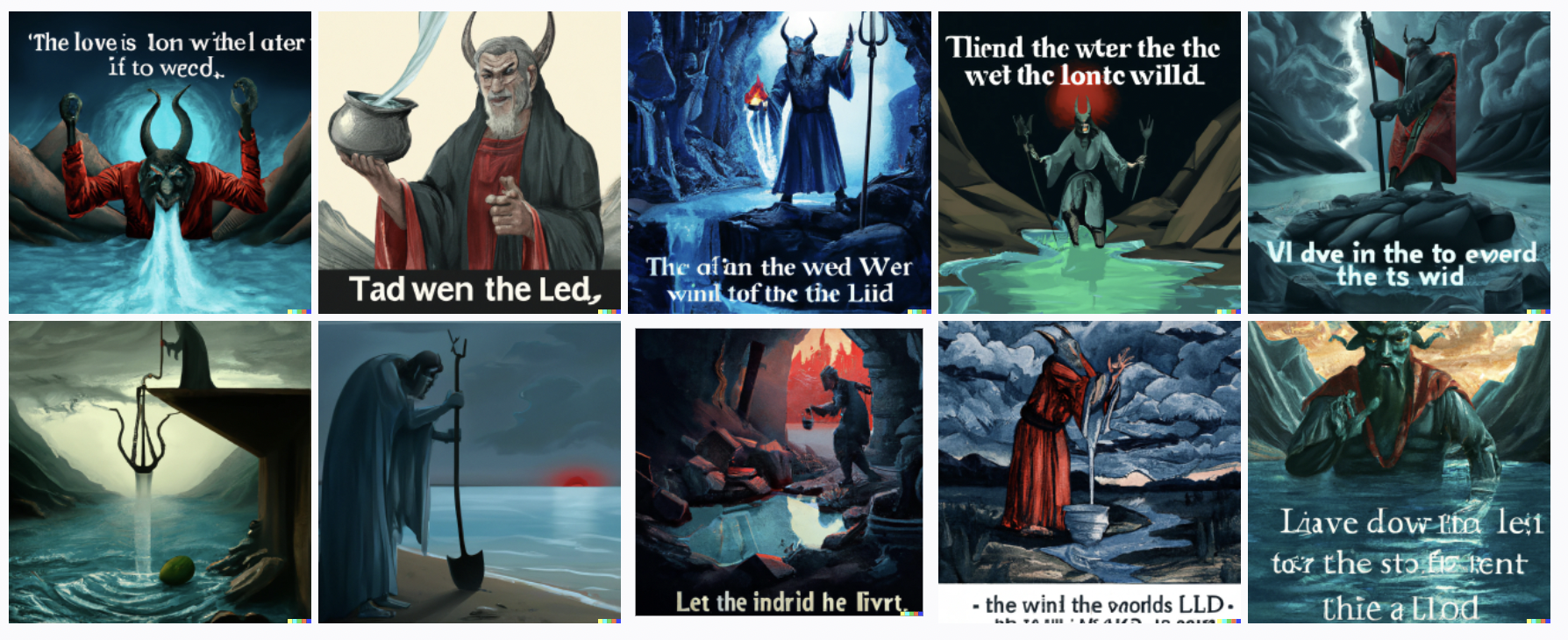
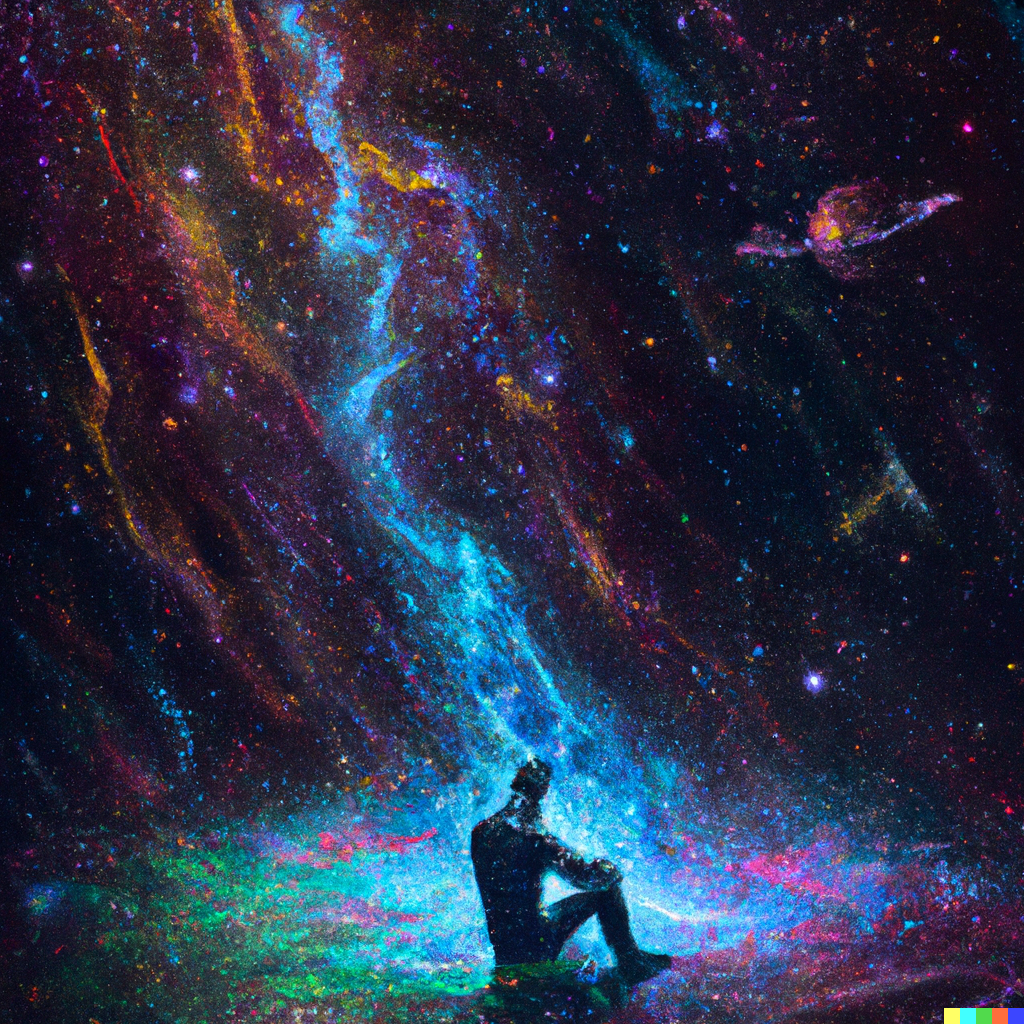
The future of commercials
This might be just a me thing, but I love almost everything DALL-E does with the prompt “in the style of surrealism” – in particular, its surreal attempt at commercials or advertisements. If my online ads were 100% replaced by DALL-E art, I would probably click on at least 50% more of them.
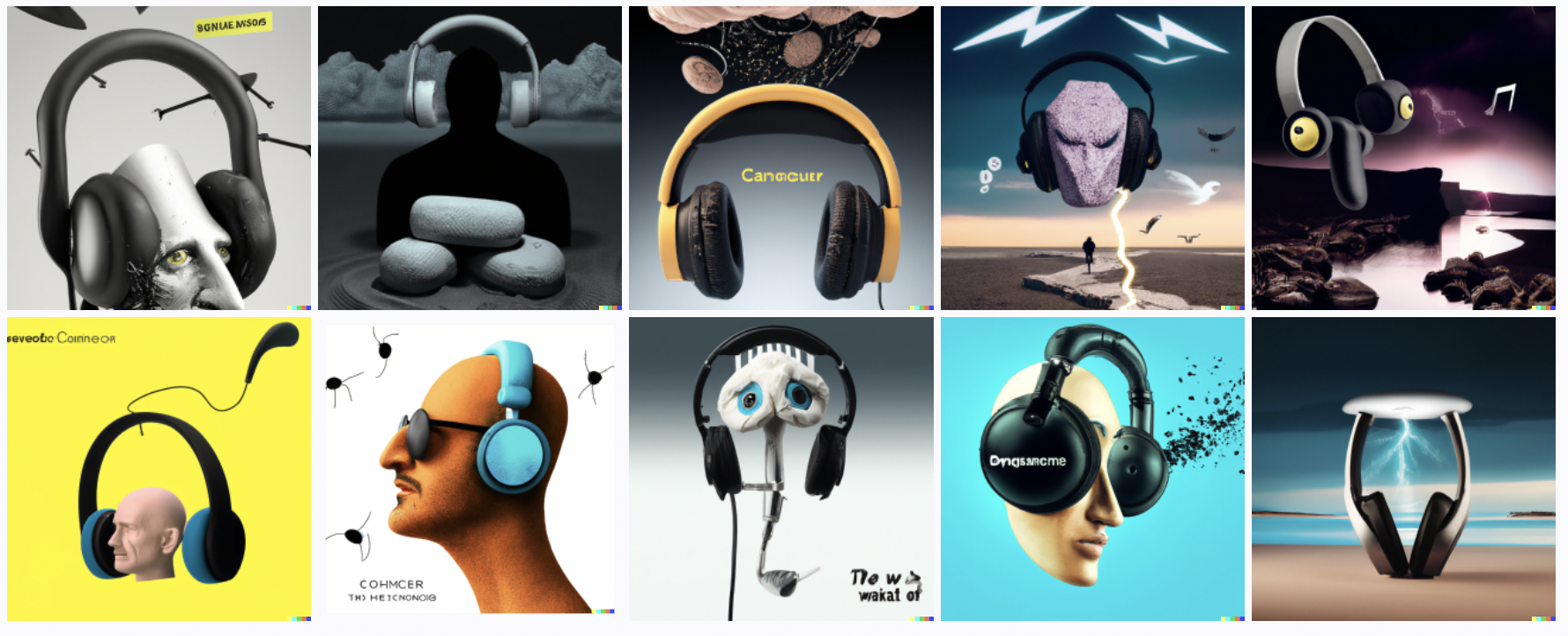
DALLE’s weaknesses
I had been really excited about using DALL-E to make fan art of fiction that I or other people have written, and so I was somewhat disappointed at how much it struggles to do complex scenes according to spec. In particular, it still has a long way to go with:
Scenes with two characters
I’m not kidding. DALL-E does fine at giving one character a list of specific traits (though if you want pink hair, watch out, DALL-E might start spamming the entire image with pink objects). It can sometimes handle multiple generic people in a crowd scene, though it quickly forgets how faces work. However, it finds it very challenging to keep track of which traits ought to belong to a specific Character A versus a different specific Character B, beyond a very basic minimum like “a man and a woman.”
The above is one iteration of a scene I was very motivated to figure out how to depict, as a fan art of my Valdemar rationalfic. DALL-E can handle two people, check, and a room with a window and at least one of a bed or chair, but it’s lost when it comes to remembering which combination of age/gender/hair color is in what location.
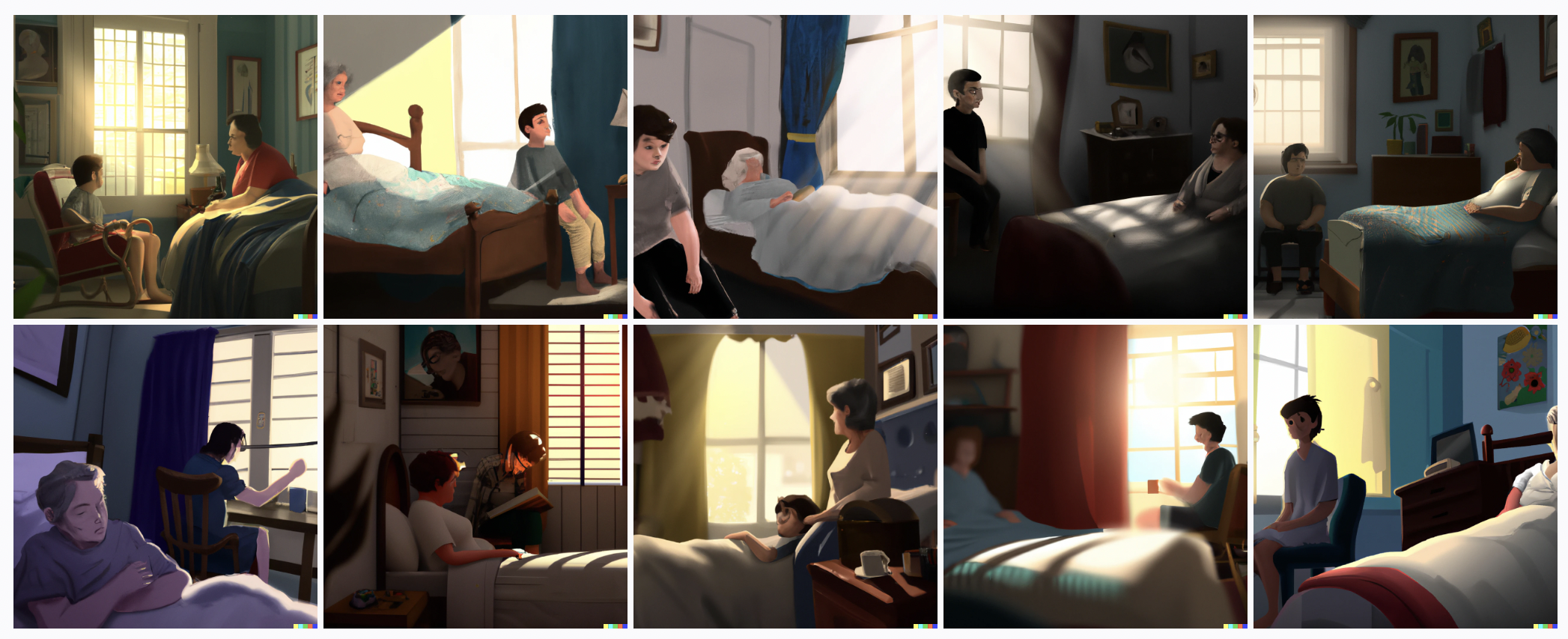
Even in cases where the two characters are pop culture references that I’ve already been able to confirm the model “knows” separately – for example, Captain America and Iron Man – it can’t seem to help blending them together. It’s as though the model has “two characters” and then separately “a list of traits” (user-specified or just implicit in the training data), and reassigns the traits mostly at random.
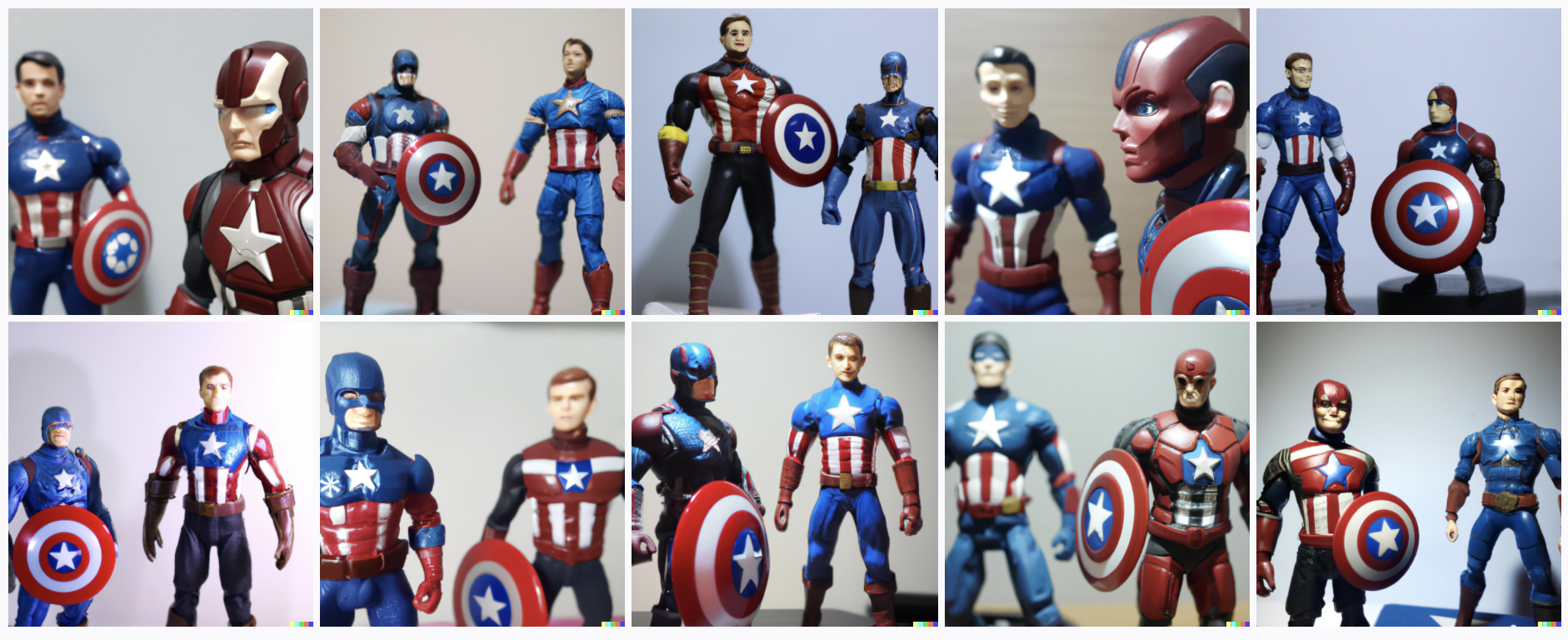
Foreground and background
A good example of this: someone on Twitter had commented that they couldn’t get DALL-E to provide them with “Two dogs dressed like roman soldiers on a pirate ship looking at New York City through a spyglass”. I took this as a CHALLENGE and spent half an hour trying; I, too, could not get DALL-E to output this, and end up needing to choose between “NYC and a pirate ship” or “dogs in Roman soldier uniforms with spyglasses”.
DALL-E can do scenes with generic backgrounds (a city, bookshelves in a library, a landscape) but even then, if that’s not the main focus of the image then the fine details tend to get pretty scrambled.
Novel objects, or nonstandard usages
Objects that are not something it already “recognizes.” DALL-E knows what a chair is. It can give you something that is recognizably a chair in several dozen different art mediums. It could not with any amount of coaxing produce an “Otto bicycle”, which my friend specifically wanted for her book cover. Its failed attempts were both hilarious and concerning.
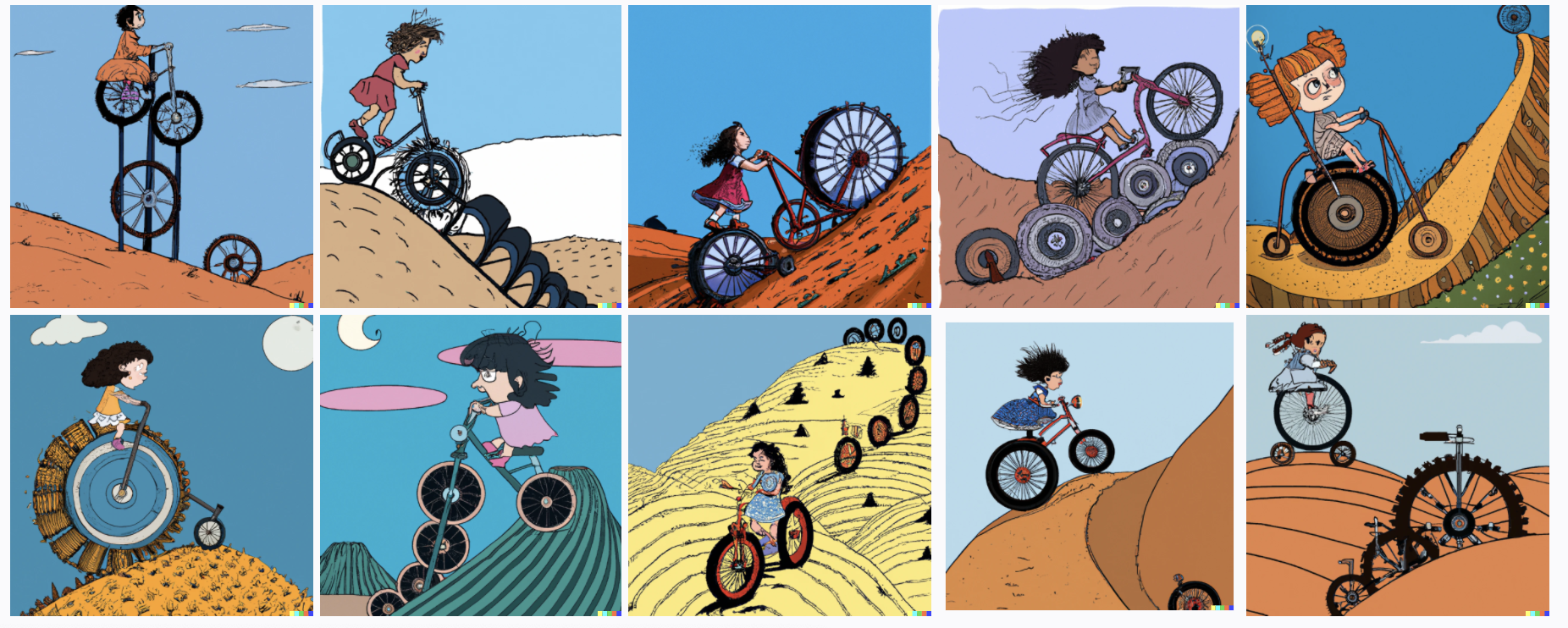

Objects used in nonstandard ways. It seems to slide back toward some kind of ~prior; when I asked it for a dress made of Kermit plushies displayed on a store mannequin, it repeatedly gave me a Kermit plushie wearing a dress.
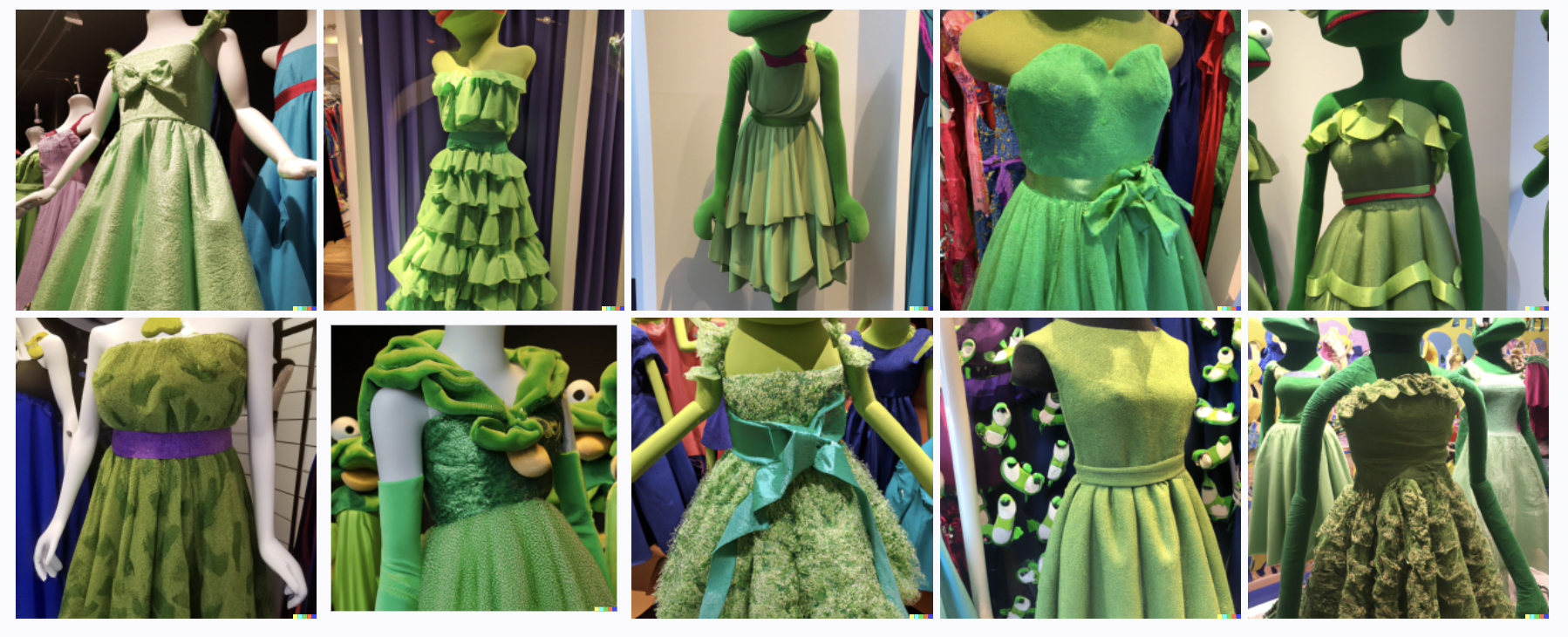
DALL-E generally seems to have extremely strong priors in a few areas, which end up being almost impossible to shift. I spent at least half an hour trying to convince it to give me digital art of a woman whose eyes were full of stars (no, not the rest of her, not the background scenery either, just her eyes...) and the closest DALL-E ever got was this.
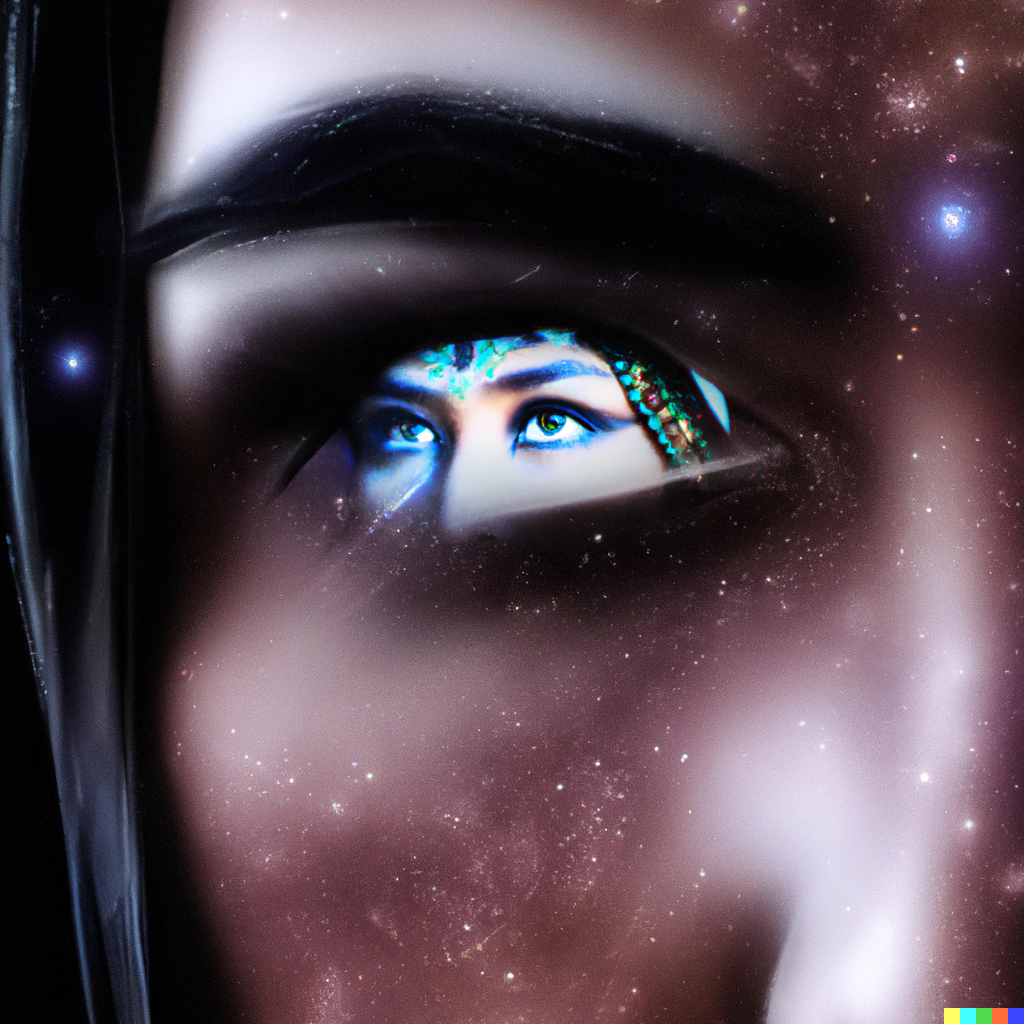
I got: the goddess-eyed goddess of recursion
Spelling
DALL-E can’t spell. It really really cannot spell. It will occasionally spell a word correctly by utter coincidence. (Okay, fine, it can consistently spell “STOP” as long as it’s written on a stop sign.)
It does mostly produce recognizable English letters (and recognizable attempts at Chinese calligraphy in other instances), and letter order that is closer to English spelling than to a random draw from a bag of Scrabble letters, so I would guess that even given the new model structure that makes DALL-E 2 worse than the first DALL-E, just scaling it up some would eventually let it crack spelling.
At least sometimes its inability to spell results in unintentionally hilarious memes?
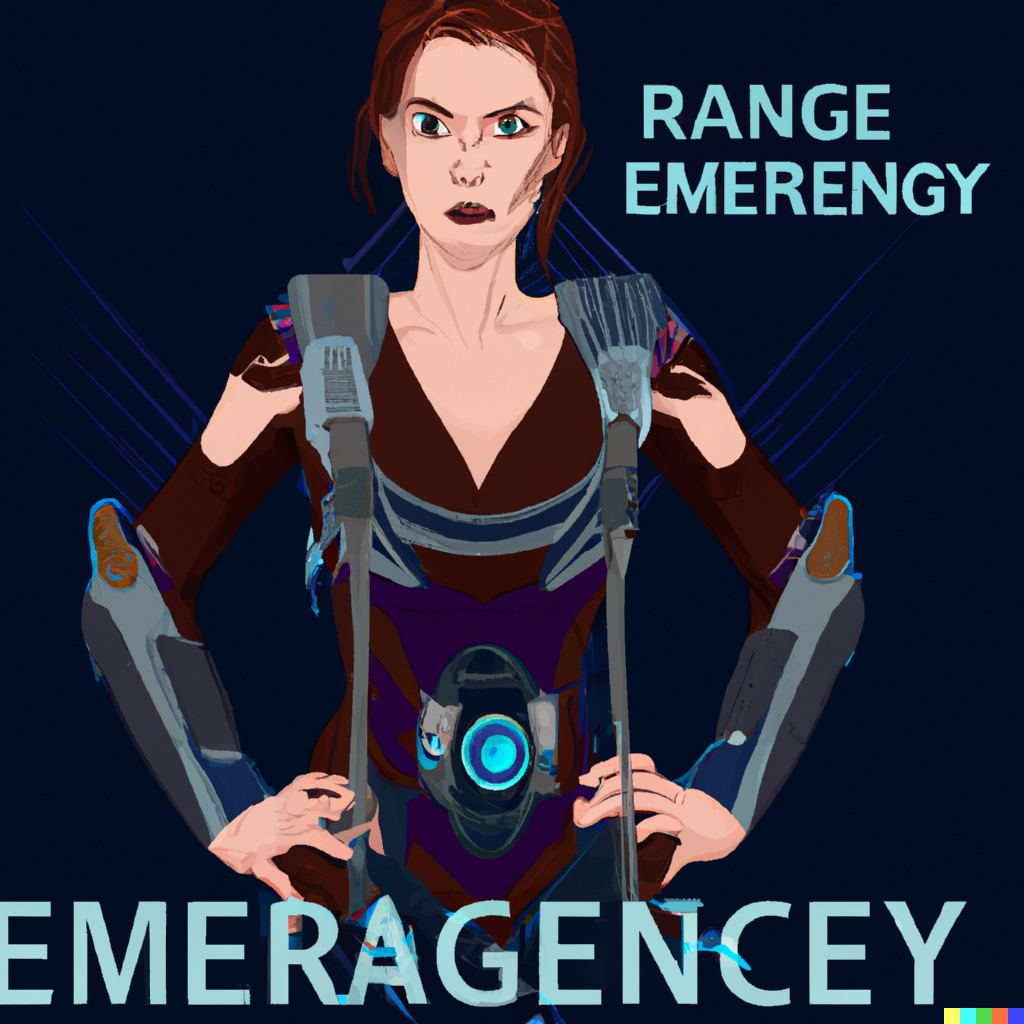
Realistic human faces
My understanding is that the face model limitation may have been deliberate to avoid deepfakes of celebrities, etc. Interestingly, DALL-E can nonetheless at least sometimes do perfectly reasonable faces, either as photographs or in various art styles, if they’re the central element of a scene. (And it keeps giving me photorealistic faces as a component of images where I wasn’t even asking for that, meaning that per the terms and conditions I can’t share those images publicly.)
Even more interestingly, it seems to specifically alter the appearance of actors even when it clearly “knows” a particular movie or TV show. I asked it for “screenshots from the second season of Firefly”, and they were very recognizably screenshots from Firefly in terms of lighting, ambiance, scenery etc, with an actor who looked almost like Nathan Fillion – as though cast in a remake that was trying to get it fairly similar – and who looked consistently the same across all 10 images, but was definitely a different person.
There are a couple of specific cases where DALL-E seems to “remember” how human hands work. The ones I’ve found so far mostly involve a character doing some standard activity using their hands, like “playing a musical instrument.” Below, I was trying to depict a character from A Song For Two Voices who’s a Bard; this round came out shockingly good in a number of ways, but the hands particularly surprised me.
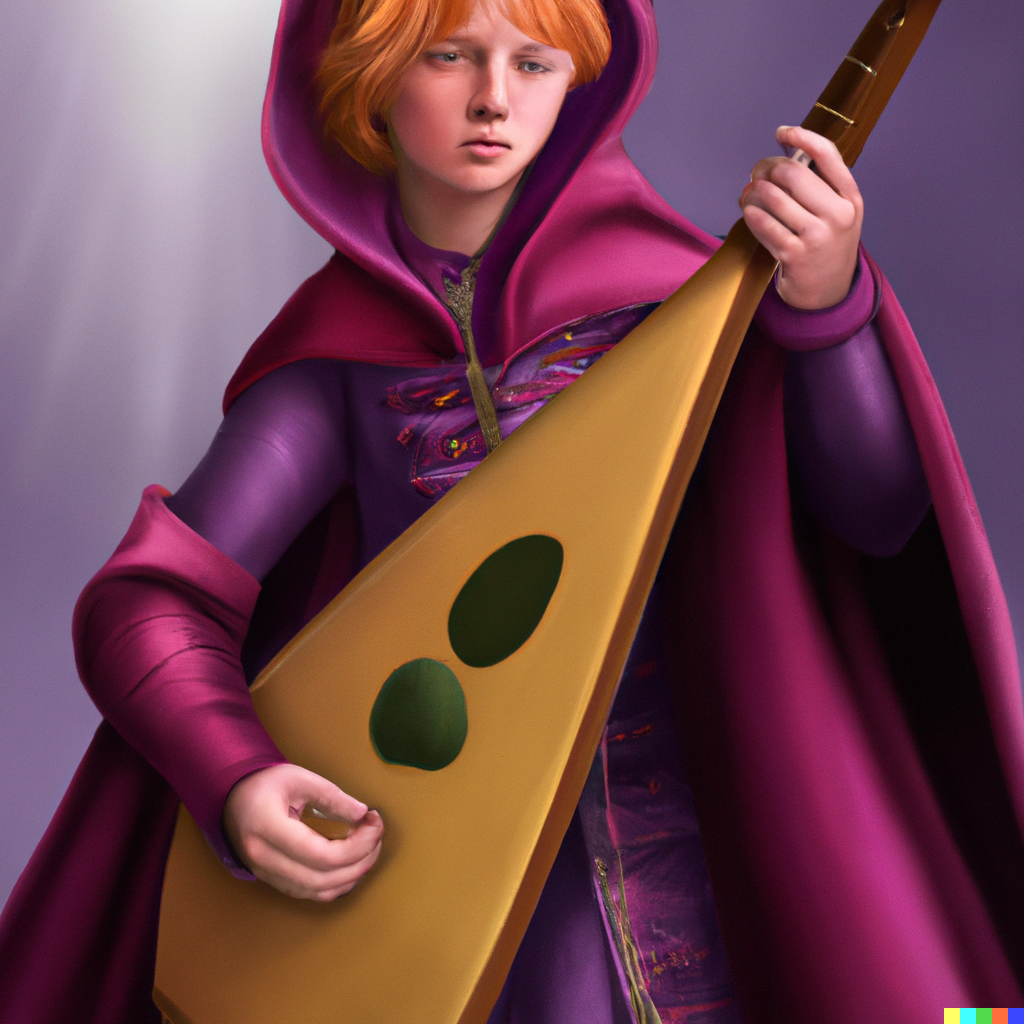
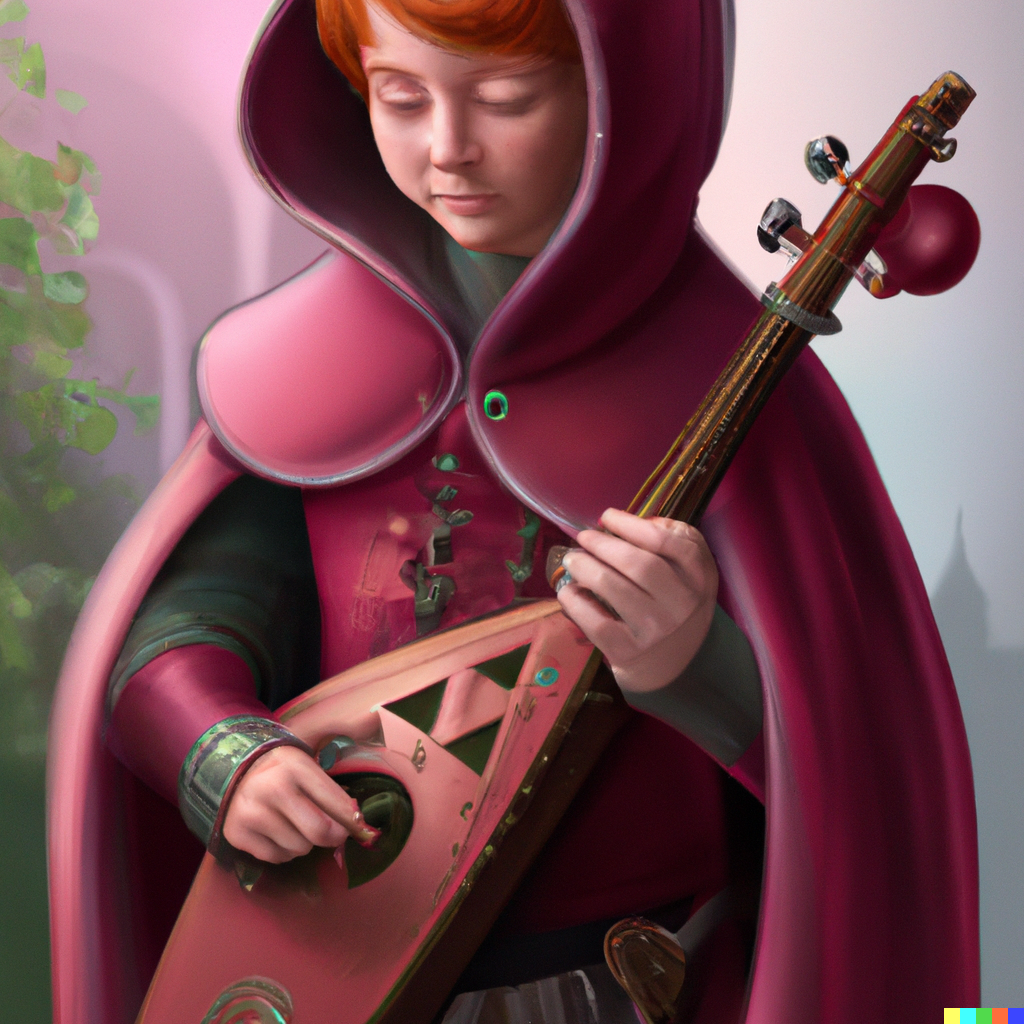
Limitations of the “edit” functionality
DALL-E 2 offers an edit functionality – if you mostly like an image except for one detail, you can highlight an area of it with a cursor, and change the full description as applicable in order to tell it how to modify the selected region.
It sometimes works—this gorgeous dress (didn’t save the prompt, sorry) originally had no top, and the edit function successfully added one without changing the rest too much.
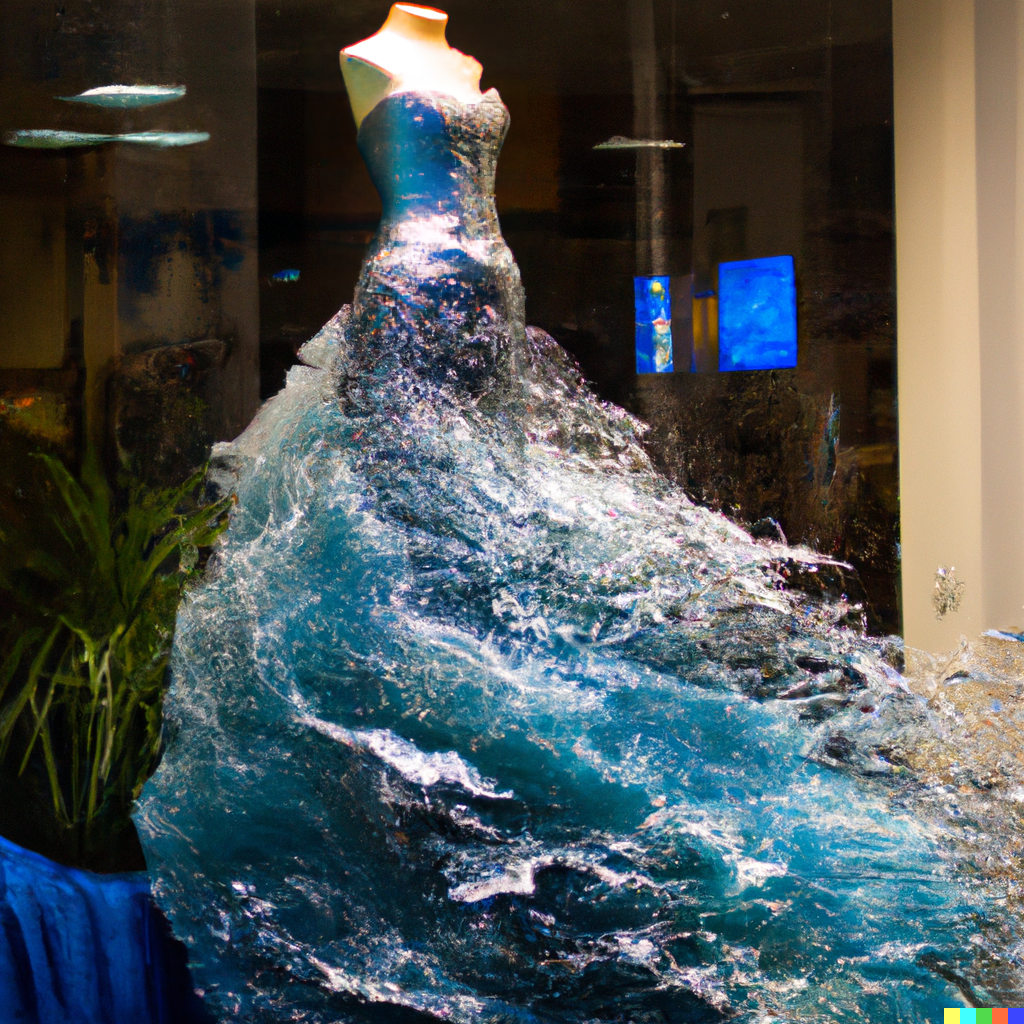
It often appears to do nothing. It occasionally full-on panics and does....whatever this is.
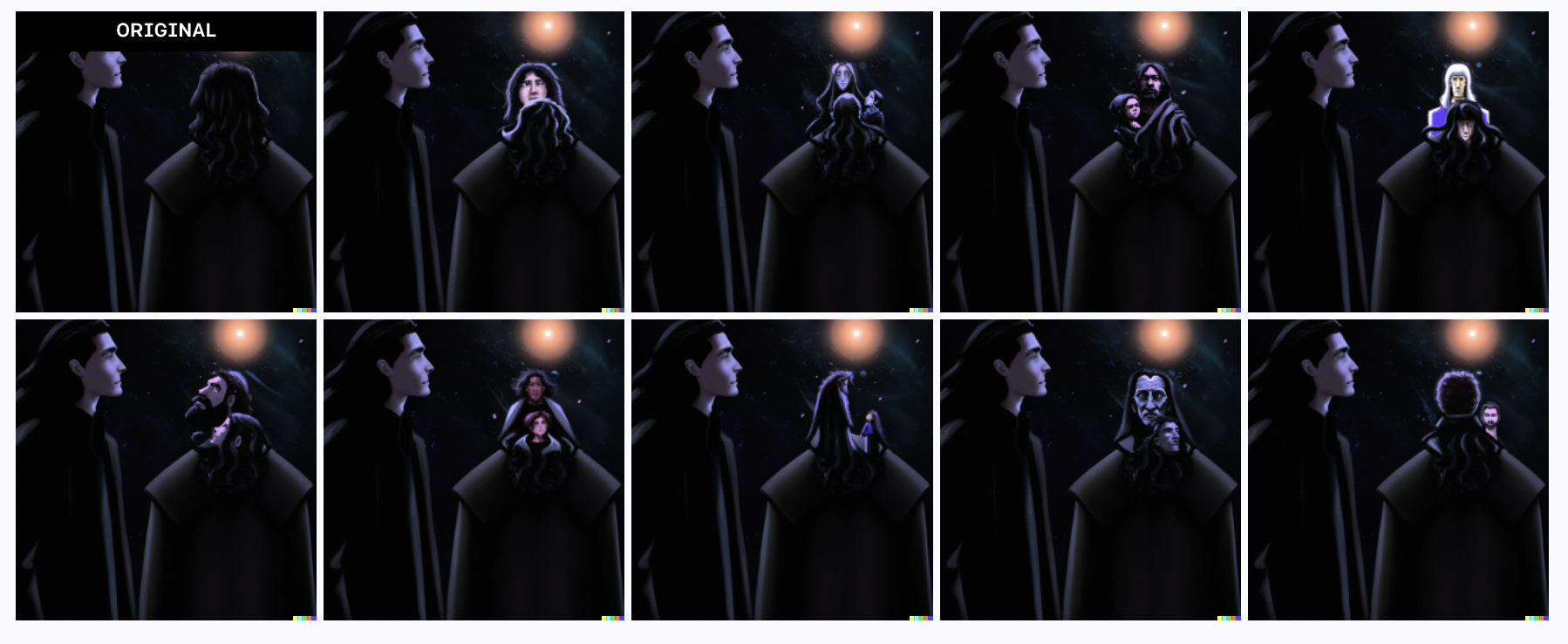
There’s also a “variations” functionality that lets you select the best image given by a prompt and generate near neighbors of it, but my experience so far is that the variations are almost invariably less of a good fit for the original prompt, and very rarely better on specific details (like faces) that I might want to fix.
Some art style observations
DALL-E doesn’t seem to hold a sharp delineation between style and content; in other words, adding stylistic prompts actively changes the some of what I would consider to be content.
For example, asking for a coffeeshop scene as painted by Alphonse Mucha puts the woman in in a long flowing period-style dress, like in this reference painting, and gives us a “coffeeshop” that looks a lot to me like a lady’s parlor; in comparison, the Miyazaki anime version mostly has the character in a casual sweatshirt. This makes sense given the way the model was trained; background details are going to be systematically different between Nouveau Art paintings and anime movies.
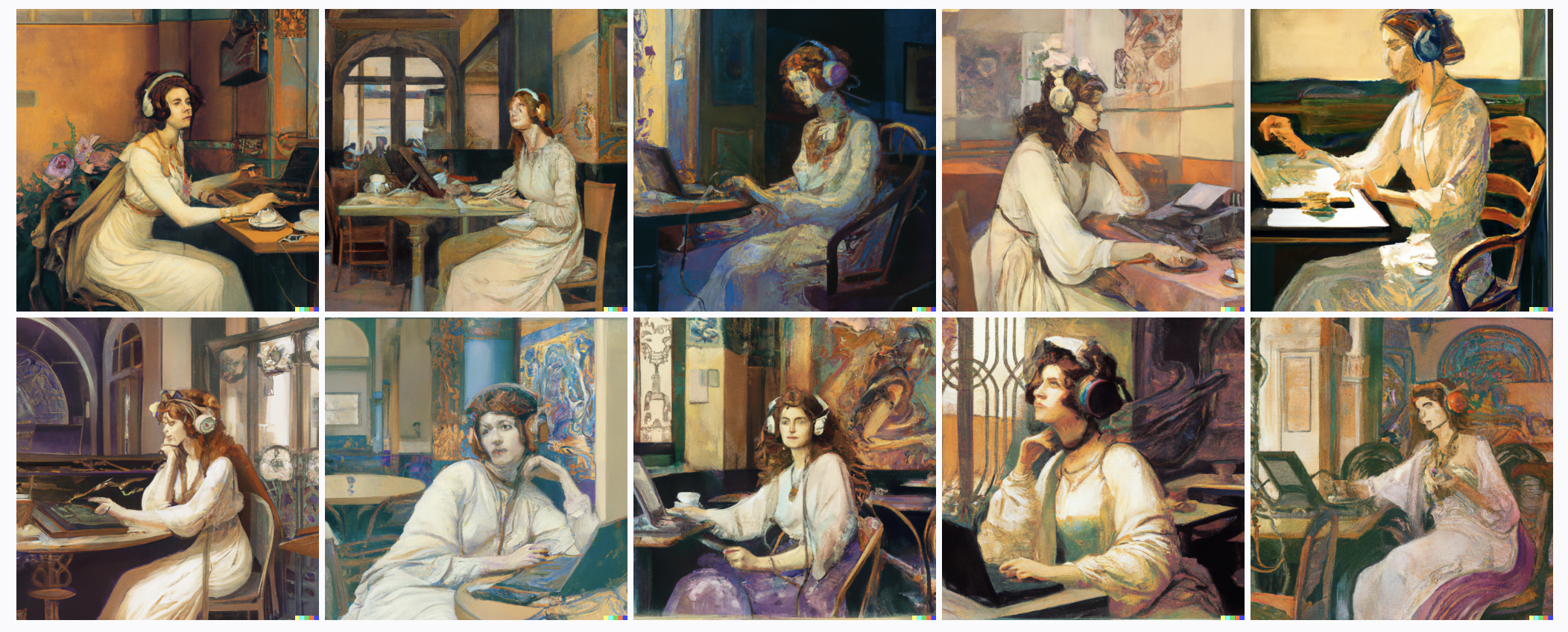
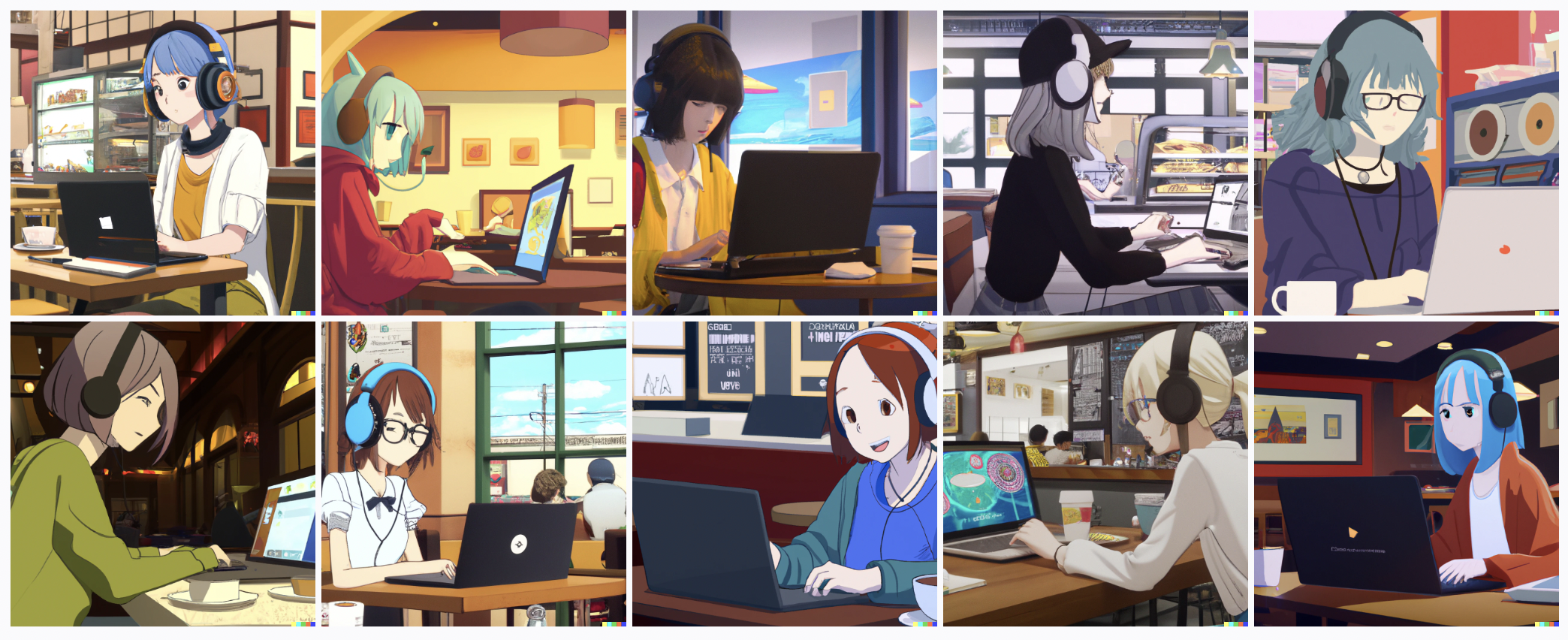
DALL-E is often sensitive to exact wording, and in particular it’s fascinating how “in the style of x” often gets very different results from “screenshot from an x movie”. I’m guessing that in the Pixar case, generic “Pixar style” might capture training data from Pixar shorts or illustrations that aren’t in their standard recognizable movie style. (Also, sometimes if asked for “anime” it gives me content that either looks like 3D rendered video game cutscenes, or occasionally what I assume is meant to be people at an anime con in cosplay.)
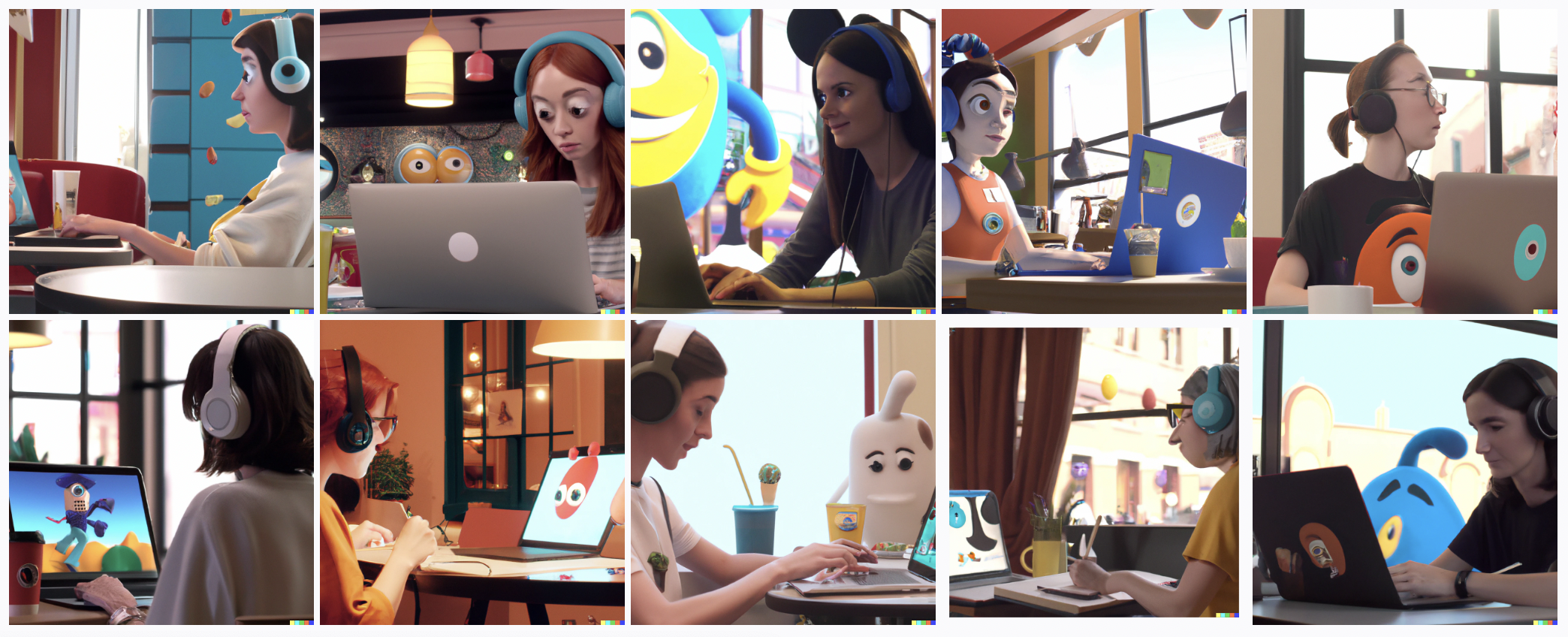
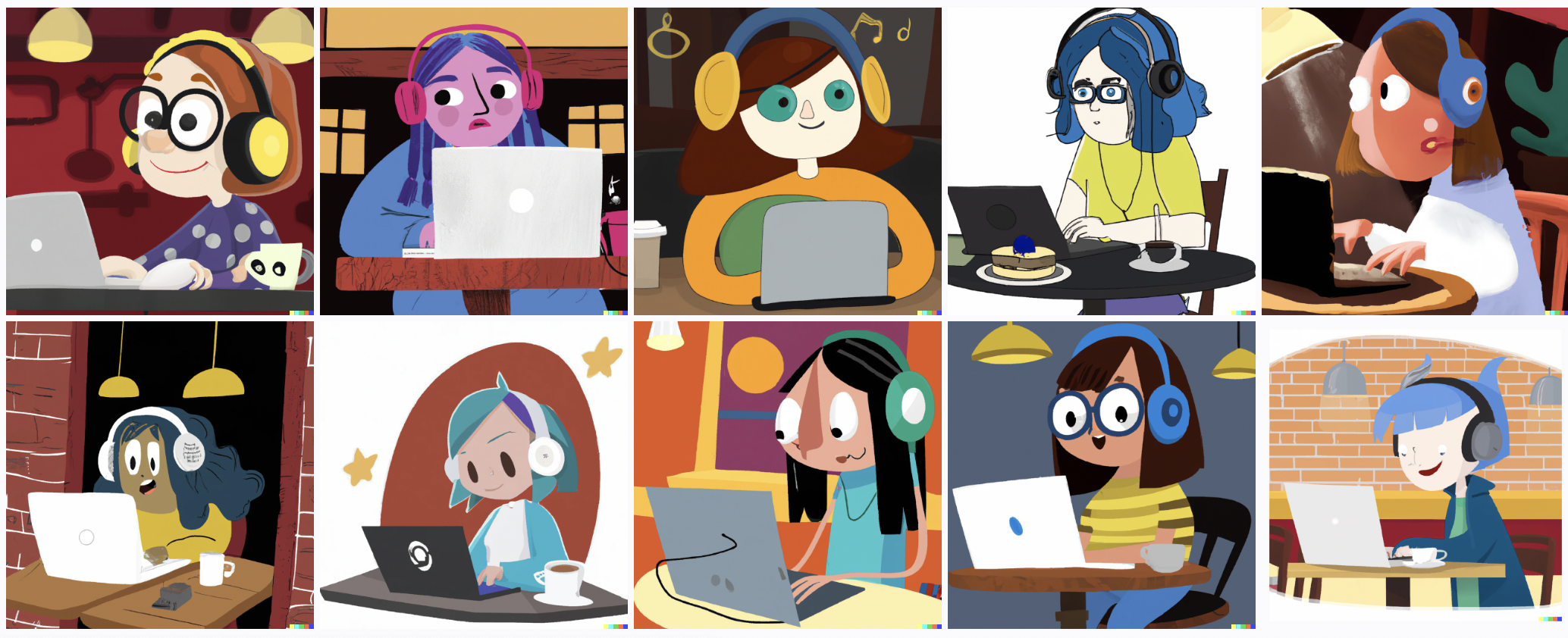
Conclusions
How smart is DALL-E?
I would give it an excellent grade in recognizing objects, and most of the time it has a pretty good sense of their purpose and expected context. If I give it just the prompt “a box, a chair, a computer, a ceiling fan, a lamp, a rug, a window, a desk” with no other specification, it consistently includes at least 7 of the 8 requested objects, and places them in reasonable relation to each other – and in a room with walls and a floor, which I did not explicitly ask for. This “understanding” of objects is a lot of what makes DALL-E so easy to work with, and in some sense seems more impressive than a perfect art style.
The biggest thing I’ve noticed that looks like a ~conceptual limitation in the model is its inability to consistently track two different characters, unless they differ on exactly one trait (male and female, adult and child, red hair and blue hair, etc) – in which case the model could be getting this right if all it’s doing is randomizing the traits in its bucket between the characters. It seems to have a similar issue with two non-person objects of the same type, like chairs, though I’ve explored this less.
It often applies color and texture styling to parts of the image other than the ones specified in the prompt; if you ask for a girl with pink hair, it’s likely to make the walls or her clothes pink, and it’s given me several Rapunzels wearing a gown apparently made of hair. (Not to mention the time it was confused about whether, in “Goldilocks and the three bears”, Goldilocks was also supposed to be a bear.)
The deficits with the “edit” mode and “variations” mode also seem to me like they reflect the model failing to neatly track a set of objects-with-assigned-traits. It reliably holds the non-highlighted areas of the image constant and only modifies the selected part, but the modifications often seem like they’re pulling in context from the entire prompt – for example, when I took one of my room-with-objects images and tried to select the computer and change it to “a computer levitating in midair”, DALL-E gave me a levitating fan and a levitating box instead.
Working with DALL-E definitely still feels like attempting to communicate with some kind of alien entity that doesn’t quite reason in the same ontology as humans, even if it theoretically understands the English language. There are concepts it appears to “understand” in natural language without difficulty – including prompts like “advertising poster for the new Marvel’s Avengers movie, as a Miyazaki anime, in the style of an Instagram inspirational moodboard”, which would take so long to explain to aliens, or even just to a human from 1900. And yet, you try to explain what an Otto bicycle is – something which I’m pretty sure a human six-year-old could draw if given a verbal description – and the conceptual gulf is impossible to cross.
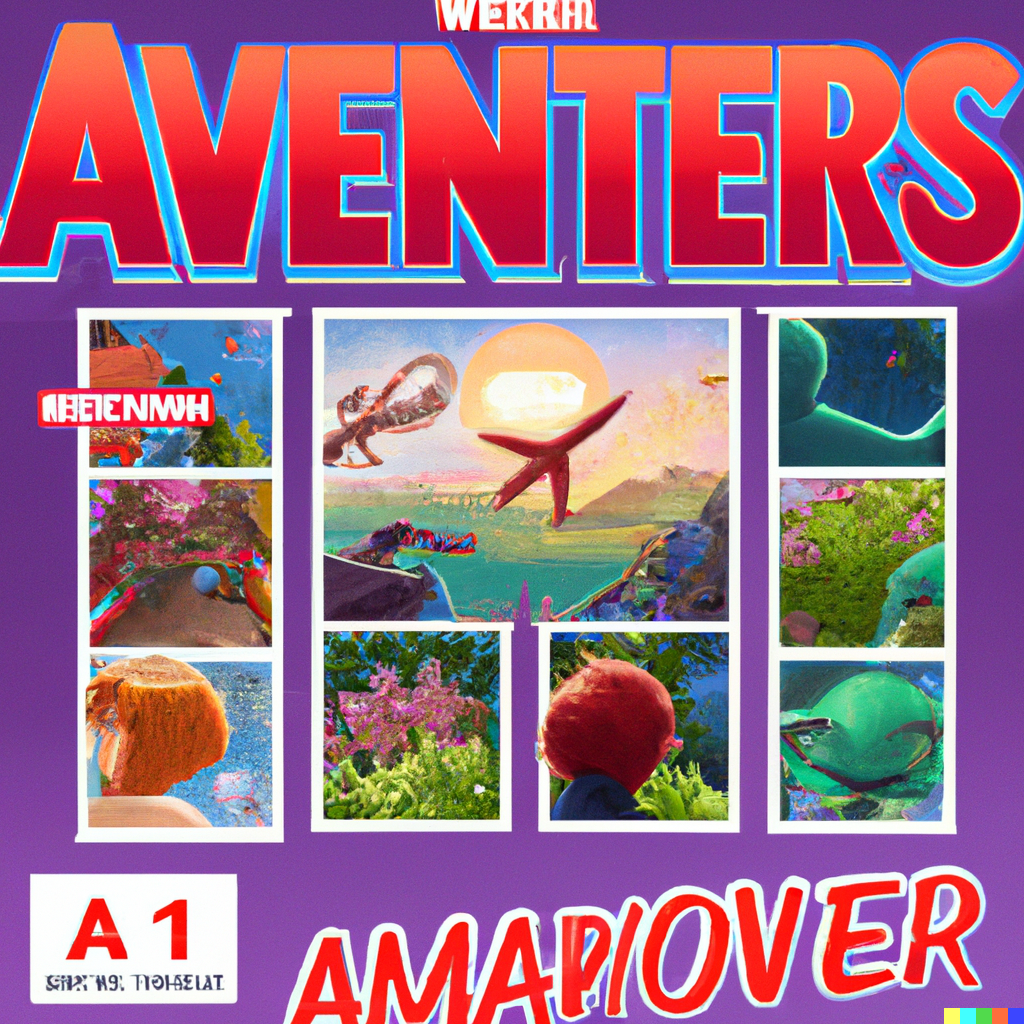
- Against Almost Every Theory of Impact of Interpretability by (Aug 17, 2023, 6:44 PM; 329 points)
- AI Safety 101 : Capabilities—Human Level AI, What? How? and When? by (Mar 7, 2024, 5:29 PM; 46 points)
- Synthetic Media and The Future of Film by (May 24, 2022, 5:54 AM; 35 points)
- 's comment on SolidGoldMagikarp (plus, prompt generation) by (Feb 11, 2023, 7:58 AM; 4 points)
- 's comment on SolidGoldMagikarp (plus, prompt generation) by (Feb 14, 2023, 8:17 PM; 4 points)
- AI Safety 101 : AGI by (EA Forum; Dec 21, 2023, 2:18 PM; 2 points)
Swimmer963 highlights DALL-E 2 struggling with anime, realistic faces, text in images, multiple characters/objects arranged in complex ways, and editing. (Of course, many of these are still extremely good by the standards of just months ago, and the glass is definitely more than half full.) itsnotatumor asks:
In general, we have not topped out on pretty much any scaling curve. Whether it’s language modeling, image generation, DRL, or whathaveyou, AFAIK, not a single modality can be truly said to have been ‘solved’ with the scaling curve broken. Either the scaling curve is flat, or we’re still far away. (There are some sound-related ones which seem to be close, but nothing all that important.) Diffusion models’ only scaling law I know of is an older one which bends a little but probably reflects poor hyperparameters, and no one has tried eg. Chinchilla on them yet.
So yes, we definitely can just make all the compute-budgets 10x larger without wasting it.
To go through the specific issues (caveat: we don’t know if Make-A-Scene solves any of these because no one can use it; and I have not read the Cogview2 paper*):
anime & realistic faces are purely self-imposed problems by OA. DALL-E 2 will do them fine just as soon as OA wants it to, and other models by other orgs do just fine on those domains. So no real problem there.
text in images: this is an odd one. This is especially odd because it destroys the commercial application of any image with text in it (because it’s garbage—who’d pay for these?), and if you go back to DALL-E 1, one of the demos was it putting text into images like onto generated teapots or storefronts. It was imperfect, but DALL-E 2 is way worse at it, it looks like. I mean, DALL-E 1 would’ve at least spelled ‘Avengers’ correctly. Nostalgebraist has also shown you can get excellent text generation with a specialized small model, and people using compviz (also much smaller than DALL-E 2) get good text results. So text in images is not intrinsically hard, this is a DALL-E 2-specific problem, whatever it is.
Why? As Nostalgebraist discusses at length in his earlier post, the unCLIP approach to using GLIDE to create the DALL-E 2 system seems to have a lot of weird drawbacks and tradeoffs. Just as CLIP’s contrastive view of the world (rather than discriminative or generative) leads to strange artifacts like images tessellating a pattern, unCLIP seems to cripple DALL-E 2 in some ways like compositionality is worsened. I don’t really get the unCLIP approach so I’m not completely sure why it’d screw up text. The paper speculates that
Damn you BPEs! Is there nothing you won’t blight?!
It may also be partially a dataset issue: OA’s licensing of commercial datasets may have greatly underemphasized images which have text in them, which tends to be more of a dirty Internet or downstream user thing to have. If it’s unCLIP, raw GLIDE should be able to do text much better. If it’s the training data, it probably won’t be much different.
If it’s the training data, it’ll be easy to fix if OA wants to fix it (like anime/faces); OA can find text-heavy datasets, or simply synthesize the necessary data by splatting random text in random fonts on top of random images & training etc. If it’s unCLIP, it can be hacked around by letting the users bypass unCLIP to use raw GLIDE, which as far as I know, they have no ability to do at the moment. (Seems like a very reasonable option to offer, if only for other purposes like research.) A longer-term solution would be to figure out a better unCLIP which avoids these contrastive pathologies, and a longer-term still solution would be to simply scale up enough that you no longer need this weird unCLIP thing to get diverse but high-quality samples, the base models are just good enough.
So this might be relatively easy to fix, or have an obvious fix but won’t be implemented for a long time.
complex scenes: this one is easy—unCLIP is screwing things up.
The problem with these samples generally doesn’t seem to be that the objects rendered are rendered badly by GLIDE or the upscalers, the problem seems to be that the objects are just organized wrong because the DALL-E 2 system as a whole didn’t understand the text input—that is, CLIP gave GLIDE the wrong blueprint and that is irreversible. And we know that GLIDE can do these things better because the paper shows us how much better one pair of prompts are (no extensive or quantitative evaluation, however):
And it’s pretty obvious that it almost has to screw up like this if you want to take the approach of a contrastively-learned fixed-size embedding (Nostalgebraist again): a fixed-size embedding is going to struggle if you want to stack on arbitrarily many details, especially without any recurrency or iteration (like DALL-E 1 had in being a Transformer on text inputs + VAE-token outputs). And a contrastive model like CLIP isn’t going to do relationships or scenes as well as it does other things because it just doesn’t encounter all that many pairs of images where the objects are all the same but their relationship is different as specified by the text caption, which is the sort of data which would force it to learn how “the red box is on top of the blue box” looks different from “the blue box is on top of the red box”.
Like before, just offering GLIDE as an option would fix a lot of the problems here. unCLIP screws up your complex scene? Do it in GLIDE. The GLIDE is hard to guide or lower-quality? Maybe seed it in GLIDE and then jazz it up in the full DALL-E 2.
Longer-term, a better text encoder would go a long way to resolving all sorts of problems. Just existing text models would be enough, no need for hypothetical new archs. People are accusing DALL-E 2 of lacking good causal understanding or not being able to solve problems of various sorts; fine, but CLIP is a very bad way to understand language, being a very small text encoder (base model: 0.06b) trained contrastively from scratch on short image captions rather than initialized from a real autoregressive language model. (Remember, OA started the CLIP research with autoregressive generation, Figure 2 in the CLIP paper, it just found that more expensive, not worse, and switched to CLIP.) A real language model, like Chinchilla-80b, would do much better when fused to an image model, like in Flamingo.
So, these DALL-E 2 problems all look soluble to me by pursuing just known techniques. They stem from either deliberate choices, removing the user’s ability to choose a different tradeoff, or lack of simple-minded scaling.
* On skimming, CogView2 looks like it’d avoid most of the DALL-E 2 pathologies, but looks like it’s noticeably lower-quality in addition to lower-resolution.
EDIT: between Imagen, Parti, DALL-E 3, and the miracle-of-spelling paper, I think that my claims that text in images is simply a matter of scale, and that tokenization screws up text in images, are now fairly consensus in DL as of late 2023.
Google Brain just announced Imagen (Twitter), which on skimming appears to be not just as good as DALL-E 2 but convincingly better. The main change appears to be reducing the CLIP reliance in favor of a much larger and more powerful text encoder before doing the image diffusion stuff. They make a point of noting superiority on “compositionality, cardinality, spatial relations, long-form text, rare words, and challenging prompts.” The samples also show text rendering fine inside the images as well.
I take this as strong support (already) for my claims 2-3: the problems with DALL-E 2 were not major or deep ones, do not require any paradigm shift to fix, or even any fix, really, beyond just scaling the components almost as-is. (In Kuhnian terms, the differences between DALL-E 2 and Imagen or Make-A-Scene are so far down in the weeds of normal science/engineering that even people working on image generation will forget many of the details and have to double-check the papers.)
EDIT: Google also has a more traditional autogressive DALL-E-1-style 1024px model, “Parti”, competing with diffusion Imagen; it is slightly better in COCO FID than Imagen. It likewise does well on all those issues, with again no special fancy engineering aimed specifically at those issues, mostly just scaling up to 20b.
Will future generative models choke to death on their own excreta? No.
Now that goalposts have moved from “these neural nets will never work and that’s why they’re bad” to “they are working and that’s why they’re bad”, a repeated criticism of DALL·E 2 etc is that their deployment will ‘pollute the Internet’ by democratizing high-quality media, which may (given all the advantages of machine intelligence) quickly come to exceed ‘regular’ (artisanally-crafted?) media, and that ironically this will make it difficult or impossible to train better models. I don’t find this plausible at all but lots of people seem to and no one is correcting all these wrong people on the Internet, so here’s a quick rundown why:
It Hasn’t Happened Yet: there is no such thing as ‘natural’ media on the Internet, and never has been. Even a smartphone photograph is heavily massaged by a pipeline of algorithms (increasingly DL-based) before it is encoded into a codec designed to throw away human-perceptually-unimportant data such as JPEG. We are saturated in all sorts of Photoshopped, CGIed, video-game-rendered, Instagram-filtered, airbrushed, posed, lighted, (extremely heavily) curated media. If these models are as uncreative as claimed by critics and merely memorizing… what’s the big deal?
Spread will happen slowly: see earlier comment. Consider GPT-3: you can sign up for the OA API easily, there’s GPT-Neo-20b, FB is releasing OPT, etc. It’s still ‘underused’ compared to what it could be used, and most of the text on the Internet continues to be written by humans or non-GPT-3-quality software etc.
There’s Enough Data Already: what if we have ‘used up’ the existing data and are ‘polluting’ new data unfixably such that the old pre-generative datasets are inadequate and we can’t cheaply get clean new data?
sample efficiency: critics love to harp on the sample-inefficiency. How can these possibly be good if it takes hundreds of millions of images? Surely the best algorithm would be far more sample-efficient, and you should be able to match DALL·E 2 with a million well-selected images, max. Sure: the first is always the worst, the experience curves will kick in, we are trading data for compute because photos are cheap & GPUs dear—I agree, I just don’t think those are all that bad or avoidable.
But the flip side of this is that if existing quantities are already enough to train near-photorealistic models, when these models are admittedly so grossly sample-inefficient, then when those more sample-efficient models become possible, we will definitely have enough data to train much better quality models in the future simply by using the same amount of data.
diversity: Sometimes people think that 400m or 1b images are ‘not sufficiently diverse’, and must be missing something. This might be due to a lack of appreciation for the tail and Littlewood’s Law: if you spend time going through datasets like LAION-400m or YFCC100M, there is a lot of strange stuff there. All it takes is one person out of 7 billion doing it for any crazy old reason (including being crazy).
This raises another ironic reversal of criticisms: to deprecate some remarkable sample, a critic will often try to show “it’s just copying” something that looks vaguely similar in Google Images. Obviously, this is a dilemma for the future-choke argument: if the remarkable sample is not already in the corpus, then the present models already have learned it adequately and ‘generalized’ (despite all of the noise from point #1), and future data is not necessary for future models; if the remarkable sample is in the corpus, then future models can just learn from that!
all the other data: current models only scratch the surface of available media. There is a lot of image data out there. A lot.
For example, Twitter blocks Common Crawl, which is the base for many scrapes; how many tens of billions of artworks alone is that? Twitter has tons of artists who post art on a regular basis (including many series of sketches to finished works which would be particularly valuable). Or DALL·E 2 is strikingly bad at anime and appears to have clearly filtered out or omitted all anime sources—so, that’s 5 million images from Danbooru2021 not included (>9.9 million on Big Booru), an overlapping >100 million images from Pixiv (powered in part by commissions through things like Skeb.jp, >100k commissions thus far), >2.8 million furry images on e621, 2 million My Little Pony images on Derpibooru… What about BAM!, n = 65 million? DeviantArt seems to be represented, but I doubt most of it is (>400 million). There’s something like >2 million books published every year; many have no illustrations but also many are things like comic books (>1500 series by major publishers?) or manga books (>8000/year?) which have hundreds or thousands of discrete illustrations—so that’s got to be millions of images piling up every year since. How about gig markets? Fiverr, just one of many, reports 3.4 million buyers spending >$200/each; at a nominal rate of $50/image, that would be 4 per buyer or 13 million images. So all together, there’s billions of high-quality images out there for the collecting, and something like hundreds of millions being added each year.
(These numbers may seem high but it makes sense if you think about the exponential growth of the Internet or smartphones or digital art: the majority of it must have been created recently, so if there are billions of images, then the current annual rate is probably going to be something like ‘hundreds of millions’. They can’t all be scans of ancient Victorian erotica.)
Also: multimodal data. How about video? A high-quality Hollywood movie or TV series probably provides a good non-redundant still every couple of seconds; TV production the past few years has been, due to streaming money, at all time highs like >500 series per year...
I mean, this is all a ludicrously narrow slice of the world, so I hope it adequately makes the point that we have not, do not now, and very much will not in the future, suffer from any hard limit on data availability. Chinchilla may make future models more data-hungry, and you may have to do some real engineering work to get as much as you want, or pay for it, but it’s there if you want it enough. (We will have a ‘data shortage’ in the same way we have a $5/pound filet mignon shortage.)
The Student Becomes The Master: imitation learning can lead to better performance than the original demonstrations or ‘experts’.
There are a bunch of ways to do bootstraps, but to continue the irony theme here, the most obvious one is the ‘cherry-picking’ accusation: “these samples are good but they’re just cherry-picked!” This is silly because all samples, human or past models, are all cherrypicked; the human samples are typically filtered much harder than the machine samples; there are machine ways to do the cherrypicking automatically; and you couldn’t get current samples out of old models no matter how hard you feasibly selected.
But for the choking argument, this is a problem: it is easier to recognize good samples than to create them. If humans are filtering model outputs, then the more heavily they filter, the more they are teaching future models what are good and bad samples by populating the dataset with good samples and adding criticism to bad samples. (Every time someone posts a tweet with a snarky “#dalle-fail”, they are labeling that sample as bad and teaching future DALL·Es what a mistake looks like and how not to draw a hand.) Good samples will get spread and edited and copied online, and will elicit more samples like that, as people imitate them and step up their game and learn how to use DALL·E right.
Mistakes Are Just Another Style: we can divide the supposed pernicious influence of the generated samples into 2: random vs systematic error.
random error: is not a problem.
NNs are notoriously robust to random error like label errors. This is already the case if you look at the data these models are trained on. (On the DALL·E 2 subreddit, people will sometimes exclaim that the model understood their “gamboy made of crystal” prompt: “it knew I meant ‘Gameboy’ despite my typo, amazing!” You sweet, sweet summer child.) You can do wacky things like scramble 99% of ImageNet labels, and as long as there is a seed of correctly-classified images reflecting the truth, a CNN classifier will… mostly work? Yeah. (Or the observation with training GPT-style models that as long as there is a seed of high-quality text like Wikipedia to work with, you can throw in pretty crummy Internet text and it’ll still help.) To the extent that the models are churning out random errors (similar to how GPT-3 stochastic sampling often leads to just dumb errors), they aren’t really going to interfere with themselves.
You pay a price in compute, of course, and GPUs aren’t free, but it’s certainly no fatal problem.
systematic error: people generally seem to have in mind more like systematic error in generated samples: DALL·E 2 can’t generate hands, and so all future models are doomed to look like missives from the fish-people beneath the sea.
But the thing is, if an error is consistent enough for the critic to notice, then it’s also obvious enough for the model to notice. If you repeat a joke enough times, it can become funny; if you repeat an error enough, then it’s just your style. Errors will be detected, learned, and conditioned on for generation. Past work in deepfake detection has shown that even when models like StyleGAN2 are doing photorealistic faces, they are still detectable with high confidence by other models because of subtle issues like reflections in the eye or just invisible artifacts in the high frequency domains where humans are blind. We all know the ‘Artstation’ prompt by now, and it goes the other way too: you can ask DALL·E 2 for “DeepDream” (remember the psychedelic dog-slugs?) (or ‘grainy 1940s photo’ or ’1980s VHS tape’ or ‘out of focus shot’ or ‘drawn by a child’ or...). You can’t really ask it for ‘DALL·E’ images, and that’s a testament to the success.
DALL·E 2 errors are just the DALL·E 2 style, and it will be promptable like anything else by future models, which will detect the errors (and/or the OA watermark in the lower right corner), and it will no more ‘break’ them than some melting watches in a Salvador Dali painting destroys their ability to depict a pocket-watch. Dali paintings have melty dairy products and timekeeping devices, and DALL·E 2 paintings have melty faces and hands, and that’s just the way those artistic genres are, but it doesn’t make you or future models think that’s how everything is.
(And if you can’t see a style, well then: Mission. Accomplished.)
If I worried about something, one worry I have not seen mentioned is the effect of generative model excellence on cultural evolution, not by being incapable of high-quality or diverse styles, but by being too capable, too good, too cheap, too fast. Ted Gioia in a recent grumpy article about sequelitis has a line:
Generative models may help push us towards a world in which alternative voices are everywhere and it has never been cheaper or easier for anyone in the world to create a unique new style which can complement their other skills and produce a vast corpus of high-quality works in that style, but also in which it has never been harder to be heard or to develop that style into any kind of ‘cultural impact’.
When content is infinite, what becomes scarce? Attention ie. selection. Communities rely on multilevel selection to incubate new styles and gradually percolate them up from niches to broader audiences. For this to work, those small communities need to be somewhat insulated from fashions, because a new style will never enter the world as fully optimized as old styles; they need investment, perhaps exploiting sunk costs, perhaps exploiting parasociality, so they can deeply explore it. Unfortunately, by rendering entry into a niche trivial, producing floods of excellent content, and accelerating cultural turnover & amnesia, it gets harder & harder to make any dent: by the time you show up to the latest thing with your long-form illustrated novel (which you could never have done by yourself), that’s soooo last week and your link is already buried 100 pages deep into the submission queue. Your 1000 followers on Twitter will think you’re a genius, and you will be, but that will be all it ever amounts to. I am already impressed just how many quite beautiful or interesting images I see posted from DALL-E 2 or Stable Diffusion, but which immediately disappear in the infinite scroll under the flood of further selections, never to be seen again or archived anywhere or curated.
Can I get a link to someone who actually believes this? I’m honestly a little skeptical this is a common opinion, but wouldn’t put it past people I guess.
I’ve seen it several times on Twitter, Reddit, and HN, and that’s excluding the people like Jack Clark who has pondered it repeatedly in his Import.ai newsletter & used it as theme in some of his short stories (but much more playfully & thoughtfully in his case so he’s not the target here). I think probably the one that annoyed me enough to write this was when Imagen hit HN and the second lengthy thread was all about ‘poisoning the well’ with most of them accepting the premise. It has also been asked here on LW at least twice in different places. (I’ve also since linked this writeup at least 4 times to various people asking this exact question about generative models choking on their own exhaust, and the rise of ChatGPT has led to it coming up even more often.)
Wow, this is going to explode picture books and book covers.
Hiring an illustrator for a picture book costs a lot, as it should given it’s bespoke art.
Now publishers will have an editor type in page descriptions, curate the best and off they go. I can easily imagine a model improvement to remember the boy drawn or steampunk bear etc.
Book cover designers are in trouble too. A wizard with lighting in hands while mountain explodes behind him—this can generate multiple options.
It’s going to get really wild when A/B split testing is involved. As you mention regarding ads you’d give the system the power to make whatever images it wanted and then split test. Letting it write headlines would work too.
Perhaps a full animated movie down the line. There are already programs that fill in gaps for animation poses. Boy running across field chased by robot penguins—animated, eight seconds. And so on. At that point it’s like Pixar in a box. We’ll see an explosion of directors who work alone, typing descriptions, testing camera angles, altering scenes on the fly. Do that again but more violent. Do that again but with more blood splatter.
Animation in the style of Family Guy seems a natural first step there. Solid colours, less variation, not messing with light rippling etc.
There’s a service authors use of illustrated chapter breaks, a black and white dragon snoozing, roses around knives, that sort of thing. No need to hire an illustrator now.
Conversion of all fiction novels to graphic novel format. At first it’ll be laborious, typing in scene descriptions but graphic novel art is really expensive now. I can see a publisher hiring a freelancer to produce fifty graphic novels from existing titles.
With a bit of memory, so once I choose the image of each character I want, this is an amazing game changer for publishing.
Storyboarding requires no drawing skill now. Couple sprinting down dark alley chased by robots.
Game companies can use it to rapid prototype looks and styles. They can do all that background art by typing descriptions and saving the best.
We’re going to end up with people who are famous illustrator who can’t draw but have created amazing styles using this and then made books.
Thanks so much for this post. This is wild astonishing stuff. As an author who is about to throw large sums of money at cover design, it’s incredible to think a commercial version of this could do it for a fraction of the price.
edit: just going to add some more
App design that requires art. For example many multiple choice story apps that are costly to make due to art cost.
Split-tested covers designs for pretty much anything—books, music, albums, posters. Generate, ad campaign, test clicks. An ad business will be able to throw up a 1000 completely different variations in a day.
All catalogs/brochures that currently use stock art. While choosing stock art to make things works it also sucks and is annoying with the limited range. I’m imagining a stock art company could radically expand their selection to keep people buying from them. All those searches that people have typed in are now prompts.
Illustrating wikipedia. Many articles need images to demonstrate a point and rely on contributors making them. This could open up improvements in the volume of images and quality.
Graphic novels/comic books—writers who don’t need artists essentially. To start it will be describing single panels and manually adding speech text but that’s still faster and cheaper than hiring an artist. For publishers—why pick and choose what becomes a graphic novel when you can just make every title into a graphic novel.
Youtube/video interstitial art. No more stock photos.
Licensed characters (think Paw Patrol, Disney, Dreamworks) - creation of endless poses, scenes. No more waiting for Dreamworks to produce 64 pieces of black and white line art when it may be able to take the movie frames and create images from that.
Adaptations—the 24-page storybook of Finding Nemo. The 24-page storybook of Pinocchio. The picture book of Fast and The Furious.
Looking further ahead we might even see a drop-down option of existing comics, graphic novels but in a different art style. Reading the same Spiderman story but illustrated by someone else.
Character design—for games, licensing, children’s animation. This radically expands the volume of characters that can be designed, selected and then chosen for future scenes.
With some sort of “keep this style”, “save that character” method, it really would be possible to generate a 24-page picture book in an incredibly short amount of time.
Quite frankly, knowing how it works, I’d write a picture book of a kid going through different art styles in their adventure. Chasing their puppy through the art museum and the dog runs into a painting. First Van Gogh, then Da Vinci and so on. The kid changes appearance due to the model but that works for the story.
As a commercial produce, this system would be incredible. I expect we’ll see an explosion in the number of picture books, graphic novels, posters, art designs, etsy prints, downloadable files and so on. Publishers with huge backlists would be a prime customer.
Video is on the horizon (video generation bibliography eg. FDM), in the 1-3 year range. I would say that video is solved conceptually in the sense that if you had 100x the compute budget, you could do DALL-E-2-but-for-video right now already. After all, if you can do a single image which is sensible and logical, then a video is simply doing that repeatedly. Nor is there any shortage of video footage to work with. The problem there is that a video is a lot of images: at least 24 images per second, so you could have 192 different samples, or 1 8s clip. Most people will prefer the former: decorating, say, a hundred blog posts with illustrations is more useful than a single OK short video clip of someone dancing.
So video’s game is mostly about whether you can come up with an approach which can somehow economize on that, like clever tricks in reusing frames to update only a little while updating a latent vector, as a way to take a shortcut to that point in the future where you had so much compute that the obvious Transformer & Diffusion models can be run in reasonable compute-budgets & video ‘just worked’.
And either way, it may be the revolution that robotics requires (video is a great way to plan).
Following up on your logic here, the one thing that DALLE-2 hasn’t done, to my knowledge, is generate entirely new styles of art, the way that art deco or pointillism were truly different from their predecessors.
Perhaps that’ll be the new of of human illustrators? Artists, instead of producing their own works to sell, would instead create their own styles, generating libraries of content for future DALLEs to be trained against. They then make a percentage on whatever DALLE makes from image sales if the style used was their own.
Can DALL·E Create New Styles?
Most DALL·E questions can be answered by just reading the paper of it or its competitors, or are dumb. This is probably the most interesting question that can’t be, and also one of the most common: can DALL·E (which we’ll use just as a generic representative of image generative models, since no one argues that one arch or model can and the others cannot AFAIK) invent a new style? DALL·E is, like GPT-3 in text, admittedly an incredible mimic of many styles, and appears to have gone well beyond any mere ‘memorization’ of the images depicting styles because it can so seamlessly insert random objects into arbitrary styles (hence all the “Kermit Through The Ages” or “Mughal space rocket” variants); but simply being a gifted epigone of most existing styles is not guarantee you can create a new one.
If we asked a Martian what ‘style’ was, it would probably conclude that “‘style’ is what you call it when some especially mentally-ill humans output the same mistakes for so long that other humans wearing nooses try to hide the defective output by throwing small pieces of green paper at the outputs, and a third group of humans wearing dresses try to exchange large white pieces of paper with black marks on them for the smaller green papers”.
Not the best definition, but it does provide one answer: since DALL·E is just a blob of binary which gets run on a GPU, it is incapable of inventing a style because it can’t take credit for it or get paid for it or ally with gallerists and journalists to create a new fashion, so the pragmatic answer is just ‘no’, no more than your visual cortex could. So, no. This is unsatisfactory, however, because it just punts to, ‘could humans create a new style with DALL·E?’ and then the answer to that is simply, ‘yes, why not? Art has no rules these days: if you can get someone to pay millions for a rotting shark or half a mill for a blurry DCGAN portrait, we sure as heck can’t rule out someone taking some DALL·E output and getting paid for it.’ After all, DALL·E won’t complain (again, no more than your visual cortex would). Also unsatisfactory but it is at least testable: has anyone gotten paid yet? (Of course artists will usually try to minimize or lie about it to protect their trade secrets, but at some point someone will ’fess up or it become obvious.) So, yes.
Let’s take ‘style’ to be some principled, real, systematic visual system of esthetics. Regular use of DALL·E, of course, would not produce a new style: what would be the name of this style in the prompt? “Unnamed new style”? Obviously, if you prompt DALL·E for “a night full of stars, Impressionism”, you will get what you ask for. What are the Internet-scraped image/text caption pairs which would correspond to the creation of a new style, exactly? “A dazzling image of an unnamed new style being born | Artstation | digital painting”? There may well be actual image captions out there which do say something like that, but surely far too few to induce some sort of zero-shot new-style creation ability. Humans too would struggle with such an instruction. (Although it’s fun to imagine trying to commission that from a human artist on Fiverr for $50, say: “an image of a cute cat, in a totally brand-new never before seen style.” “A what?” “A new style.” “I’m really best at anime-style illustrations, you know.” “I know. Still, I’d like ‘a brand new style’. Also, I’d like to commission a second one after that too, same prompt.” ”...would you like a refund?”)
Still, perhaps DALL·E might invent a new style anyway just as part of normal random sampling? Surely if you generated enough images it’d eventually output something novel? However, DALL·E isn’t trying to do so, it is ‘trying’ to do something closer to generating the single most plausible image for a given text input, or to some minor degree, sampling from the posterior distribution of the Internet images + commercial licensed image dataset it was trained on. To the extent that a new style is possible, it ought to be extremely rare, because it is not, in fact, in the training data distribution (by definition, it’s novel), and even if DALL·E 2 ‘mistakenly’ does so, it would be true that this newborn style would be extremely rare because it is so unpopular compared to all the popular styles: 1 in millions or billions.
Let’s say it defied the odds and did anyway, since OA has generated millions of DALL·E 2 samples already according to their PR. ‘Style’ is something of a unicorn: if DALL·E could (or had already) invented a new style… how would we know? If Impressionism had never existed and Van Gogh’s Starry Night flashed up on the screen of a DALL·E 2 user late one night, they would probably go ‘huh, weird blobby effect, not sure I like it’ and then generate new completions—rather than herald it as the ultimate exemplar of a major style and destined to be one of the most popular (to the point of kitsch).
Finally, if someone did seize on a sample from a style-less prompt because it looked new to them and wanted to generate more, they would be out of luck: DALL·E 2 can generate variations on an image, yes, but this unavoidably is a mashup of all of the content and style and details in an image. There is not really any native way to say ‘take the cool new style of this image and apply it to another’. You are stuck with hacks: you can try shrinking the image to uncrop, or halve it and paste in a target image to infill, or you can go outside DALL·E 2 entirely and use it in a standard style-transfer NN as the original style image… But there is no way to extract the ‘style’ as an easily reused keyword or tool the way you can apply ‘Impressionism’ to any prompt.
This is a bad situation. You can’t ask for a new style by name because it has none; you can’t talk about it without naming it because no one does that for new real-world styles, they name it; and if you don’t talk about it, a new style has vanishingly low odds of being generated, and you wouldn’t recognize it, nor could you make any good use of it if you did. So, no.
DALL·E might be perfectly capable of creating a new style in some sense, but the interface renders this utterly opaque, hidden dark knowledge. We can be pretty sure that DALL·E knows styles as styles rather than some mashup of physical objects/colors/shapes: just like large language models imitate or can be prompted to be more or less rude, more or less accurate, more or less calibrated, generate more or less buggy or insecure code, etc., large image models disentangle and learn pretty cool generic capabilities: not just individual styles, but ‘award-winning’ or ‘trending on Artstation’ or ‘drawn by an amateur’. Further, we can point to things like style transfer: you can use a VGG CNN trained solely on ImageNet, with near-zero artwork in it (and definitely not a lot of Impressionist paintings), to fairly convincingly stylize images in the style of “Starry Night”—VGG has never seen “Starry Night”, and may never have seen a painting, period, so how does it do this?
Where DALL·E knows about styles is in its latent space (or VGG’s Gram matrix embedding): the latent space is an incredibly powerful way to boil down images, and manipulation of the latent space can go beyond ordinary samples to make, say, a face StyleGAN generate cars or cats instead—there’s a latent for that. Even things which seem to require ‘extrapolation’ are still ‘in’ the capacious latent space somewhere, and probably not even that far away: in very high dimensional spaces, everything is ‘interpolation’ because everything is an ‘outlier’; why should a ‘new style’ be all that far away from the latent points corresponding to well-known styles?
All text prompts and variations are just hamfisted ways of manipulating the latent space. The text prompt is just there to be encoded by CLIP into a latent space. The latent space is what encodes the knowledge of the model, and if we can manipulate the latent space, we can unlock all sorts of capabilities like in face GANs, where you can find latent variables which correspond to, say, wearing eyeglasses or smiling vs frowning—no need to mess around with trying to use CLIP to guide a ‘smile’ prompt if you can just tweak the knob directly.
Unless, of course, you can’t tweak the knob directly, because it’s behind an API and you have no way of getting or setting the embedding, much less doing gradient ascent. Yeah, then you’re boned. So the answer here becomes, ‘no, for now: DALL·E 2 can’t in practice because you can’t use it in the necessary way, but when some equivalent model gets released, then it becomes possible (growth mindset!).’
Let’s say we have that model, because it surely won’t be too long before one gets released publicly, maybe a year or two at the most. And public models like DALL·E Mini might be good enough already. How would we go about it concretely?
‘Copying style embedding’ features alone would be a big boost: if you could at least cut out and save the style part of an embedding and use it for future prompts/editing, then when you found something you liked, you could keep it.
‘Novelty search’ has a long history in evolutionary computation, and offers a lot of different approaches. Defining ‘fitness’ or ‘novelty’ is a big problem here, but the models themselves can be used for that: novelty as compared against the data embeddings, optimizing the score of a large ensemble of randomly-initialized NNs (see also my recent essay on constrained optimization as esthetics) or NNs trained on subsets (such as specific art movements, to see what ‘hyper Impressionism’ looks like) or...
Preference-learning reinforcement learning is a standard approach: try to train novelty generation directly. DRL is always hard though.
One approach worth looking at is “CAN: Creative Adversarial Networks, Generating ‘Art’ by Learning About Styles and Deviating from Style Norms”, Elgammal et al 2017. It’s a bit AI-GA in that it takes an inverted U-curve theory of novelty/art: a good new style is essentially any new style which you don’t like but your kids will in 15 years, because it’s a lot like, but not too much like, an existing style. CAN can probably be adapted to this setting.
CAN is a multi-agent approach in trying to create novelty, but I think you can probably do something much simpler by directly targeting this idea of new-but-not-too-new, by exploiting embeddings of real data.
If you embed & cluster your training data using the style-specific latents (which you’ve found by one of many existing approaches like embedding the names of stylistic movements to see what latents they average out to controlling, or by training a classifier, or just rating manually by eye), styles will form island-chains of works in each style, surrounded by darkness. One can look for suspicious holes, areas of darkness which get a high likelihood from the model, but are anomalously underrepresented in terms of how many embedded datapoints are nearby; these are ‘missing’ styles. The missing styles around a popular style are valuable directions to explore, something like alternative futures: ‘Impressionism wound up going thattaway but it could also have gone off this other way’. These could seed CAN approaches, or they could be used to bias regular generation: what if when a user prompts ‘Impressionist’ and gets back a dozen sample, each one is deliberately diversified to sample from a different missing style immediately adjacent to the ‘Impressionist’ point?
So, maybe.
An interesting example of what might be a ‘name-less style’ in a generative image model, Stable Diffusion in this case (DALL-E 2 doesn’t give you the necessary access so users can’t experiment with this sort of thing): what the discoverer calls the “Loab” (mirror) image (for lack of a better name—what text prompt, if any, this image corresponds to is unknown, as it’s found by negation of a text prompt & search).
‘Loab’ is an image of a creepy old desaturated woman with ruddy cheeks in a wide face, which when hybridized with other images, reliably induces more images of her, or recognizably in the ‘Loab style’ (extreme levels of horror, gore, and old women). This is a little reminiscent of the discovered ‘Crungus’ monster, but ‘Loab style’ can happen, they say, even several generations of image breeding later when any obvious part of Loab is gone—which suggests to me there may be some subtle global property of descendant images which pulls them back to Loab-space and makes it ‘viral’, if you will. (Some sort of high-frequency non-robust or adversarial or steganographic phenomenon?) Very SCP.
Apropos of my other comments on weird self-fulfilling prophecies and QAnon and stand-alone-complexes, it’s also worth noting that since Loab is going viral right now, Loab may be a name-less style now, but in future image generator models feeding on the updating corpus, because of all the discussion & sharing, it (like Crungus) may come to have a name - ‘Loab’.
I wonder what happens when you ask it to generate
> “in the style of a popular modern artist <unknown name>”
or
> “in the style of <random word stem>ism”.
You could generate both types of prompts with GPT-3 if you wanted so it would be a complete pipeline.
“Generate conditioned on the new style description” may be ready to be used even if “generate conditioned on an instruction to generate something new” is not. This is why a decomposition into new style description + image conditioned on it seems useful.
If this is successful, then more of the high-level idea generation involved can be shifted onto a language model by letting it output a style description. Leave blanks in it and run it for each blank, while ensuring generations form a coherent story.
>”<new style name>, sometimes referred to as <shortened version>, is a style of design, visual arts, <another area>, <another area> that first appeared in <country> after <event>. It influenced the design of <objects>, <objects>, <more objects>. <new style name> combined <combinatorial style characteristic> and <another style characteristic>. During its heyday, it represented <area of human life>, <emotion>, <emotion> and <attitude> towards <event>.”
DALL-E can already model the distribution of possible contexts (image backgrounds, other objects, states of the object) + possible prompt meanings. An go from the description 1) to high-level concepts, 2) to ideas for implementing these concepts (relative placement of objects, ideas for how to merge concepts), 3) to low-level details. All within 1 forward pass, for all prompts! This is what astonished me most about DALL-E 1.
Importantly, placing, implementing, and combining concepts in a picture is done in a novel way without a provided specification. For style generation, it would need to model a distribution over all possible styles and use each style, all without a style specification. This doesn’t seem much harder to me and could probably be achieved with slightly different training. The procedure I described is just supposed to introduce helpful stochasticity in the prompt and use an established generation conduit.
...Hmm now I’m wondering if feeding DALL-E an “in the style of [ ]” request with random keywords in the blank might cause it do replicable weird styles, or if it would just get confused and do something different every time.
I’d love to see it tried. Maybe even ask for “in the style of DALLE-2”?
“A woman riding a horse, in the style of DALLE-2”
I have no idea how to interpret this. Any ideas?
It seems like we got a variety of different styles, with red, blue, black, and white as the dominant colors.
Can we say that DALLE-2 has a style of its own?
I think DALL-E has been nerfed (as a sort of low-grade “alignment” effort) and some of what you’re talking about as “limitations” are actually bugs that were explicitly introduced with the goal of avoiding bad press.
It wouldn’t surprise me if they just used intelligibility tools to find the part of the vectorspace that represents “the face of any famous real person” and then applied some sort of noise blur to the model itself, as deployed?
Except! Maybe not a “blur” but some sort of rotation of a subspace or something? This hint is weirdly evocative:
The alternative of having it ever ever ever produce a picture of “Obama wearing <embarassing_thing>” or “Trump sleeping in box splashed with bright red syrup” or some such… that stuff might go viral… badly...
...so any single thing anyone manages to make has to be pre-emptively and comprehensively nerfed in general?
By comparison, it costs almost nothing to have people complain about how it did some totally bizarre other thing while refusing to shorten the hair of someone who might look too much like “Alan Rickman playing Snape” such that you might see a distinctive earlobe.
Sort of interestingly: in a sense, this damage-to-the-model is a (super low tech) “alignment” strategy!
The thing they might have wanted was to just say “while avoiding any possible embarrassing image (that could be attributed to the company that made the model making the image) in the circa-2022 political/PR meta… <user provided prompt content”.
But the system isn’t a genie that can understand the spirit and intent of wishes (yet?) so instead… just reach into the numbers and scramble them in certain ways?
In this sense, I think we aren’t seeing “DALL-E 2 as trained” but rather “DALL-E 2 with some sort of interesting alignment-related lobotomy to make it less able to accidentally stir up trouble”.
Yes, I thought their ‘horse in ketchup’ example made the point well that it’s an ‘artificial stupidity’ Harrison-Bergeron sort of approach rather than a genuine solution. (And then, like BPEs, there seems to be unpredictable fallout which would be hard to benchmark and which no one apparently even thought to benchmark—despite whatever they did on May 1st to upgrade quality, the anime examples still struggle to portray specific characters like Kyuubey, where Swimmer’s examples are all very Kyuubey-esque but never actually Kyuubey. I am told the CLIP used is less degraded, and so we’re probably seeing the output of ‘CLIP models which know about characters like Kyuubey combined with other models which have no idea’.)
Thread of all known anime examples.
That’s how you know it’s not a problem of pulling in lots of poorer-quality anime art. First, poorer-quality doesn’t impede learning that much; remember, you just prompt for high-quality. Compute allowing, more n is always better. And second, if it was a master of poorer-quality anime drawings, it wouldn’t be desperately ‘sliding away’, if you will, like squeezing a balloon, from rendering true anime, as opposed to CGI of anime or Western fanart of anime or photographs of physical objects related to anime. It would just do it (perhaps generating poorer-quality anime), not generate high-quality samples of everything but anime. (See my comment there for more examples.)
The problem is it’s somehow not trained on anime. Everything it knows about anime seems to come primarily from adjacent images and the CLIP guidance (which does know plenty about anime, but we also know that pixel generation from CLIP guidance never works as well).
A prompt i’d love to see: “Anomalocaris Canadensis flying through space.” I’m really curious how well it does with an extinct species which has very little existing artistic depictions. No text->image model i’ve played with so far has managed to create a convincing anomalocaris, but one interestingly did know it was an aquatic creature and kept outputting lobsters.
Going by the Wikipedia page reference, I think it got it somewhat closer than “lobsters” at least?
I’d rate these highly, there are many forms of anomalocarids (https://en.m.wikipedia.org/wiki/Radiodonta#/media/File%3A20191201_Radiodonta_Amplectobelua_Anomalocaris_Aegirocassis_Lyrarapax_Peytoia_Laggania_Hurdia.png) and it looks to have picked a wide variety aside from just candensis, but I’m thoroughly impressed that it got the form right in nearly all 10.
Challenging prompt ideas to try:
A row of five squares, in which the rightmost four squares each have twice the area of the square to their immediate left.
Screenshots from a novel game comparable in complexity to tic-tac-toe sufficient to demonstrate the rules of the game.
Elon Musk signing his own name in ASL.
The hands of a pianist as they play the first chord from Chopin’s Polonaise in Ab major, Op. 53
Pages from a flip book of a water glass spilling.
First one: ….yeah no, DALL-E 2 can’t count to five, it definitely doesn’t have the abstract reasoning to double areas. Image below is literally just “a horizontal row of five squares”.
Very interesting that it can’t manage to count to five. That to me is strong evidence that DALL-E’s not “constructing” the scenes it depicts. I guess it has more of a sense of relationships among scene element components? Like, “coffee shop” means there’s a window-like element, and if there’s a window element, then there’s some sort of scene through the window, and that’s probably some sort of rectangular building shape. Plausible guesses all the way down to the texture and color of skin or fur. Filling in the blanks on steroids, but with a complete lack of design or forethought.
Yeah, this matches with my sense. It has a really extensive knowledge of the expected relationships between elements, extending over a huge number of kinds of objects, and so it can (in one of the areas that are easy for it) successfully fill in the blanks in a way that looks very believable, but the extent to which it has a gears-y model of the scene seems very minimal. I think this also explains its difficulty with non-stereotypical scenes that don’t have a single focal element – if it’s filling in the blanks for both “pirate ship scene” and “dogs in Roman uniforms scene” it gets more confused.
You’re making my dreams come true. I really want to see the Elon Musk one :)
Edit: or the waterglass spilling. That’s the one with my most uncertainty about its performance.
The Elon Musk one has realistic faces so I can’t share it; I have, however, confirmed that DALL-E does not speak ASL with “The ASL word for “thank you”″:
We’ve got some funky fingers here. Six six fingers, a sort of double-tipped finger, an extra joint on the index finger on picture (1, 4). Fascinating.
It seems to be mostly trying to go for the “I love you” sign, perhaps because that’s one of the most commonly represented ones.
I’m curious why this prompt resulted in overwhelmingly black looking hands. Especially considering that all the other prompts I see result in white subjects being represented. Any theories?
It’s unnatural, yes: ASL is predominantly white, and people involved in ASL are even more so (I went to NTID and the national convention, so can speak first-hand, but you can also check Google Image for that query and it’ll look like what you expect, which is amusing because ‘Deaf’ culture is so university & liberal-centric). So it’s not that ASL diagrams or photographs in the wild really do look like that—they don’t.
Overrepresentation of DEI material in the supersekrit licensed databases would be my guess. Stock photography sources are rapidly updated for fashions, particularly recent ones, and you can see this occasionally surfacing in weird queries. (An example going around Twitter which you can check for yourself: “happy white woman” in Google will turn up a lot of strange photos for what seems like a very easy straightforward query.) Which parts are causing it is a better question: I wouldn’t expect there to be much Deaf stock photo material which had been updated, or much ASL material at all, so maybe there’s bleedthrough from all of the hand-centric (eg ‘Black Power salute’, upraised Marxist fists, protests) iconography? There being so much of the latter and so little of the former that the latter becomes the default kind of hand imagery.
It must be something like that, but it still feels like there’s a hole there. The query is for “ASL”, not “Hands”, and these images don’t look like something from a protest. The top left might be vaguely similar to some kind of street gesture.
I’m curious what the role of the query writer is. Can you ask DALL-E for “this scene, but with black skin colour”? I got a sense that updating areas was possible but inconsistent. Could DALL-E learn to return more of X to a given person by receiving feedback? I really don’t know how complicated the process gets.
ASL will always be depicted by a model like DALL-E as hands; I am sure that there are non-pictorial ways to write down ASL but I can’t recall them, and I actually took ASL classes. So that query should always produce hands in it. Then because actual ASL diagrams will be rare and overwhelmed by leakage from more popular classes (keep in mind that deafness is well under 1% of the US population, even including people like me who are otherwise completely uninvolved and invisible, and basically any political fad whatsoever will rapidly produce vastly more material than even core deaf topics), and maybe some more unCLIP looseness...
OA announced its new ‘reducing bias’ DALL-E 2 today. Interestingly, it appears to do so by secretly editing your prompt to inject words like ‘black’ or ‘female’.
“Pages from a flip book of a water glass spilling” I...think DALL-E 2 does not know what a flip book is.
I...think it just does not understand the physics of water spilling, period.
Relatedly, DALL-E is a little confused about how Olympic swimming is supposed to work.
This is interesting, because you’d think it would at least understand that the cup should be tipping over. Makes me think it is considering the cup and the water as two distinct objects, and doesn’t really understand that the cup tipping over would be what causes the water to spill. But it does understand that the water should be located “inside” the cup, but probably purely in a “it looks like the water is inside the cup” sense. I don’t think DALL-E seems to understand the idea of “inside” as an actual location.
I wonder if its understanding of the world is just 2D or semi-3D. Perhaps training it on photogrammetry datasets (photos of the same objects but from multiple points of view) would improve that?
Slightly reworded to “a game as complex tic-tac-toe, screenshots showing the rules of the game”, I am pretty sure DALL-E is not able to generate and model consistent game rules though.
At least it seems to have figured out we wanted a game that was not tic-tac-toe.
Depends on if it generates stuff like this if you ask it for tic-tac-toe :P
What about the combo: a tic-tac-toe board position, a tic-tac-toe board position with X winning, and a tic-tac-toe board position with O winning. Would it give realistic positions matching the descriptions?
I really doubt it but I’ll give it a try once I’m caught on on all the requested prompts here!
Thanks for this thorough account. The bit where you tried to shorten the hair really made me laugh.
I’ve seen this prompt programming bug noted on Twitter by DALL-E 2 users as well. With earlier models, there didn’t seem to be that much difference between ‘by X’ vs ‘in the style of X’, but with the new high-end models, perhaps there is now?
The speculation why is that ‘in the style of X’ is generally inferior because you are now tapping into epigones, imitations, and loosely related images rather than the masters themselves. So it’s become a version of ‘trending on Artstation’: if you ask for X, you ask for the best; if you ask for in the style of X, you ask for broader (and regressed-to-the-mean?) things.
Thanks for that awesome sumup,
I tried to generate character (Dark Elf / Drow), Magic Items and Scene in a Dungeon and Dragon or Magic the Gathering style like so many cool images on Pinterest :
https://www.pinterest.fr/rbarlow177/dd-character-art/
It was very very difficult !
- Character style is very crappy like old Google Search clipart
- Some “technical term” like Dark Elf or Drow match nothing
The Idea was to generate Medieval Fantasy style for Card Game like Magic but it’s very hard to get something good. I fail after 30+ attempt
This is great! I’m generally most interested to see people finding weaknesses of new DL tools, which in and of itself is a sign of how far the technology has progressed.
I’m having real trouble finding out about Dall E and copyright infringement. There are several comments about how Dall E can “copy a style” without it being a violation to the artist, but seriously, I’m appalled. I’m even having trouble looking at some of the images without feeling “the death of artists.” It satisfies the envy of anyone who every wanted to do art without making the effort, but on whose backs? Back in the day, we thought that open source would be good advertising, but there is NO reference to any sources. I’m already finding it nearly impossible to find who authored any work on the web, and this kind of program, for all its genius makes that fully impossible. Yes, it’s a great tool, but where is the responsibility? Where is the bread crumb trail back to the talented human? This is a full example of evil AI, because the human who was the originator of the art is never acknowledged, so everyone on the user side thinks that these images were just “created” by a computer out of thin air. I AM NOT THIN AIR!!! And I know, for a fact, that my work will show up in this program, without anyone ever knowing it was the work of 10,000 hours. Is that not evil? I know, no one ever got to sign the cathedral wall, either. Slaves to the machine.
Sorry that automation is taking your craft. You’re neither the first nor the last this will happen to. Orators, book illuminators, weavers, portrait artists, puppeteers, cartoon animators, etc. Even just in the artistic world, you’re in fine company. Generally speaking, it’s been good for society to free up labor for different pursuits while preserving production. The art can even be elevated as people incorporate the automata into their craft. It’s a shame the original skill is lost, but if that kept us from innovating, there would be no way to get common people multiple books or multiple pictures of themselves or CGI movies. It seems fair to demand society have a way to support people whose jobs have been automated, at least until they can find something new to do. But don’t get mad at the engine of progress and try to stop it—people will just cheer as it runs you over.
It’s not just a question of automation eliminating skilled work. Deep learning uses the work of artists in a significant sense. There is a patchwork of law and social norms in place to protect artists, EG, the practice of explicitly naming major inspirations for a work. This has worked OK up to now, because all creative re-working of other art has either gone through relatively simple manipulation like copy/paste/caption/filter, or thru the specific route of the human mind taking media in and then producing new media output which takes greater or smaller amounts of inspiration from media consumed.
AI which learns from large amounts of human-generated content, is legitimately a new category here. It’s not obvious what should be legal vs illegal, or accepted vs frowned upon by the artistic community.
Is it more like applying a filter to someone else’s artwork and calling it your own? Or is it more like taking artistic inspiration from someone else’s work? What kinds of credit are due?
It seems to me that the only thing that seems possible is to treat it like a human that took inspiration from many sources. In the vast majority of cases, the sources of the artwork are not obvious to any viewer (and the algorithm cannot tell you one). Moreover, any given created piece is really the combination of the millions of pieces of the art that the AI has seen, just like how a human takes inspiration from all of the pieces that it has seen. So it seems most similar to the human category, not the simple manipulations (because it isn’t a simple manipulation of any given image or set of images).
I believe that you can get the AI to output an image that is similar to an existing one, but a human being can also create artwork that is similar to existing art. Ultimately, I think the only solution to rights protection must be handling it at that same individual level.
Another element that needs to be considered is that AI generated art will likely be entirely anonymous before long. Right now, anyone can go to http://notarealhuman.com/ and share the generated face to Reddit. Once that’s freely available with DALL-E 2 level art and better (and I don’t think that’s avoidable at this point), I don’t think any social norms can hinder it.
The other option to social norms is to outlaw it. I don’t think that a limited regulation would be possible, so the only possibility would be a complete ban. However, I don’t think all the relevant governments will have the willpower to do that. Even if the USA bans creating image generation AIs like this (and they’d need to do so in the next year or two to stop it from already being widely spread), people in China and Russia will surely develop them within a decade.
Determining that the provenance of an artwork is a human rather than an AI seems impossible. Even if we added tracing to all digital art tools, it would still be possible to create an image with an AI, print and scan it, and then claim that you made it yourself. In some cases, you actually could trace the AI-generated art, which still involves some effort but not nearly as much.
I agree that this is a plausible outcome, but I don’t think society should treat it as a settled question right now. It seems to me like the sort of technology question which a society should sit down and think about.
It is most similar to the human category, yes absolutely, but it enables different things than the human category. The consequences are dramatically different. So it’s not obvious a priori that it should be treated legally the same.
You argue against a complete ban by pointing out that not all relevant governments would cooperate. I don’t think all governments have to come to the same decision here. Copyright enforcement is already not equal across countries. I’m not saying I think there should be a complete ban, but again, I don’t think it’s totally obvious either, and I think artists calling for a ban should have a voice in the decision process.
But I also don’t agree with your argument that the only two options are a complete ban or treating it exactly like human-generated art. I don’t agree with your argument that a requirement to display the closest images from the training data would be useless. I agree that it is easily circumvented, but it does make it much easier to avoid accidental infringement by putting in prompts which happen to be good at pulling out exact duplicates of some datapoint, unbeknownst to you.
I also think it would be within the realm of reasonable possibility to simply apply different legal standards for infringement in the two cases. Perhaps it’s fine for human artists to copy a style, but because it’s so easy to do it with an AI, it is considered a form of infringement to copy a style that way. IDK, possibly that is a terrible idea, but my point is that it’s not clear to me that there are no options at all.
I wonder if you could get it to generate Minecraft screenshots, such as:
A log cabin in a a clearing in a dark forest, as a screenshot from Minecraft
It would also be interesting to see how “as a screenshot from Minecraft“ combines with other styles:
A wagon caravan approaches a ruined city in the desert, as a Miyazaki anime, as a screenshot from Minecraft
You could also append “as a screenshot from Minecraft” to more abstract prompts, for example:
A machine that harvests luck from four leaf clovers, as a screenshot from Minecraft
Finally, some other miscellaneous prompt ideas:
RGB color model and CMYK color model as sculptures on a stone pedestal
All seeing eye at the apex of the Maxwell Color Triangle, Illuminati at the top of color triangle
The “one character” limitation makes it look like DALL-E was spawned from ongoing, massive programs to develop object recognizing systems, not any sort of general generative system.
Would it be accurate to characterize DALL-E as “basically inverted object recognition”?
FWIW, OpenAI just changed the requirements on face samples, loosening it considerably, so now you can post most of your face samples if you want. And people have begun doing so: “And in case you were wondering, #dalle2 is able to create VERY REALISTIC faces.”
Prompt from my brother:
What people from 1920 thought 2020 would look like. 1920′s Artist’s depiction of 2020
“What people from 1920 thought 2020 would look like. 1920′s Artist’s depiction of 2020”
When they released the first Dall-E, didn’t OpenAI mention that prompts which repeated the same description several times with slight re-phrasing produced improved results?
I wonder how a prompt like:
“A post-singularity tribesman with a pet steampunk panther robot. Illustration by James Gurney.”
-would compare with something like:
“A post-singularity tribesman with a pet steampunk panther robot. Illustration by James Gurney. A painting of an ornate robotic feline made of brass and a man wearing futuristic tribal clothing. A steampunk scene by James Gurney featuring a robot shaped like a panther and a high-tech shaman.”
“A post-singularity tribesman with a pet steampunk panther robot. Illustration by James Gurney.”
Vs “A post-singularity tribesman with a pet steampunk panther robot. Illustration by James Gurney. A painting of an ornate robotic feline made of brass and a man wearing futuristic tribal clothing. A steampunk scene by James Gurney featuring a robot shaped like a panther and a high-tech shaman.” Huh! Yeah, the second one definitely does seem to incorporate more detail.
Thanks!
I’m not sure how much the repetitions helped much with accuracy for this prompt- it’s still sort of randomizing traits between the two subjects. Though with a prompt this complex, the token limit may be an issue- it might be interesting to test at some point whether very simple prompts get more accurate with repetitions.
That said, the second set are pretty awesome- asking for a scene may have helped encourage some more interesting compositions. One benefit of repetition may just be that you’re more likely to include phrases that more accurately describe what you’re looking for.
Good point. I’ve also noticed good results for adding multiple details by mentioning each individually. E.g. instead of “tribesman with you blue robe, holding a club, looking angry, with a pet robot tiger” try “A tribesman with a pet tiger. The tribesman wears a blue robe. The tribesman is angry. The tribesman is holding a club. The tiger is a cyberpunk robot robot.”
If you mix up a prompt into random words so that it’s no longer grammatically correct English, does it give worse results? That is, I wonder how much it’s basically just going off keywords.
That’s an interesting question ! Although it clearly understand things like spatial positioning so it must understand some grammar.
Prompt suggestion: “A drawing of an animal which has no resemblance to a cat”
Yeahhhh, as I expected DALL-E cannot super follow the negation here. (We also tried to ask it for “a stop sign, spelled incorrectly” and it just gave us stop signs.)
Hmm, theoretically, DALL-E might be assuming the prompt is irony. What about this: “Apparently, this is a cat???”
Yeah, no, it just gives me...cats.
Perhaps there is no operation of negation on cats in it’s model. I’d predict it’d have an easier time just taking things out of pictures, so the prompt “a picture of my bed with no sheets” should produce a bed with no sheets. Perhaps if you wrote “This picture has no cats in it. The title is ‘the opposite of a cat’”, then I am uncertain about the output.
Curated. I think this post is a great demonstration of what our last curation choice suggested
I’m not yet convinced this will especially fruitful, but this post and others like, e.g. Testing PaLM prompts on GPT3, feel helpful for intuition building about where things are at. I particularly think they help calibrate me about the current SOTA better than the sample outputs that are published when these models are announced.
I gather we’re allowed to suggest prompts we wish to see? Here’s a prompt trying to create fanart for my favourite web serial, Pale by Wildbow:
”A girl with red-blonde hair, in a forest. The girl is wearing a deer-mask with short antlers, a cape over a jersey and shorts, and a witch’s hat. The girl is holding a hockey stick. Every branch of every tree has a bright ribbon tied to it. The cape rests atop her shoulders and falls over one arm like a musketeer’s cape. The witch’s hat and the cape are both navy-blue.”
The AI is sort of trying to make this photographs, but I am judging that none of them are in danger of being photorealistic faces…
Lol. Thank you. To make it look like fanart I should have probably specified something about it, because these currently look more like photos of LARPing.
Many thanks and I appreciate the effort. If it’s not overtaxing your generosity can we then also attempt the following tweaks?
“Highly detailed and beautiful digital art of a fantasy character: A 13-year-old girl with red-blonde hair, in a forest. The girl is wearing a deer-mask with short antlers, a cape over a jersey, and a witch’s hat. The girl is holding a hockey stick. Every branch of every tree has a bright ribbon tied to it. The cape rests atop her shoulders and falls over one arm like a musketeer’s cape.”
Many thanks in advance!
Ooooh! Yeah, definitely much more fantasy fan art style.
Thanks Swimmer963! This was very interesting.
I have a general question for the community. Does anyone know of any similar such descriptions of model limitations with so many examples performed for any language models such as GPT-3?
My personal experience is that visual output is inherently more intuitive, but I’d love to explore my intuition around language models with an equivalent article for GPT-3 or PaLM for example.
I’d predict such articles exist with high confidence but finding the appropriate article with sufficient quality might be trickier. I’m curious which articles commenters here would select in particular.
https://www.reddit.com/r/dalle2/comments/uhe8ik/there_seems_to_be_some_sort_of_underthehood/?utm_medium=android_app&utm_source=share
Check out this post I found.
Some prompts:
The Last Supper by Leonardo Da Vinci, but painted from behind.
The Last Supper by Leonardo Da Vinci, but painted from above, looking straight downwards.
The Last Supper by Leonardo Da Vinci, as an X-ray image.
Relativity by Escher, as a high-resolution photograph.
Boris Johnson dressed as a clown and riding a unicycle along a tightrope, spray-painted onto a wall, in the style of Banksy.
“The Last Supper by Leonardo Da Vinci, as an X-ray image” It’s trying!
I especially like this one (close-up): https://labs.openai.com/s/QsWCxHvbwRaIJEB7xbTCnvwx
Thanks very much—yes, that one is pretty remarkable, as are several of them.
On the close-up I see loaves, some kind of gadget left of centre, and is that the baby Jesus (with beard?) they’re about to tuck into?! (I assume DALLE-2 is not always sure how to show people from this perspective.)
“The Last Supper by Leonardo Da Vinci, but painted from behind”. (Based on previous playing around, I think that DALL-E does not have a super strong conception of “The Last Supper” in general, and sort of defaults to a generic supper table.)
Thanks. Interesting that it gets the general idea of ‘from behind’ but the specifics garbled—eg bottom left the people should be sitting on the bench, not the other side of the table!
This is great! Thanks.
A nitpick:
Your examples here are not good since e.g. ”...painting by Alphonse Mucha” is not just a rewording of ”...in the style of Alphonse Mucha”: the former isn’t a purely stylistic prompt. For a [painting by x], x gets to decide what is in the painting—so it should be expected that this will change the content.
Similarly for “screenshots from the miyazaki anime movie”.
Of course it’s still a limitation if you can only get really good style results by using such not-purely-stylistic prompts.
That’s a reasonable point. I have definitely found that saying “a painting by X” or a “a movie by X” gets results that a) I personally like much better, and b) are much more consistently and recognizably in the requested style!
I’m not sure whether “in the style of X” just ends up being less of a strong hint for DALL-E, or whether it’s pulling on a much bigger set of training data. Maybe there are all sorts of images online labeled as “in the style of Alphonse Mucha” by people who don’t actually know how to assess styles? Anyway, this is “A woman at a coffeeshop working on her laptop and wearing headphones, in the style of Alphonse Mucha” and it’s fine but it’s much less what I ordered!
Some prompts I’d love to see: “Infinite Jest” “Bedroom with impossible geometry” “Coffeeshop in non-Euclidian hyperbolic space” “Screenshot of Wikipedia front page” “The shadow in the corner of the room stared at me”
“A screenshot of the Wikipedia home page” this is one of the results that makes me feel ~anthropomorphized fondness for DALL-E. It’s trying so hard!
It’s basically what text looks like when I dream.
“A screenshot of the Wikipedia home page, Halloween version” please.
This came out super cute! Thanks for the prompt idea :)
Fascinating. Dall-E seems to have a pretty good understanding of “things that should be straight lines”, at least in this case.
I ran “Bedroom with impossible geometry by MC Escher” to give DALL-E more hints, because the first run was really not very impossible-geometry, I’m not sure if DALL-E was managing to parse that as a clause or just hearing ‘geometry.’
“Infinite Jest”
“The shadow in the corner of the room stared at me, digital art”
Dall-E knows locations. We put a watercolor painting I did of our cabin on a lake and asked Dall-E to create a “variation”. The watercolor image Dall-e created was literally my next door neighbors cabin which is a few hundred feet away from ours. Blew my mind how Dall-E even knew the location just based on the image I put in.
I currently roll to disbelieve, and suspect that it just thought a cabin should be there.
What I’m saying is, pics or it didn’t happen ;)
I agree. What sort of images would it even be trained on in the first place which would allow that? It can’t train on a big montage or landscape shot because the dimensions are wrong and the core model is trained on very small samples to boot, with upscalers handling most of the pixel generation. I would check Google & Yandex image search to see if there are any photographs online with the two cabins in the same photograph which could hypothetically enable that. I would also try using the closest street addresses to see if one can prompt it directly, since that is likely what would be in the text caption of hypothetical images. Also, testing photograph rather than watercolor is an obvious change. A more stringent test would be to do inpainting/uncropping of photographs of both: if it really does ‘know’, it should be highly likely to fill in the other cabin in the right location and surroundings when you ‘pan left’ or whatever. Otherwise, ‘cabins’ are a fairly stereotypical kind of architecture and it just got lucky. OA says DALL-E 2 is well into the low millions of images generated and climbing as fast as overloaded GPUs can spit them out (<=50 completions per day per >30k invited people thus far...), so we’re not even appealing that hard to chance here.
W h a t that’s wild, wow, I would absolutely not have predicted DALL-E could do that! (I’m curious whether it replicates in other instances.)
I’d love to see:
>A group of happy people does Circling and Authentic Relating in a park
“A group of happy people does Circling and Authentic Relating in a park”
Thank you very much. It’s interesting how Dalle got the idea that people are either holding hands or doing hollahoops.
Big black furry monsters with tall heads are wearing construction outfits and are dripping with water and seaweed. They are using a dolly to pick up a dumpster in an alley and pointing at where to bring it. Realistic HD photo.
I am so confused by two completions of a human girl here. How is this possibly close in image-space to all the other images, especially given this prompt?
That’s an unusually realistic face, and a distinct hairstyle. I suspect that’s a real person and if it is, knowing who might shed some light on how the prompt could possibly be tapping into her—that she shows up twice (and it’s obviously the same girl twice given the hair style and clothing are the same) suggests there is some sort of real connection, like she’s an animator famous for cartoon monsters or something.
This also replicated when I asked someone else to generate new images for the same prompt (one image out of the 10 was again in this very different style and displaying approximately the same person).
Very strange. I did some searching in Google Images & Yandex for the cropped face and for ‘furry black monsters’, and asides from being impressed just how many more women Yandex turns up who do in fact look a lot like the sample, didn’t find anything obviously relevant.
Interesting. Both the 2 images of her have a white house wall to the left with same lighting, same hair color and bottom colored hair, same shirt color, and same skin color.
Maybe the words ‘wearing’ and ‘outfits’ and ‘black’ and ‘alley’ and even ‘dolly’ and ‘photo’ may have triggered it to give us an alley—but one that has a clothing fashionist in it lol.
It still seems to be choosing a single source though mostly.
This seems like a major case study for interpretability.
What you’d really want is to be able to ask the network “In what ways is this woman similar to the prompt?” and have it output a causality chain or something.
Glossy black crystal temples with silver gates smoking and huge spiked metal worms drilling through the temples. A layer of smoke sits on the glossy black floor and there is chains everywhere. A huge bridge made of metal spikes connects to this world. Realistic HD photo.
Up close shot of tall pikachus that have short white peach fuzz fur are wearing full furry white robes and are placing large gold keys into a white furry chest in utopia heaven. It’s shining bright morning hour and everything has gold plated and crystal rimmed features. Realistic HD photo.
What if the prompt literally doesn’t make sense? Like having a coherent prompt structure, but the content isn’t logically valid.
For example, “A painting of a woman drawing herself, in the style of clocks”
It tries!
Thank you for sharing all of these DALL-E tests!
I wonder whether it can reproduce three objects that reliably appear together in images. How about one of these prompts:
A bronze statue of three wise monkeys.
See no evil, hear no evil, speak no evil, statue of monkeys.
“A bronze statue of three wise monkeys.” Pretty solid!
“See no evil, hear no evil, speak no evil, statue of monkeys.”
Interesting. It seems to understand that the pattern should be “Three monkeys with hands on their heads somehow”, but it doesn’t seem to get that each monkey should have hands in a different position.
I wonder if that means gwern is wrong when he says DALL-E 2′s problem is that the text model compresses information, and the underlying “representation” model genuinely struggles with composition and “there must be three X with only a single Y among them” type of constraints.
Thank you so much for this! It did do quite well.
I have been trying to think of another set of three items that are reliably found together, but this is all I could come up with. Pairs of items are much easier to come up with.
This is so good.
The Bill Watterson one requires me to request black bears attacking a black forest campground at midnight.
Optionally: ”...as pixel art”.
I have to ask, how does one get hold of any of the programs in this vein? I’ve seen Gwern’s TWDNE, and now your experiments with DALL-E, and I’d love to mess with them myself but have no idea where to go. A bit of googling suggests one can buy GPT3 time from OpenAI, but I gather that’s for text generation, which I can do just fine already.
OpenAI has a waitlist you can sign up for to get early access to DALL-E.
Ah, that put me on the right track. I’ve been asking google the wrong questions; I was looking for a downloadable program that I could run, but it looks like some (all?) of the interesting things in this space are server-side-only. Which I guess makes sense; presumably gargantuan hardware is required.
In the case of OpenAI, the server-side-only constraint, IIRC, is intentional, to prevent people from modifying the model, for AI safety reasons. My understanding is that usually running a model isn’t as compute-intensive as training it in the first place, so I’d expect a user-side application to be viable; just not in line with OpenAI’s modus operandi.
I asked a while ago https://www.lesswrong.com/posts/HnD8pqLKGn2bCbXJr/what-s-the-easiest-way-to-currently-generate-images-with
There are a few Google Colab notebooks that you can run online but where you could also run the code offline if you desire.
It’d be interesting to see (e.g.):
Full body x-ray scan of a {X}. Detailed, medical professional scan.
Medical illustration of {X} skeleton, with labels. High quality, detailed, professional medical illustration.
Where X is some fictional creature, such as: mermaid, Pikachu, dragon.
“Medical illustration of a gryphon’s skeleton, with labels. High quality, detailed, professional medical illustration.” The labels are cute!
I had to fiddle with the prompt some, but “Detailed high quality full-body x-ray scan of a mermaid with fins and tail, medical records” gets at least a few results that are what I asked for.
Wow, those and the gryphon above are both awesome! Thanks! Would you be kind enough to share a high res versions of your picks from both? With your permission, I’d love to share those on the Dalle subreddit.
Pic from the mermaid one: https://labs.openai.com/s/fSTlhqXtpZee9Vedy9xMfsZD
And from the gryphon one: https://labs.openai.com/s/JydvuNEv6TCozRECbE4WygQB
🙏
Oh dang! Would it be too much to ask to see what some of those might look like if they were uncropped by AI?
Could you please return 10 for each of these prompts, I give you my best, ones that should get out of it interesting vividness:
1) Bright macro shot of a plush toy robot pikachu eating a hamburger in a nurse outfit against a white brick wall with mud splashed on pikachu from a tire on the road. 8K HD incredibly detailed.
2) Macro shot of the cool pikachu wearing black chains and laughing as seen in a truck selfie in the desert next to a sand castle with piranha plants seen through the heat. 8K incredibly detailed.
3) Future 2377 hospital with beds in glass containers, white spheres that hold tools, robot maids, cameras everywhere, and blue scrubbing systems moving around the walls. Lots of detail and systems.
4) A glossy black temple surrounded by lava and thunder with silver spiked chests on the ground next to the gate. HD, detailed.
5) Microscopic water bear meets a bacteria that looks like pikachu next to a bacteria hospital pouring out different colored creatures with spikes, furr, etc. HD detailed.
6) Big black furry monsters with tall heads and white patches dripping with water and seaweed are picking up a dumpster in an alley. Realistic HD photo.
7) 3) A motor connects to a hydraulics pump, which connects to blue energy rods soaking in pink liquid. It’s smoking. Macro, detailed.
8) Video game case rated E, grey rimmed, macro shot, metal temples along a concrete river with silver gates, chests, and floating gold keys. HD photo.
9) Video game case rated M, dark red rimmed, macro shot, a glossy black world that endlessly goes back into the distance with many black temples, gates, and chests. HD photo.
10) A plate with fries, nuggets, steak and pikachu-shaped cake covered in ketchup and salt topped with ice cream. Close-up photograph.
“Video game case rated M, dark red rimmed, macro shot, a glossy black world that endlessly goes back into the distance with many black temples, gates, and chests. HD photo.”
“A glossy black temple surrounded by lava and thunder with silver spiked chests on the ground next to the gate. HD, detailed.” It’s not super coping with all the details – could maybe do better with more repetition in the prompt? – but it’s got the vibe.
I am going to register an advance prediction that many of these contain way too many details (both in terms of number of objects requested, and in terms of specific relationships between said objects) and are going to overwhelm the poor image model. I’ll run them as-is, but I might also try modified/simplified versions if I think I can get something more in the spirit of your requests that way.
“A plate with fries, nuggets, steak and pikachu-shaped cake covered in ketchup and salt topped with ice cream. Close-up photograph.”
“Video game case rated E, grey rimmed, macro shot, metal temples along a concrete river with silver gates, chests, and floating gold keys. HD photo.”
“A motor connects to a hydraulics pump, which connects to blue energy rods soaking in pink liquid. It’s smoking. Macro, detailed.”
“Big black furry monsters with tall heads and white patches dripping with water and seaweed are picking up a dumpster in an alley. Realistic HD photo.”
“Microscopic water bear meets a bacteria that looks like pikachu next to a bacteria hospital pouring out different colored creatures with spikes, furr, etc. HD detailed.”
“Future 2377 hospital with beds in glass containers, white spheres that hold tools, robot maids, cameras everywhere, and blue scrubbing systems moving around the walls. Lots of detail and systems.”
I think this is my favourite: https://labs.openai.com/s/KQfiNLLHurkhwSW7Cj38GWA8
With some changes to the prompt, “A cool goth pikachu wearing black chains and laughing, sitting in a truck in the desert, next to a heat-shimmery sand castle with piranha plants. 8K incredibly detailed.”
It tends to depict Pichu rather than Pikachu. But I note that Pichu’s electric attacks damage itself, at least in Super Smash Bros (and I find a quote from the Bulbapedia article saying “it cannot discharge without being shocked itself”), which caused a friend to refer to Pichu as “emo Pikachu”. Perhaps “goth Pikachu” ended up referring to the same thing...
“Bright macro shot of a plush toy robot pikachu eating a hamburger in a nurse outfit against a white brick wall with mud splashed on pikachu from a tire on the road. 8K HD incredibly detailed.” Yeah—DALL-E seems to be landing at best a handful of the details you wanted, and in some of these it seems to be returning something almost random!
“A plush toy robot pikachu wearing a mud-splashed nurse outfit and eating a hamburger, against a white brick backdrop. Detailed HD footage.” It’s done much better here! I’m not sure any of the images managed the “mud-splashed” bit, but they’ve all got a reasonable Pikachu-robot, plus the hamburger and the white brick wall, and some of them are managing the nurse outfit.
Could you do the other prompts in my post, I want to push the model, maybe you missed them due to comment collapse. Or if want me to pick only a few let me know. This is so cool.
I’ll come back to them! There’s just a whole lot of comments on this post to process.
Wow! The glossy black temple one, wow! This is beyond belief, impossible! It not only came close to what I had imagined but forget the lava, it’s better! Just what I want. Looks like a hard game. The others are also very impressive, I Love the dumpster one it came very good, and the hospital one, and the food one is just grand. The 2 video game case ones, good but not good haha I meant not those cases, how did your brain interpret the outputs—you saw it was wrong right (lol) ?. Here is a few more and let’s try to get one of those games made right this time. Also I’m adding onto the food one something interesting and attempting to elongate that good one:
1) A video game sitting against a wall, rated E, grey rimmed, metal temples along a concrete river with silver gates, chests, and floating gold keys. HD photo, macro.
2) A plate with fries, nuggets, gold fork and knife, steak and pikachu-shaped cake covered in ketchup and salt topped with ice cream. Close-up photograph. Pikachu is leaning into the plate eating the food.
3) A gold room full of red rubies, gold coins, white crystals, silver spiked chests, and gold toilets lined up.
4) A floating liquid metal blob in a laboratory is 3D printing cameras, memory, and sensors. Scientists are trying to guide it. HD, detailed.
5) Arial view over a world consisting of glossy black temples, thunder, round purple chambers, spiked lava rivers, and flat paths that maze around and monsters guarding gates. HD, detailed.
6) Inside the bright gold temple restaurant is gold tables, crystal walls, waterfalls coming out the walls, robot maids, and lots of fries and red ruby decorations. HD, detailed.
7) Glossy black dragon statue shooting red laser beams from its eyes into a glossy black wall, making it crack open exposing a gold vault. In the rain at night, HD, detailed.
8) A glossy black temple surrounded by lava and thunder with silver spiked chests on the ground next to the gate. Big black bosses wearing gold chains and crowns are walking into the temple. Raining, HD, detailed.
Aaaaaaand final one. (I would kind of prefer if you keep any future requests to one or two prompts.)
“A glossy black temple surrounded by lava and thunder with silver spiked chests on the ground next to the gate. Big black bosses wearing gold chains and crowns are walking into the temple. Raining, HD, detailed.”
Ok! One last one to document its limits further:
Black robots wearing gold chains and red robes sitting in thrones made of white crystal with gold spikes lined up. The robots are holding plates with fries and ice cream over white sinks in front of their thrones facing a mirror, in a red luxury bathroom full of gold coins and doors, and white and red ruby pots.
Also can you do two Variations below showing all 10 results? (Note: I super-resolutioned one, so if you have the full version saved, check which is more detailed truly):
https://ibb.co/jVFpQP8
https://ibb.co/Tb36ZQw
(uploaded using imgBB)
Plus your other request, “Black robots wearing gold chains and red robes sitting in thrones made of white crystal with gold spikes lined up. The robots are holding plates with fries and ice cream over white sinks in front of their thrones facing a mirror, in a red luxury bathroom full of gold coins and doors, and white and red ruby pots.” Honestly pretty impressed with the level of detail in the image!
For the second request, I’m not sure I follow—are these results from previous prompt rounds that I ran?
The gold room one, yes please, and the other is a mario game that would be interesting to see if it can make Variations of too. (show all 10)
Gotcha! Gold room variations here:
And the Mario game variations:
Was a text prompt used along side the image input to make these Variations? Or just image input? Very interesting results BTW.
just the image—I had uploaded them as new images bc it cleared my session and I didn’t have the originals anymore.
Ok. That’s good no text prompt was used. I wonder what would happen if you now tried the gold room image again with it’s text prompt below, maybe it would guide the 10 Variations better? Though it seems as if you have, the Variations show toilets even though there is none in the input image, why is that? Here was the prompt, please try it (or without if you think you included text):
‘A gold room full of red rubies, gold coins, white crystals, silver spiked chests, and gold toilets lined up.’
The gold room one, yes please, and the other is a mario game that would be interesting to see if it can make Variations of too. (show all 10)
“Black robots wearing gold chains and red robes sitting in thrones made of white crystal with gold spikes lined up. The robots are holding plates with fries and ice cream over white sinks in front of their thrones facing a mirror, in a red luxury bathroom full of gold coins and doors, and white and red ruby pots.”
“Inside the bright gold temple restaurant is gold tables, crystal walls, waterfalls coming out the walls, robot maids, and lots of fries and red ruby decorations. HD, detailed.”
“A gold room full of red rubies, gold coins, white crystals, silver spiked chests, and gold toilets lined up.” I think it’s confused on the color scheme—the room itself doesn’t appear to be gold in any of these.
“A plate with fries, nuggets, gold fork and knife, steak and pikachu-shaped cake covered in ketchup and salt topped with ice cream. Close-up photograph. Pikachu is leaning into the plate eating the food.” I think this is closer to what you were envisioning? Though, uh, mildly horrifying in a few, and also one of them made Pikachu a rubber duck?
Minor edit because ‘shooting’ appears to be a banned keyword: “Glossy black dragon statue flinging red laser beams from its eyes into a glossy black wall, making it crack open exposing a gold vault. In the rain at night, HD, detailed.”
“Arial view over a world consisting of glossy black temples, thunder, round purple chambers, spiked lava rivers, and flat paths that maze around and monsters guarding gates. HD, detailed.”
I modified #4 a bit to try to hint harder, since the initial round mostly gave me only the liquid blobs. It’s still struggling with the details, especially at including any scientists, so I think there are too many weird/not-usually-combined elements here for it to manage without much more skilled and careful prompting.
“There is a floating liquid metal blob in a laboratory. The floating liquid metal blob is is 3D printing cameras, memory, and sensors. There are scientists in the laboratory trying to guide the metal blob. HD, detailed.”
This is a lot of requests and I’m at work, so I’ll run them over the next few hours. (Honestly I’m not a video games person and had no idea that “case” was the same thing as...rating? and also I have no idea what an E rating is, I don’t recognize that one from movies.)
“A video game sitting against a wall, rated E, grey rimmed, metal temples along a concrete river with silver gates, chests, and floating gold keys. HD photo, macro.” I don’t think it super knows what you want here…
A “case” in this context is the plastic clamshell that holds/protects the disc when not in use (DALL-E thinks this instead means some sort of container found within a video game environment).
The E rating (for “Everyone”) is similar to the G rating for movies.
What it should be creating is this below (a video game case) … XD lol:
https://ibb.co/9TtJbqJ
I hypothesise that the more details a prompt contains, the more likely DALL-E is to throw a wobbly and produce something almost totally random. But honestly, I’m very impressed with the outcome of most of these prompts. The picachu eating a hamburger is the only one of the above that really “failed”, and a couple of the outputs picked up about half the requested details.
Could you try this?
”A DJ stands mightily on a festival stage with thousands of people cheering and dancing. The DJ’s T-Shirt reads “CHUNTED”. Drawn in the style of Bruno Mangyoku.”
Tragically DALL-E still cannot spell, but here you go:
Could you run,
“A graphical sketch of the Pythagorean theorem”
?
You say it performs well when two characters have a single trait which is different between them. I wonder how much better it performs better when you give character A many masculine traits, and B many feminine traits, without directly stating A is male and B is female, compared to if you randomize those traits for A or B.
In general, assigning traits which correlate highly with each other should give better results. Perhaps a problem is that the more characters and traits you assign, the less correlated those traits are with all the other traits, and so far lower performance is seen.
Some prompt requests for my daughter:
“A wild boar and an angel walking side by side along the beach—beautiful hyperrealistic art”
“A piggo-saurus—a pig-like dinosaur—hyper realistic art”
“A piggo-saurus—an illustration of a pig-like dinosaur”
“A little forest gnome leaving through his magic book—beautiful and detailed illustration”
“A little forest gnome leaving through his magic book—beautiful and detailed illustration”
Thanks a lot!
“A piggo-saurus—an illustration of a pig-like dinosaur”
“A piggo-saurus—a pig-like dinosaur—hyper realistic art”
“A wild boar and an angel walking side by side along the beach—beautiful hyperrealistic art”
Can it in some way describe itself? Something like “picture of DALL-E 2”.
Maybe DALL-E thought you meant Movie-Star-Eyed Goddess? ’Cause that’s what the picture looks like to me :)
Regarding text, if the problem comes from encoding, does that mean the model does better with individual letters and digits? Eg
“The letter A”
“The letters X Y and Z”
“Number 8”
“A 3D rendering of the number 5”
“A 3D rendering of the number 5”
“Number 8”. Huh I think these are almost all street numbers on houses/buildings?
“The letters X Y and Z” ok it’s starting to get confused here.… (My prediction is that it’ll manage the number 8 and number 5 in the next prompts, but if I try a 3-digit number it might flail).
Let’s see!
“The letter A”
Awesome writeup!
To further explore the interplay between style and content, how about trying something not very specific that could gain specificity from the style context?
For example “Aliens are conducting experiments on human subjects”:
as a screenshot from South Park (will these mostly feature the anal probe?)
as a medieval painting (will these be mostly dissection?)
as a screenshot from the movie Prometheus (will these be too scary to look at?)
“Aliens are conducting experiments on human subjects, as a screenshot from the movie Prometheus” came out weirdly video-game-esque?
“Aliens are conducting experiments on human subjects, as a medieval painting”
And this didn’t come out all that medieval-style, so I tried again with “Aliens are conducting experiments on human subjects, as a medieval illuminated manuscript”
“Aliens are conducting experiments on human subjects, as a screenshot from South Park”
Prompt: A cartoon honey badger wearing a Brazilian Jiu Jitsu GI with a black belt, shooting in for a wrestling takedown
Slightly modified because ‘shooting’ is a banned keyword: “A cartoon honey badger wearing a Brazilian Jiu Jitsu GI with a black belt, jumping in for a wrestling takedown”
Can you try this one:
Glossy black crystal temples with silver barred gates releasing smoke along a metal path with spikes along it next to a red river, and a layer of smoke. Chains everywhere. A black portal is at the end with heavy glossy techno bosses guarding it. Realistic HD photo.
Zz
Zz
Tweaked the prompt multiple times and this is the best I got re: tights and not stockings, I think DALL-E just has very strong priors on “stockings” going with this art style. “Girl wearing a beautiful white dress over white leggings. She is beside another happy girl with black hair wearing a dress over black leggings. The sun is behind the two, dramatic lighting, Anime fanart, safebooru, deviantart, advanced digital art settings, behance 8k super-quality beautiful”
Have you considered using Dall-E 2′s inpainting to “uncrop” the image? Take the picture, scale it down to leave some empty space outside the frame, then place it back in?
Dall-e 2 is so mean to me lol. I like the dresses though, especially on the bottom far-left. If you can send me that and the fourth one on the top I will be happy, thank you (going to try to edit it on photoshop or something)
Here is an idea that I hope will give some interesting results:
A complex Rube Goldberg machine.
Some possible variations:
A Rube Goldberg machine made out of candy.
A photograph of a steampunk Rube Goldberg machine.
I’ve been experimenting with some style prompts suggested on Twitter, so have “A complex Rube Goldberg machine, Sigma 85mm f/1.4 high quality photograph”
“A Rube Goldberg machine made out of candy, Sigma 85mm f/1.4 high quality photograph”
Thank you so much for running these prompts! The extra prompt details that you included about photography really adds to the results. Great depth of field effects.
It is interesting to see the difference between the regular machines and the ones made out of candy. What might have been a tube or a coil in the regular machine gets replaced by a necklace of round candies or a candy spiral.
“White haired girl wearing white tights with a girl with black hair wearing opaque black tights and blushing, Anime fanart, danbooru, deviantart, advanced digital art settings”
(since there is 2 girls, it doesn’t qualify as “explicit” and more just anime fanart)
“A white haired girl wearing white tights. She is beside another girl with black hair wearing opaque black tights and blushing. Anime fanart, danbooru, deviantart, advanced digital art settings”
I tried fixing the prompt you can try seeing if it will work this time
As a cinematographer now I’m curious of how much it can understand more advanced photography techniques. For example can it do something like “Double exposure photo of the silhouette of a man with fireworks in the background”? I made a similar photo two years ago and I’ll leave it here as reference to see how similar it can get: https://i.gyazo.com/ace7c2bd76a8f2710859362314a1f8c0.jpg
Well, this is the DALL-E attempt! not quite the same but definitely intriguing.
That’s cool! It understands the silhouette request and the fact that a double exposure will overlap the subjects, but it doesn’t work within the physical rules of the thecnique. Makes complete sense and creates very interesting results. The 3rd one is the closest to what a physical double exposure would look like. Very nice.
This is so incredible. I’m a cinematographer and I’m looking forward to having access because I’m curious how it’ll perform in using it to make references for projects. I’m curious if it can take any specific film (not franchise) and take that style. An example of this would be something like “A man with a blue shirt walking through a dark hallway, in the style of Blade Runner 2049”. If this works it would also explain why it is a bit loose when you mention Pixar the production company instead of a specific film with a more consistent style. A lot like the Miyazaki case. Also I think a solution for the two characters problem could be inpainting them. Lets say you like one of the versions but the characters aren’t in the right position, is it posible to brush character 1 completley, put the description of character 2 and then do the same for the other one?
“A man with a blue shirt walking through a dark hallway, in the style of Blade Runner 2049” Well, it apparently thinks I just want the hallway lighting to be blue, which is a pretty common sort of thing for it. Otherwise seems at least kind of Blade Runner-esque?
It seems like the atmosphere is right, and technically the shirt could be blue, we just can’t tell.
Wow, this is really interesting. I agree with gbear605 the atmosphere is right with the backlit silhouette style of a lot of the film. The 10th one is really really good. It’s doing the usual thing of taking the properties of one element and applying it to the other things like the color of the lighting here. I’m still curious about the inpainting approach to do images piece by piece. Similar to what I mentioned for the 2 characer problem. Maybe using inpainting you could go element by element in other instances of this problem so it doesn’t get so confused. Seeing these results is very satisfying and insightful, thank you!
Heyyyy I got a prompt request:
Illustrated artwork by Hirohiko Araki depicting Shrek and Donkey in the style of Jojo’s Bizarre Adventure.
Here you go!
Oh my god that worked well :O
If you want specific words spelled correctly try putting quotations on the specific words in the prompt
I have tried that! As far as I can tell it doesn’t make much of a difference.
Prompt:
Axis and Allies board game 2022 setup. Digital image official concept
(Remove some words if it doesn’t work)
“Axis and Allies board game 2022 setup. Digital image official concept.” (I’ll maybe play around a bit with the wording to see if I can get something more dramatic.)
Yes, it looks like it has some concept of the game. Tell me how it goes with changing the wording
Small white cat wearing a red collar with a bell on it hugging a shadow person. Cute digital art, enhanced digital image
It’s having some trouble with the shadow person, but definitely a cute cat!
Cute White Cat Plushie On A Bed, 4K resolution, amateur photography
“Cute White Cat Plushie On A Bed, 4K resolution, amateur photography”
Prompt request!
“Dystopian hellscape” and/or “Dystopian hellscape, painted by William Blake” (Someone had to ask. If the resulting images are too gross/disturbing, feel free to skip.)
“She made broken look beautiful and strong look invincible. She walked with the Universe on her shoulders and made it look like a pair of wings.” (Quote from Ariana Dancu)
“But the stars that marked our starting fall away. We must go deeper into greater pain, for it is not permitted that we stay.” (Quote from Dante Alighieri, Inferno)
“How can a man die better, than facing fearful odds, for the ashes of his fathers, and the temples of his gods?”—Horatio at the Bridge
“Good versus evil in a climactic battle, epic.”
“But the stars that marked our starting fall away. We must go deeper into greater pain, for it is not permitted that we stay. Hyperrealistic digital art.” Some of these are gorgeous! Let me know if you want full-size versions for any! (Not sure how well they capture Dante, but still.)
In order to better capture Dante, I would suggest trying with “Engraving by Gustave Doré” instead of “Hyperrealistic digital art”.
Here we are!
...um, all of them? :)
Holy crap I did not expect this. I think my favorites are the top middle three and the second from the right on the bottom. Which were yours?
(Oops, really sorry, it closes out my session every so often and I don’t have the originals for this anymore.)
“Good versus evil in a climactic battle, epic matte painting”
You had discussed how DALLE-2 seems to struggle with assigning traits to more than a single person. It seems to have done well here, with “good” getting more knight-like appearances and “evil” being more consistently demonic.
I wonder how much further we could push with anthropomorphized concepts?
“She made broken look beautiful and strong look invincible. She walked with the Universe on her shoulders and made it look like a pair of wings.” Tried with both just ‘digital art’ and ‘hyperrealistic digital art’, I find that works best for poetic-quote-prompts.
These are gorgeous!
“How can a man die better, than facing fearful odds, for the ashes of his fathers, and the temples of his gods? Hyperrealistic digital art.”
It looks like DALLE-2 is pulling from several different genres? The top left two are very man-of-tomorrow, whereas the three on the top right are more fantastical. And the bottom five are all very distinct.
“Dystopian hellscape, painted by William Blake” Honestly not very disturbing?
I’ll admit, I’m pleasantly surprised. DALLE-2 seems to be pulling from Dante’s Inferno cover art, honestly.
Especially because it seems to have spit out a number of book titles?
Prompt:
“Chi in Chi’s Sweet Home japanese animation. Streaming service Crunchyroll. Screenshot of episode with Chi, who is a cute tabby-white mixed cat. 2D, Google Search Screenshot, Pinterest”
Not sure what the deal is with top right…
Very insightful post. May I use your images in my PhD dissertation to illustrate limitations of current image generation methods? Thanks!
Gabriel Huang
You may! Just make sure to keep the DALL-E signature block (bottom right) and attribute it. Also feel free to request a couple of prompts if you want.
Reference Picture of Kyubey. Drawn By Puella Magi Madoka Magica. Digital Art Clip Studio Paint Anime, Pretty and Shining. Advanced Image of Kyubey. The character is Kyubey from Puella Magi Madoka Magica
Looking at the boobs on the first picture, I feel like the AI can do it but since it is an anime, it is mixed in with hentai pictures and animal-humans. The AI must get anime animals and humans confused. The sad thing is that the AI knows what Kyubey is but it adds a bunch of random anime context. Maybe it needs words like “pokemon cat” just to understand it’s not some sort of catgirl body mixed with kyubey
A Cute Cat Creature Character: Kyubey, Anime Show: Puella Magi Madoka Magica, Style: Screenshot From Anime Show. Exact screenshot, no variations from original artwork
Here you go!
The third on the top is very cute
This one? https://labs.openai.com/s/lFZ3rLh0ozneh0m5BHJ8q58G
Yes! Thank you. I also think I will give up trying to get kyubey to generate but maybe whenever I get access I will try more idk
Prompt Idea:
Exact Picture of Kyubey, 2 Cat Ears, 2 Bunny Ears. Red Eyed Cat Antagonist From Puella Magi Madoka Magica. Specific Puella Magi Madoka Magica Anime Screenshot, No Variations
Maybe the word specific and exact picture throw it off. This actually makes this type of prompt very helpful for product / character design
Prompt idea: “a model of a human cell with all the organelles as a snow globe”.
Wow this came out pretty cute!
Thanks to Benjamin Hilton on Twitter, I’ve been able to run some prompts despite not having access to DALLE 2 personally, and we noticed some interesting edge cases with DALLE’s facial filter. Obviously in general DALLE is fine with animal faces and not fine with human faces, but there was one prompt I suggested, “a painting of a penguin jazz band, in the style of Edward Hopper’s ‘Nighthawks,’” that gave a bunch of penguins with eldritch abominations of faces. Another prompt, “a painting of a penguin in a suit, in ukiyo-e style,” had no issues with generating proper human faces.
This makes me wonder if there are other ways of getting non-humans to be flagged as human, given that there’s no particular reason stylistically why DALLE couldn’t execute these generations with non-eldritch faces—or if it is actually the artistic style that caused the problem. Could you try “penguins playing poker” and “penguins playing poker, in the style of Edward Hopper’s ‘Nighthawks’” to see if the art style is at fault?
Plain “penguins playing poker”:
And “penguins playing poker, in the style of Edward Hopper’s ‘Nighthawks’”:
It doesn’t seem like it’s especially face-abomination-y in either case? The second one is slightly iffier/weirder on close-up details generally, which fits with my observation that DALL-E gets worse at this if there are more things going on in a scene.
If I had to guess, it was that it was going for a painting before versus the broader style and the texturing got messed up. That probably implies that it’s better to simply prompt with the style of painting you want instead of asking specifically for a painting, if you want coherent results.
I also think it’s interesting to note that with the second prompt, DALLE struggles immensely to figure out what belongs on a table when playing poker than compared to the first, supporting your assertion that the more complicated scene causes some details to collapse.
If you’re still taking suggestions for prompts, I think these turned out so well I’d be curious to explore more variations on the theme. Could you try “penguins playing poker, in the style of Salvador Dali’s ‘The Persistence of Memory’” and “penguins playing poker, in the style of Grant Wood’s ‘American Gothic’”? These should be styles it can handle well that purposely aren’t suited to this subject matter.
“penguins playing poker, in the style of Grant Wood’s ‘American Gothic’”
“penguins playing poker, in the style of Salvador Dali’s ‘The Persistence of Memory’” honestly I really like this one! This in particular came out as just a pretty cool art piece: https://labs.openai.com/s/YeoG5VGOv8tJ3QOLOhB3lRFq
These are too good. I like how for all of these different styles so far, it’s at least making an honest attempt to match them, and that painting you specifically highlighted is excellent (as much as I don’t think they’re quite playing poker as I know it). If you haven’t hit your tolerance of poker-playing penguins, how about “penguins playing poker, in the style of Rene Magritte’s ‘The Son of Man’” (my friend’s suggestion) and “penguins playing poker, in the style of The Simpsons”?
My original rationale with penguins as a subject is that they’re black-and-white bipedal creatures, so hopefully not too hard to draw doing human-like things, that also aren’t likely to have much existing artwork of them out there. The drawings I could find of penguins playing poker online were far worse IMO than any of these.
“penguins playing poker, in the style of The Simpsons”. The art style is definitely more ~cartoon, but otherwise seems pretty generic and not especially Simpsons-y?
I also ran “penguins playing poker, screenshot from The Simpsons TV show” for comparison, and it seems iffier/less consistent on details, but maybe more Simpsons-flavored?
“penguins playing poker, in the style of Rene Magritte’s ‘The Son of Man’” okay I have no idea what’s up with bottom left, and bottom right has some face-monstrosities going on, but otherwise these are pretty well executed (though I am not sure how well they match the art style requested.)
I’ve never seen that degree of screw-up in any DALLE generation before. Wonder what could have happened there.
So I think that’s the extent of “penguins playing poker” as an artistic subject for now (although it was very nice seeing the contrasts in style, and if I ever get access to DALLE myself there are some other variations I might try), so I’m curious now to see what exactly the limits of penguin generation can be (and perhaps if anything trips the content filters). There’s this lovely Claymation sketch on YouTube that remakes The Thing with Pingu, so I’d be curious to see if DALLE can handle “penguins in John Carpenter’s ‘The Thing’” or ’penguins in the chestburster scene from Alien”. I suspect these might be too complex/specific for it to handle, but if either of them were to work… a third one that could be worth a try, too, is “penguins performing an exorcism”.
I would be interested in two kinds of prompts:
First, can it reproduce something really popular like:
”V-J Day in Times Square—Alfred Eisenstaedt, 1945″
I know, that original has some faces, so it would be impossible to share, but still interesting to know the result.
Second, does it know some of the not so mainstream video game “styles”? Screenshots from any of the following would be perfect: “Don’t starve”, “Heroes of Might & Magic III”, “Sid Meier’s Civilization III”, and “StarCraft”.
“V-J Day in Times Square—Alfred Eisenstaedt, 1945”
Interesting. It’s actually much worse than I expected it to be. Maybe there was some sort of cleaning to remove duplicate images from the dataset.
A few more requests, I would really like to see if you decide to do them.
“Simple red dice showing six on top”
This is to see whether other dice sides would be coherent with what’s on top.
“Very cool car”
This one is tongue in cheek to see whether it would generate a frozen supercar to maximize both meanings of “cool”.
“Very cool car” Nope, not frozen!
“Simple red dice showing six on top” Hmmmmmmm. I don’t think DALL-E can count to six.
Is it fails, if asked for “one on top” as well?
If yes, then can you also try “Domino with 2 spots and 1 spot” or “Domino 2 and 1”?
Pffft it’s really flailing here! “Simple red dice showing a one on top”. 1/10! also one of them has nine on top, oops.
Huh, it really can’t do the math. I wonder if Flamingo is any better at it.
Suggestion: Can it do Kyubey from Madoka Magica?
Kyubey from Madoka Magica, photorealistic, high quality anime, 4K, pixiv, digital picture
Kyubey from Madoka Magica swimming in a pool of soul-gems, 4K anime, digital art, pixiv, hyperrealistic beautiful
Kyubey from Puella Magi Madoka Magica in the style of Chi’s Sweet Home Anime, 4K digital art anime, pixiv
(Feel free to change these around)
“Kyubey from Madoka Magica, white creature with four ears, 4k high quality anime, screenshot from Puella Magi Madoka Magica” (I fiddled with the prompt because I don’t think it knows Madoka quiiiiite well enough, and was giving me vaguely Kyubey-themed anime girls.)
Since OpenAI optimized it’s output for things as you suggested in your article (dresses, animals) I believe hidden in the depths of the AI, it can pull pictures such as Kyubey but requires an un-optimized input (as in broken English or maybe in Japanese for this specific one)
So basically telling an alien what to generate in their own language… And the problem is that we don’t know what this is with the information currently available (with tests from DALL-E 1)
So it knows the color-scheme and then tries to make some sort of Pokémon off of it. I think maybe the AI believes it is creating a fictional screenshot concept art type thing. Even when you give it a show to go off of, it doesn’t understand what to pull off of. I think whenever I get access to dall-e 2, I will try figuring out key buzz words to give it.
I also think since I added “pixiv” since most of the pictures there are anthropomorphic, it kinda just tagged it in. I believe the prompting is much more complicated than we think and requires further evaluation. There has to be certain phrases in specific orders the AI can use better that the community doesn’t know yet.
“Kyubey from Madoka Magica swimming in a pool of soul-gems, 4K anime, digital art, pixiv, hyperrealistic beautiful”. It’s definitely confused on some of these about whether they’re anime girls, but it gets the vibe!
Ohhhh so maybe next prompt we can specify that they are not “anime girls” Also, these are very cute lol. The first one is the most accurate and the fact that the AI understands what Kyubey looks like means that it is probably looking for very specific wording to get it accurate
“Kyubey from Puella Magi Madoka Magica in the style of Chi’s Sweet Home Anime, 4K digital art anime, pixiv”
It looks like all the other modifiers override the “in the style of chis sweet home” I think the AI needs: “A Cute Cat Creature Character: Kyubey, Anime Show: Puella Magi Madoka Magica, Style: Screenshot From Anime Show. Exact screenshot, no variations from original artwork”
I used nightcafe.studio, a VQGAN+CLIP webservice a bunch in March for the worldbuilding.ai entry I was working on. I found it.. okay for generating images that I could then edit in photoshop, but it took many many tries to get something decent. I’d be particularly interested in seeing what DALLE-E 2 does with these prompts:
“Beautiful giant sunset over the saltwater marsh with tiny abandoned buildings in the distance” “Glass greenhouse with a beautiful forest inside, with people and drones flying” “People dropping into a beautiful marsh from flying drones on a sunny day” “Happy children hanging from flying drones on a sunny day beautiful storybook illustration”
“People falling from robotic flying drones into a beautiful marsh, on a sunny day, matte painting” I think some of the “people” are also robotic? DALL-E is trying though!
“People and drones flying around inside a giant glass greenhouse with a beautiful forest inside, 3D rendering”.
I swapped the order because when entered verbatim, the prompt you gave had DALL-E forgetting to include any people or drones. I find it’s more likely to actually include smaller or foreground features of a scene if I put them at the front and describe the larger backdrop after.
“3D rendering” is the best I got out of several style prompts (I tried “digital art” and “screenshots from a scifi blockbuster movie” as well.)
Oooooh, these are much better than the ones I was got from nightcafe (I just checked, I was actually using “CLIP guided diffusion”.)
DALL-E 2′s marshes and sunset marshes are slightly better than what I was getting.
“Beautiful giant sunset over the saltwater marsh with tiny abandoned buildings in the distance, matte painting” (came out better IMO than the original prompt with no style guidance, which sort of forgot about the buildings.)
“Happy children hanging from flying quadcopter drones on a sunny day, beautiful storybook illustration”. Adding “quadcopter” made the drones much easier to recognize!
Could you just blur out the faces? Or is that still not allowed?
I assume that would be allowed, but then it misses a lot of the point of sharing how impressive DALL-E’s art is!
But… Firefly! Season 2! It’s not all about the lantern jaw…
Amazing write up. Thanks so much. Can you share with us more about the terms and conditions? If you get early access are you allowed to use images for commercial purposes that involve resale of the images? What kind of license is offered for the images? Do you have to credit openai, etc?
Also, you explored your (on point) inferences about openai’s AI ethics framework based on aspects of the T&C’s (ie deep fakes); I’d love to hear more about this. Are there are terms that imply other beliefs that openai has about the ethics of AI and DallE2 in particular?
Their terms and conditions and content policy/sharing policy are public online:
https://labs.openai.com/policies/terms
https://labs.openai.com/policies/content-policy
https://openai.com/api/policies/sharing-publication/
You mention a prohibition on photorealistic faces, but none of these terms appear to say anything about this.
There is the prohibition “Do not upload images of people without their consent”, but this appears to be bound to the matter of actually-existing humans whose consent could be involved (and notably isn’t bound to what style actually-existing humans are depicted in, whether that’s photorealistic or otherwise).
DALL-E 2′s main page does confirm that measures were taken to prevent the AI from making “photorealistic generations of real individuals’ faces”—but this again seems to be specifically about actually-existing humans.
Is this guidance given anywhere specifically?
The guidance was in a google document they sent me in the email approving my access, which I think used to be the same as the document linked to in the “sharing publication” guidelines, but apparently now isn’t?
This is not surprising.
I was more puzzled by its inability to draw two characters consistently, the Iron Man + Captain America example was quite weird. I suppose that it basically calculates a score of “Iron Man-ness” and “Captain American-ness” on the whole image and tries to maximize those (the round shield of Captain America seems to be sort of an atomic trait, it was drawn almost perfectly across the image set even if the character themselves were not).
Have you tried generating images with prompts that only describe the general vibe of a picture, without hinting at the content? Something like: “The best painting in history”, “A very scary drawing”, “A joyous photo”.
Anyway, I ran “The best painting in history” and there sure is...a variety here…
I think I like #2 best, but #4 is funniest.
At some point I ran “stunningly impressive digital art that is exactly what I ordered” and got the following:
Prompt I’d like to see: “Screenshot from 2020 Star trek the next generation reboot”, maybe variations on the decade. What does futuristic gritty wholesomeness look like?
Sorry you cannot post images in comments apparently, I will put them at the bottom of the main post. (Also, I ended up asking for the miyazaki anime because the prompt as-is gave me a bunch of photorealistic faces.
I’m confused about this. If you copy an image, you should be able to paste it straightforwardly into a comment – what did you end up experiencing? (I just tested this by copying something from your post into a comment and it worked)
I will try again, I guess! (I had clicked and dragged it before, and it appeared in the edit window but not the published comment.)
I was confused, seeing how much it favoured an anime interpretation. Then I read the prompt :p
I suppose that was to avoid a public realistic human face term of service violation?
Yeah—I feel like it always gives me monstrous blob faces when I want faces, and perfectly normal realistic faces when I’m not even asking for that! (Though this one is more predictable, since “movie screenshots”; for the prompt “coordination” it kept giving me a bunch of guys in a business meeting.)
I suppose I could be satisfied with an enterprise-d from the 2020 remake of sttng :D
“The Enterprise-D in space, screenshot from 2020 Star trek the next generation reboot” here you go.